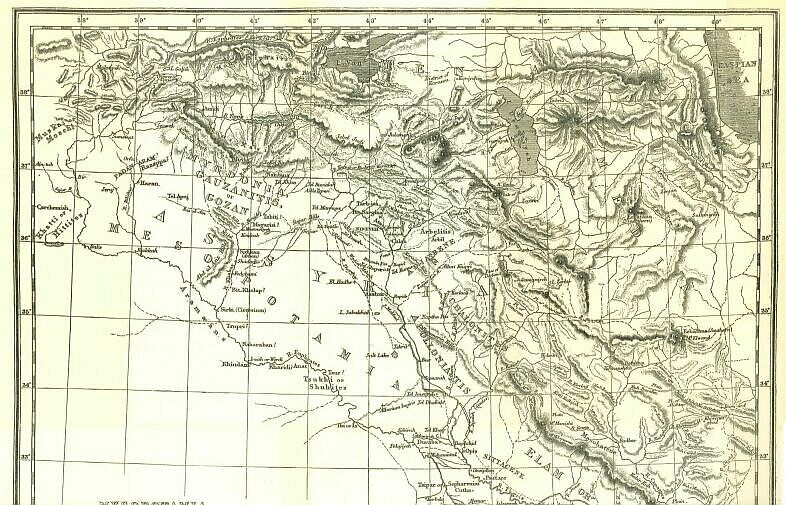
|
227. Chariot-wheel of the early period, Nimrud (from the original in the British Museum) 228. Chariot-wheel of the middle period, Koyunjik (ditto) 229. Chariot-wheel of the latest period, Koyunjik (ditto) 230. Ornamented ends of chariot poles, Nimrud and Koyunjik ditto 231. End of pole, with cross-bar, Khorsabad (after Botta 232. End of pole, with curved yoke, Koyunjik (after Layard) 233. End of pole, with elaborate cross-bar or yoke, Khorsabad (after Botta) 234. Assyrian chariot containing four warriors, Koyunjik (after Boutcher) 235. Assyrian war-chariot of the early period, Nimrud (from the original in the British Museum) 236. Assyrian war-chariot of the later period, Koyunjik (ditto) 237. Assyrian chariot of the transition period, Koyunjik (after Boutcher) 238. Assyrian chariot of the early period, Nimrud (from the original in the British Museum) 239. Chariot-horse protected by clothing, Koyunjik (ditto) 240. Head of a chariot-horse, showing collar with bells attached, Koyunjik(after Boutcher) 241. Bronze bit, Nimrud (from the original in the British Museum) 242. Bits of chariot-horses, from the sculptures, Nimrud and Koyunjik (ditto) 243. Driving-whips of Assyrian charioteers, from the sculptures (ditto) 244. Mode of tying horses' tails, Koyunjik (ditto) 245. Mounted spearmen of the time of Sargon, Khorsabad (after Botta) 246. Greave or laced boot of a horseman, Khorsabad (ditto) 248. Horse archer of the latest period, Koyunjik (from the original in the British Museum) 247. Cavalry soldiers of the time of Sennacherib, Koyunjik (after Layard) 249. Ordinary sandal of the first period, Nimrud (ditto) 250. Convex shield of the first period, Nimrud (after Layard) 251. Foot spearmen of the first period, with wicker shield, Nimrud (from the original in the British Museum) 252. Foot archer with attendant, first period, Nimrud (ditto) 253. Foot archer of the lightest equipment, time of Sargon, Khorsabad (after Botta) 254. Foot archer of the intermediate equipment, with attendant, time of Sargon, Khorsabad (after Botta) 255. Foot archer of the heavy equipment, with attendant, time of Sargon, Khorsabad (ditto) 256. Foot spearman of the time of Sargon, Khorsabad (ditto) 257. Shield and greave of a spearman, Khorsabad (ditto) 258. Spear, with weight at the lower end, Khorsabad (ditto) 259. Sling, Koyunjik (from the original in the British Museum) 260. Foot archer of the heavy equipment, with attendant, time of Sennacherib, Koyunjik (ditto) 261. Foot archers of the second class, time of Sennacherib, Koyunjik (ditto) 262. Belts and head-dress of a foot archer of the third class, time of Sennacherib, Koyunjik (after Boutcher) 263. Mode of carrying the quiver, time of Sennacherib, Koyunjik (from the original in the British Museum) 264. Foot archers of the lightest equipment, time of Sennacherib, Koyunjik 266. Wicker shields, time of Sennacherib, Koyunjik (from the originals in the British Museum) 267. Metal shield of the latest period, Koyunjik (ditto) 268. Slinger, time of Asshur-bani-pal, Koyunjik (after Boutcher) 269. Pointed helmet, with curtain of scales, Nimrud (after Layard) 270. Iron helmet, from Koyunjik, now in the British Museum (by the Author) 271. Assyrian crested helmets, from the bas-reliefs, Khorsabad and Koyunjik (from the originals in the British Museum) 272. Scale, Egyptian (after Sir G. Wilkinson) 273. Arrangement of scales in Assyrian scale-armour of the second period, Khorsabad (after Botta) 274. Sleeve of a coat of mail-scale-armor of the first period, Nimrud (from the original in the British Museum) 275. Assyrian gerrha, or large wicker shields (ditto) 276. Soldier undermining a wall, sheltered by gerrhon, Koyunjik (ditto) 277. Round shields or targes, patterned, Khorsabad (after Botta) 278. Convex shields with teeth, Nimrud (from the originals in the British Museum) 279. Egyptian convex shield, worn on back (after Sir G. Wilkinson) 280. Assyrian ditto, Koyunjik (from the original in the British Museum 281. Assyrian convex shield, resembling the Greek, Koyunjik (ditto) 282. Quiver, with arrows and javelin, Nimrud (ditto) 283. Ornamented end of bow, Khorsabad (after Botta) 284. Stringing the bow, Koyunjik (from the original in the British Museum) 285. Assyrian curved bow (ditto) 286. Assyrian angular bow, Khorsabad (after Botta) 287. Mode of carrying the bow in a bow-case, Koyunjik (from the original in the British Museum) 288. Peculiar mode of carrying the quiver, Koyunjik (ditto) 289. Quiver, with rich ornamentation, Nimrud (after Layard) 290. Quivers of the ordinary character, Koyunjik (from the originals in the British Museum) 291. Quiver with projecting rod, Khorsabad (after Botta) 292. Assyrian covered quivers, Koyunjik (from the originals in the British Museum) 293. Bronze arrow-heads, Nimrud and Koyunjik (ditto) 294. Flint arrow-brad; Nimrud (ditto) 295. Assyrian arrow (ditto) 296. Mode of drawing the bow, Koyunjik (after Boutcher) 297. Guard worn by an archer, Koyunjik (ditto) 298. Bronze spear-head, Nimrud (from the original in the British Museum) 299. Spear-heads (from the Sculptures) 300. Ornamented ends of spear-shafts, Nimrud (after Layard) 301. Ornamented handle of short sword, Khorsabad (after Botta) 302. Sheathed sword, Koyunjik (after Boutcher) 303. Ornamented handle of longer sword, Nimrud (from the original in the British Museum? 304. Assyrian curved sword, Khorsabad (after Botta) 308. Scythian battle-axe (after Tester) 309. Ornamented handles of daggers, Nimrud (after Layard) 310. Handle of dagger, with chain, Nimrud (ditto) 305. Head of royal mace, Khorsabad (ditto) 306. Maces, from the Sculptures 307. Assyrian battle-axes, Koyunjik (from the originals in the British Museum) 311. Sheaths of daggers, Nimrud 312. Assyrian standard, Khorsabad (after Botta) 313. Soldier swimming a river, Koyunjik (after Layard) 314. Royal tent, Koyunjik (from the original in the British Museum) 315. Ordinary tent, Koyunjik (after Boutcher) 316. Interior of tent, Koyunjik (ditto) 317. King walking in a mountainous country, chariot following, supported by men, Koyunjik (from an obelisk in the British Museum, after Boutcher) 318. Fortified place belonging to an enemy of the Assyrians, Nimrud (after Layard) 319. Gateway of castle, Koyunjik (after Boutcher) 320. Battering-rams, Khorsabad and Koyunjik (partly after Botta) 322. Crowbar, and mining the wall, Koyunjik (ditto) 321. Assyrian balistce, Nimrud (after Layard) 324. Soldiers destroying date-palms, Koyunjik (after Layard) 325. Soldier carrying off spoil from a temple, Khorsabad (after Botta) 326. Scribes taking account of the spoil, Khorsabad (ditto) 327. Mace-bearer, with attendant, executing a prisoner, Koyunjtk (from the original in the British Museum) 323. Implement used in the destruction of cities, Khorsabad (after Botta) 328. Swordsman decapitating a prisoner, Koyunjik (ditto) 329. Female captives, with children, Koyunjik (after Layard) 330. Chasuble or outer garment of the king (chiefly after Botta) 331. King in his robes, Khorsabad (after Botta) 332. Tiaras of the later and earlier Periods, Koyunjik and Nimrud (Layard and Boutcher) 333. Fillet worn by the king, Nimrud (after Layard) 334. Royal sandals, times of Sargon and Asshur-izir-pal (from the originals in the British Museum) 335. Royal shoe, time of Sennacherib, Koyunjik (ditto) 336. Royal necklace, Nimrud (ditto) 337. Royal collar, Nimrud (ditto) 338. Royal armlets, Khorsabad (after Botta) 339. Royal bracelets, Khorsabad and Koyunjik (after Botta and Boutcher) 340. Royal ear-rings, Nimrud (from the originals in the British Museum) 341. Early king in his war-costume, Nimrud (ditto) 342. King, queen, and attendants, Koyunjik (ditto) 343. Enlarged figure of the queen, Koyunjik (ditto) 345. Heads of eunuchs, Nimrud (ditto) 344. Royal parasols, Nimrud and Koyunjik (ditto) 316. The chief eunuch, Nimrud (ditto) 347. Head-dress of the vizier, Khorsabad (after Botta) 348. Costumes of the vizier, times of Sennacherib and Asshur-izir-pal, Nimrud and Koyunjik (from the originals in the British Museum) 349. Tribute-bearers presented by the chief eunuch, Nimrud obelisk (ditto) 350. Fans or fly-flappers, Nimrud and Koyunjik 351. King killing a lion, Nimrud (after Layard) 352. King, with attendants, spearing a lion, Koyunjik (after Boutcher) 353. King, with attendant, stabbing a lion, Koyunjik (ditto) 354. Lion let out of trap, Koyunjik (ditto) 355. Hound held in leash, Koyunjik (from the original in the British Museum) 356. Wounded lioness, Koyunjik (ditto) 351. Fight of lion and bull, Nimrud (after Layard) 358. King hunting the wild bull, Nimrud (ditto) 359. King pouring libation over four dead lions, Koyunjik (from the original in the British Museum) 360. Hound chasing a wild ass colt, Koyunjik (after Boutcher) 361. Dead wild ass, Koyunjik (ditto) 362. Hounds pulling down a wild ass, Koyunjik (ditto) 563. Wild ass taken with a rope, Koyunjik (from the original in the British Museum) 364. Hound chasing a doe, Koyunjik (after Boutcher) 365. Hunted stag taking the water, Koyunjik (ditto) 366. Net spread to take deer, Koyunjik (from the original in the British Museum) 367. Portion of net showing the arrangement of the meshes and the pegs, Koyunjik (ditto) 368. Hunted ibex, flying at full speed. Koyunjik (after Boutcher) 369. Ibex transfixed with arrow-falling (ditto) 370. Sportsman carrying a, gazelle, Khorsabad (from the original in the British Museum) 371. Sportsman shooting, Khorsabad (after Bntta) 372. Greyhound and hare, Niunrud (from a bronze bowl in the British Museum) 373. Nets, pegs, and balls of string, Koyunjik (after Boutcher) 374. Man fishing, Nimrud (after Layard) 375. Man fishing, Koyunjik (ditto) 376. Man fishing, seated on skin, Koyunjik (from the original in the British Museum) 377. Bear standing, Nimrud (from a bronze bowl in the British Museum) 378. Ancient Assyrian harp and harper, Nimrud (from the originals in the British Museum) 330. Triangular lyre, Koyunjik (ditto) 379. Later Assyrian harps and harpers, Koyunjik (ditto) 381. Lyre with ten strings, Khorsabad (after Botta) 382. Lyres with five and seven strings, Koyunjik (from the originals in the British Museurn) 383. Guitar or tamboura, Koyunjik (ditto) 384. Player on the double pipe. Koyunjik (ditto) 385. Tambourine player and other musicians, Koyunjik (ditto) 387. Assyrian tubbuls, or drums, Koyunjik (from the originals in the British Museum) 386. Eunuch playing on the cymbals, Koyunjik (after Boutcher) 388. Musician playing the dulcimer, Koyunjik (ditto) 389. Roman trumpet (Column of Trajan) 390. Assyrian ditto, Koyunjik (after Layard) 391. Portion of an Assyrian trumpet (from the original in the British Museum) 392. Captives playing on lyres, Koyunjik (ditto) 333. Lyre on a Hebrew coin (ditto) 394. Baud of twenty-six musicians, Koyunjik (ditto) 395. Time-keepers, Koyunjik (after Boutcher) 396. Assyrian coracle, Nimrud (from the original in the British Museum) 397. Common oar, time of Sennacherib, Koyunjik (ditto) 398. Steering oar, time of Asshur-izir-pal, Nimrud (ditto) 399. Early long boat, Nimrud (ditto) 400. Later long boat, Khorsabad (after Botta) 401. Phoenician bireme, Koyunjik (after Layard) 402. Oar kept in place by pegs, Koyunjik (from the original in the British Museum) 403. Chart of the district about Nimrud, showing the course of the ancient canal and conduit (after the survey of Captain Jones) 404. Assyrian drill-plough (from Lori Aberdeen's black stone, after Fergusson. 405. Modern Turkish plough (after Sir C. Fellows) 406. Modern Arab plough (after C. Niebuhr) 407. Ornamental belt or girdle, Koyunjik (from the original in the British Museum) 408. Ornamental cross-belt, Khorsabad (after Botta) 409. Armlets of Assyrian grandees, Khorsabad (ditto) 410. Head-dresses of various officials, Koyunjik (from the originals in the British Musemn) 411. Curious mode of arranging the hair, Koyunjik (from the originals in the British Museum) 412. Female seated (from an ivory in the British Museum) 413. Females gathering grapes (from some ivory fragments in the British Museum) 414. Necklace of flat glass beads (from the original in the British Museum) 415. Metal mirror (ditto) 416. Combs in iron and lapis lazuli (from the original in the British Museum) 417. Assyrian joints of meat (from the Sculptures) 418. Killing the sheep, Koyunjik (after Boutcher) 419. Cooking meat in caldron, Koyunjik (after Layard) 420. Frying, Nimrud (from the original in the British Museum) 421. Assyrian fruits (from the Monuments) 422. Drinking scene, Khorsabad (after Botta) 423. Ornamental wine-cup, Khorsabad (ditto) 424. Attendant bringing flowers to a banquet, Koyunjik (after Layard) 425. Socket of hinge, Nimrud (ditto) |

"Whose arrows are sharp, and all their bows bent, their horses' hoofs shall be counted like flint, and their wheels like a whirlwind."—ISA. v. 28.
In reviewing, so far as our materials permit, the manners and customs of the Assyrians, it will be convenient to consider separately their warlike and their peaceful usages. The sculptures furnish very full illustration of the former, while on the latter they throw light far more sparingly.
The Assyrians fought in chariots, on horseback, and on foot. Like most ancient nations, as the Egyptians, the Greeks in the heroic times, the Canaanites, the Syrians, the Jews and Israelites, the Persians, the Gauls, the Britons, and many others, the Assyrians preferred the chariot as most honorable, and probably as most safe. The king invariably went out to war in a chariot, and always fought from it, excepting at the siege of a town, when he occasionally dismounted and shot his arrows on foot. The chief state-officers and other personages of high rank followed the same practice. Inferior persons served either as cavalry or as foot-soldiers.
The Assyrian war-chariot is thought to have been made of wood. Like the Greek and the Egyptian, it appears to have been mounted from behind where it was completely open, or closed only by means of a shield, which (as it seems) could be hung across the aperture. It was completely panelled at the sides, and often highly ornamented, as will be seen from the various illustrations given in this chapter. The wheels were two in number, and were placed far back, at or very near the extreme end of the body, so that the weight pressed considerably upon the pole, as was the case also in Egypt. They had remarkably broad felloes, thin and delicate spokes, and small or moderate sized axels. [PLATE LXXXIX. Fig. 2], and [PLATE XC., Figs. 1, 2.] The number of the spokes was either six or eight. The felloes appear to have been formed of three distinct circles of wood, the middle one being the thinnest, and the outer one far the thickest of the three. Sometimes these circles were fastened together externally by bands of mental, hatchet-shaped. In one or two instances we find the outermost circle divided by cross-bars, as if it had been composed of four different pieces. Occasionally there is a fourth circle, which seems to represent a metal tire outside the felloe, whereby it was guarded from injury. This tire is either plain or ornamented.
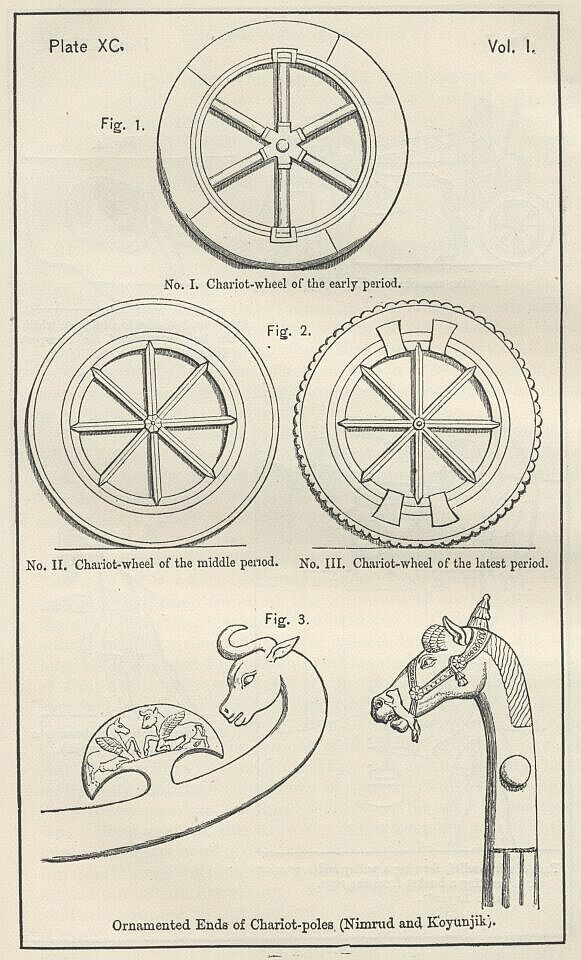
The wheels were attached to an axletree, about which they revolved, in the usual manner. The body was placed directly upon the axletree and upon the pole, without the intervention of any springs. The pole started from the middle of the axle-tree, and, passing below the floor of the body in a horizontal direction, thence commonly curved upwards till it had risen to about half the height of the body, when it was again horizontal for awhile, once more curving upwards at the end. It usually terminated in an ornament, which was sometimes the head of an animal—a bull, a horse, or a duck—sometimes a more elaborate and complicated work of art. [PLATE XC., Fig. 3.] Now and then the pole continued level with the bottom of the body till it had reached its full projection, and then rose suddenly to the height of the top of the chariot. It was often strengthened by one or more thin bars, probably of metal; which united it to the upper part of the chariot-front.
Chariots were drawn either by two or three, never by four, horses. They seem to have had but a single pole. Where three horses were used, one must therefore have been attached merely by a rope or thong, like the side horses of the Greeks, and, can scarcely have been of much service for drawing the vehicle. He seems rightly regarded as a supernumerary, intended to take the place of one of the others, should either be disabled by a wound or accident. It is not easy to determine from the sculptures how the two draught horses were attached to the pole. Where chariots are represented without horses, we find indeed that they have always a cross-bar or yoke; but where horses are represented in the act of drawing a chariot, the cross-bar commonly disappears altogether. It would seem that the Assyrian artists, despairing of their ability to represent the yoke properly when it was presented to the eye end-wise, preferred, for the most part, suppressing it wholly to rendering it in an unsatisfactory manner. Probably a yoke did really in every case pass over the shoulders of the two draught horses, and was fastened by straps to the collar which is always seen round their necks.
These yokes, or cross-bars, were of various kinds. Sometimes they appear to have consisted of a mere slight circular bar, probably of metal, which passed through the pole; sometimes of a thicker spar, through which the pole itself passed. In this latter case the extremities were occasionally adorned with heads of animals. [PLATE XCI., Fig. 1.] The most common kind of yoke exhibits a double curve, so as to resemble a species of bow unstrung. [PLATE XCI., Fig. 2.] Now and then a specimen is found very curiously complicated, being formed of a bar curved strongly at either end, and exhibiting along its course four other distinct curvatures having opposite to there apertures resembling eyes, with an upper and a lower eyelid. [PLATE XCI., Fig. 3.] It has been suggested that this yoke belonged to a four-horse chariot, and that to each of the four eyes (a a a a) there was a steed attached; but, as no representation of a four-horse chariot has been found, this suggestion must be regarded as inadmissible. The probability seems to be that this yoke, like the others, was for two horses, on whose necks it rested at the points marked b b, the apertures (c c c c) lying thus on either side of the animals' necks, and furnishing the means whereby the he was fastened to the collar. It is just possible that we have in the sculptures of the later period a representation of the extremities (d d) of this kind of yoke, since in them a curious curve appears sometimes on the necks of chariot-horses, just above the upper end of the collar.
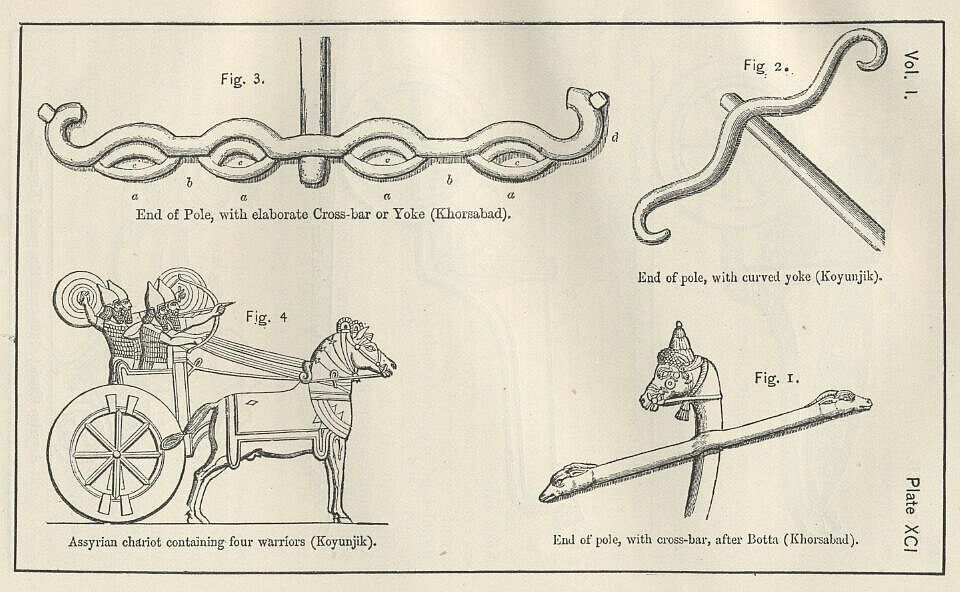
Assyrian chariots are exceedingly short: but, apparently, they must have been of a considerable width. They contain two persons at the least; and this number is often increased to three, and sometimes even to four. [PLATE XCI. Fig. 4.] The warrior who fights from a chariot is necessarily attended by his charioteer; and where he is a king, or a personage of high importance, he is accompanied by a second attendant, who in battle-scenes always bears a shield, with which he guards the person of his master. Sometimes, though rarely, four persons are seen in a chariot—the king or chief, the charioteer, and two guards, who protect the monarch on either side with circular shields or targes. The charioteer is always stationed by the side of the warrior, not as frequently with the Greeks, behind him. The guards stand behind, and, owing to the shortness of the chariot, must have experienced some difficulty in keeping their places. They are evidently forced to lean back-wards from want of room, and would probably have often fallen out, had they not grasped with one hand a rope or strap firmly fixed to the front of the vehicle.
There are two principal types of chariots in the Assyrian sculptures, which may be distinguished as the earlier and the later. The earlier are comparatively low and short. The wheels are six-spoked, and of small diameter. The body is plain, or only ornamented by a border, and is rounded in front, like the Egyptian and the classical chariots. [PLATE XCII., Fig 1.] Two quivers are suspended diagonally at the side of the body, while a rest for a spear, commonly fashioned into the shape of a human head, occupies the upper corner at the back. From the front of the body to the further end of the pole, which is generally patterned and terminates in the head and neck of a ball or a duck, extends an ornamented structure, thought to have been of linen or silk stitched upon a framework of wood, which is very conspicuous in the representation. A shield commonly hangs behind these chariots, perhaps closing the entrance; and a standard is sometimes fixed in them towards the front, connected with the end of the pole by a rope or bar.
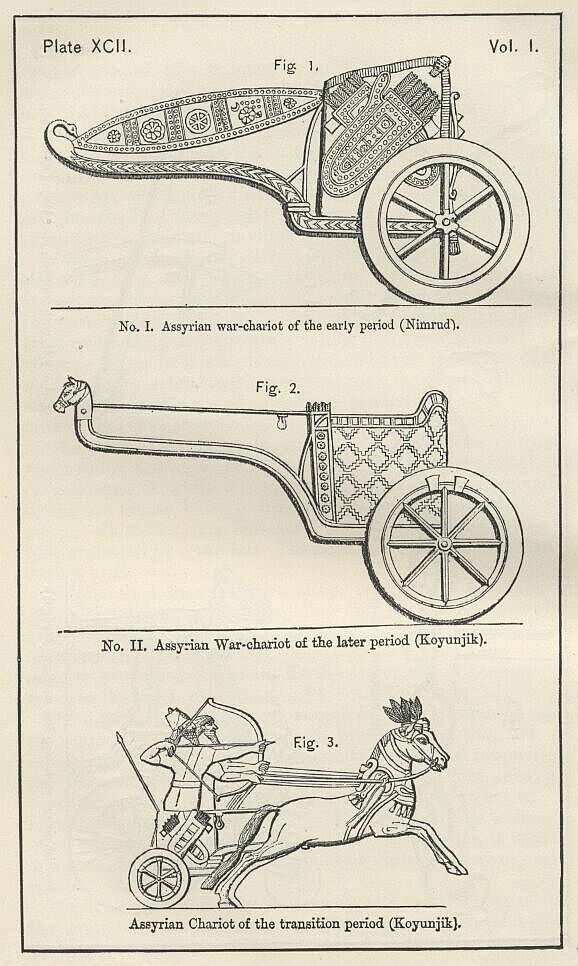
The later chariots are loftier and altogether larger than the earlier. The wheel is eight spoked, and reaches as high as the shoulders of the horses, which implies a diameter of about five feet. [PLATE XCII., Fig. 2. ] The body rises a foot or rather more, above this; and the riders thus from their elevated position command the whole battle-field. The body is not rounded, but made square in front: it has no quivers attached to it externally, but has, instead, a projection at one or both of the corners which seems to have served as an arrow-case. This projection is commonly patterned, as is in many cases the entire body of the chariot, though sometimes the ornamentation is confined to an elegant but somewhat scanty border. The poles are plain, not patterned, sometimes, however, terminating in the head of a horse; there is no ornamental framework connecting them with the chariot, but in its stead we see a thin bar, attached to which, either above or below, there is in most instances a loop, whereto we may suppose that the reins were occasionally fastened. No shield is suspended behind these chariots; but we sometimes observe an embroidered drapery hanging over the back, in a way which would seem to imply that they were closed behind, at any rate by a cross-bar.
The trappings of the chariot-horses belonging to the two periods are not very different. They consist principally of a headstall, a collar, a breast-ornament, and a sort of huge tassel pendent at the horse's side. The headstall was formed commonly of three straps: one was attached to the bit at either end, and passed behind the ears over the neck; another, which was joined to this above, encircled the smallest part of the neck; while a third, crossing the first at right angles, was carried round the forehead and the cheek bones. At the point where the first and second joined, or a little in front of this, rose frequently a waving plume, or a crest composed of three huge tassels, one above another; while at the intersection of the second and third was placed a rosette or other suitable ornament. The first strap was divided where it approached the bit into two or three smaller straps, which were attached to the bit in different places. A fourth strap sometimes passed across the nose from the point where the first strap subdivided. All the straps were frequently patterned; the bit was sometimes shaped into an animal form and streamers occasional floated from the nodding plume or crest which crowned the heads of the war-steeds.
The collar is ordinarily represented as a mere broad band passing round the neck, not of the withers (as with ourselves). but considerably higher up, almost midway between the withers and the cheek-bone. Sometimes it is of uniform width while often it narrows greatly as it approaches the back of the neck. It is generally patterned, and appears to have been a mere flat leathern band. It is impossible to say in what exact way the pole was attached to it, though in the later sculptures we have elaborate representations of the fastening. The earlier sculptures seem to append to the collar one or more patterned straps, which, passing round the horse's belly immediately behind the fore legs, served to keep it in place, while at the same time they were probably regarded as ornamental; but under the later kings these belly Lands were either reduced to a single strap, or else dispensed with altogether.
The breast-ornament consists commonly of a fringe, more or less complicated. The simplest form, which is that of the most ancient times, exhibits a patterned strap with a single row of long tassels pendent from it, as in the annexed representation. At a later date we find a double and even a triple row of tassels.
The pendent side-ornament is a very conspicuous portion of the trappings. It is attached to the collar either by a long straight strap or by a circular band which falls on either side of the neck. The upper extremity is often shaped into the form of an animal's head, below which comes most commonly a circle or disk, ornamented with a rosette, a Maltese cross, a winged bull, or other sacred emblem, while below the circle hang huge tassels in a single row or smaller ones arranged in several rows. In the sculptures of Sargon at Khorsabad, the tassels of both the breast and side ornaments were colored, the tints being in most cases alternately red and blue.
Occasionally the chariot-horses were covered from the ears almost to the tail with rich cloths, magnificently embroidered over their whole surface.' [PLATE XCIII., Fig. 2.] These cloths encircled the neck, which they closely fitted, and, falling on either side of the body, were then kept in place by means of a broad strap round the rump and a girth under the belly.
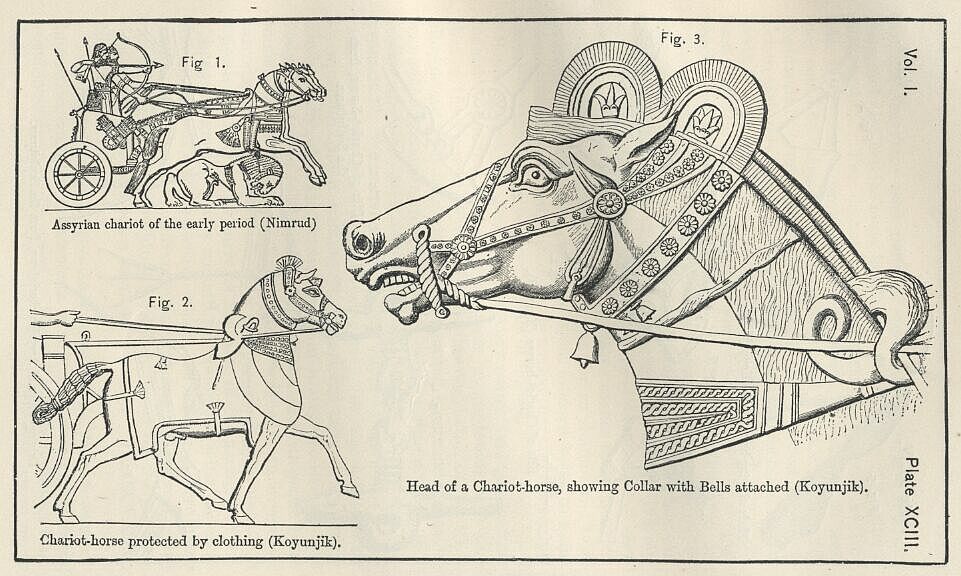
A simpler style of clothing chariot-horses is found towards the close of the later period, where we observe, below the collar, a sort of triple breastplate, and over the rest of the body a plain cloth, square cut, with flaps descending at the arms and quarters, which is secured in its place by three narrow straps fastened on externally. The earlier kind of clothing has the appearance of being for ornament but this looks as if it was meant solely for protection.
Besides the trappings already noticed, the Assyrian chariot-horses had frequently strings of beads suspended round their necks, between the ears and the collar; they had also, not unfrequently, tassels or bells attached to different parts of the headstall [PLATE XCIII., Fig. 3], and finally they had, in the later period most commonly, a curious ornament upon the forehead, which covered almost the whole space between the ears and the eyes, and was composed of a number of minute bosses, colored, like the tassels of the breast ornament, alternately red and blue.
Each horse appears to have been driven by two reins—one attached to either end of the bit in the ordinary manner, and each passed through a ring or loop in the harness, whereby the rein was kept down and a stronger purchase secured to the driver. The shape of the bit within the mouth, if we may judge by the single instance of an actual bit which remains to us, bore a near resemblance to the modern snaffle. [PLATE XCIV., Fig. 1.] Externally the bit was large, and in most cases clumsy—a sort of cross-bar extending across the whole side of the horse's face, commonly resembling a double axe-head, or a hammer. Occasionally the shape was varied, the hatchet or hammer being replaced by forms similar to those annexed, or by the figure of a horse at full gallop. The rein seems, in the early times, to have been attached about midway in the cross-bar, while afterwards it became usual to attach it near the lower end. This latter arrangement was probably found to increase the power of the driver.
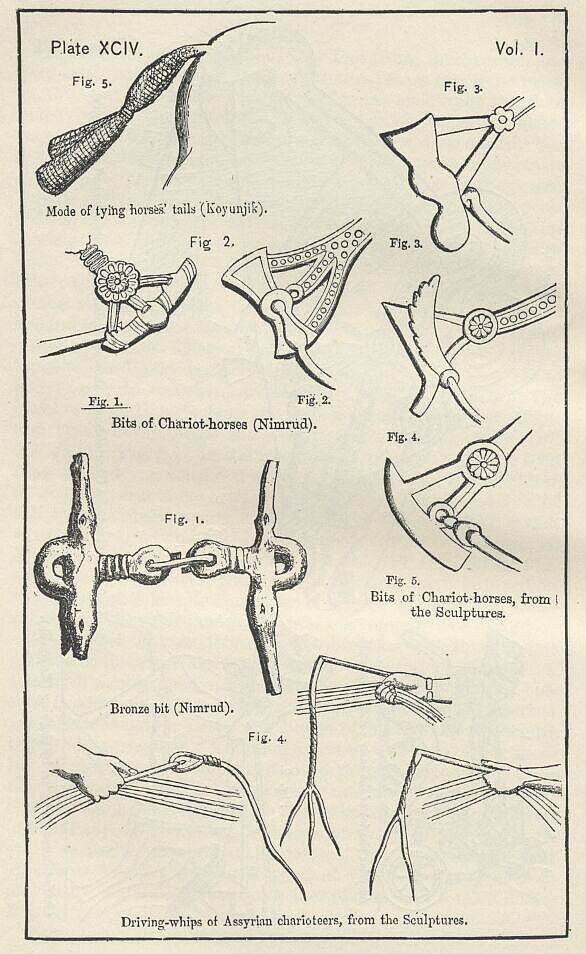
The use of the bearing-rein, which prevailed in Egypt, was unknown to the Assyrians, or disapproved by them. The driving-reins were separate, not stitched or buckled together, and were held in the two hands separately. The right hand grasped the reins, whatever their number, which were attached at the horses' right cheeks, while the left hand performed the same office with the remaining reins. The charioteer urged his horses onward with a powerful whip, having a short handle, and a thick plaited or twisted lash, attached like the lash of a modern horsewhip, sometimes with, sometimes without, a loop, and often subdivided at the end into two or three tails. [PLATE XCIV., Fig. 4.]
Chariot-horses were trained to three paces, a walk, a trot, and a gallop. In battle-pieces they are commonly represented at full speed, in marches trotting, in processions walking in a stately manner. Their manes were frequently hogged, though more commonly they lay on the neck, falling (apparently) upon either side indifferently. Occasionally a portion only was hogged, while the greater part remained in its natural condition. The tail was uncut, and generally almost swept the ground, but was confined by a string or ribbon tied tightly around it about midway. Sometimes, more especially in the later sculptures, the lower half of the tail is plaited and tied up into a loop or bunch [PLATE XCIV., Fig. 5], according to the fashion which prevails in the present day through most parts of Turkey and Persia.
The warrior who fought from a chariot was sometimes merely dressed in a tunic, confined at the waist by a belt; sometimes, however, he wore a coat of mail, very like the Egyptian, consisting of a sort of shirt covered with small plates or scales of metal. This shirt reached at least as low as the knees, beneath which the chariot itself was sufficient protection. It had short sleeves, which covered the shoulder and upper part of the arm, but left the elbow and fore-arm quite undefended. The chief weapon of the warrior was the bow, which is always seen in his hands, usually with the arrow upon the string; he wears, besides, a short sword, suspended at his left side by a strap, and he has commonly a spear within his reach; but we never see him using either of these weapons. He either discharges his arrows against the foe from the standing-board of his chariot, or, commanding the charioteer to halt, descends, and, advancing a few steps before his horses' heads, takes a surer and more deadly aim from terra firma. In this case his attendant defends him from missiles by extending in front of him a shield, which he holds in his left hand, while at the same time he makes ready to repel any close assailant by means of a spear or sword grasped firmly in his right. The warrior's face and arms are always bare; sometimes the entire head is undefended, though more commonly it has the protection of a helmet. This, however, is without a visor, and does not often so much as cover the ears. In some few instances only is it furnished with flaps or lappets, which, where they exist, seem to be made of metal scales, and, falling over the shoulders, entirely conceal the ears, the back of the head, the neck, and even the chin.
The position occupied by chariots in the military system of Assyria is indicated in several passages of Scripture, and distinctly noticed by many of the classical writers. When Isaiah began to warn his countrymen of the 'miseries in store for them at the hands of the new enemy which first attacked Judea in his day, he described them as a people "whose arrows were sharp, and all their bows bent, whose horses' hoofs should be counted like flint, and their wheels like a whirlwind." When in after days he was commissioned to raise their drooping courage by assuring them that they would escape Sennacherib, who had angered God by his pride, he noticed, as one special provocation of Jehovah, that monarch's confidence in the multitude of his chariots. Nahum again, having to denounce the approaching downfall of the haughty nation, declares that God is "against her, and will burn her chariots in the smoke." In the fabulous account which Ctesias gave of the origin of Assyrian greatness, the war-chariots of Ninus were represented as amounting to nearly eleven thousand, while those of his wife and successor, Semiramis, were estimated at the extravagant number of a hundred thousand. Ctesias further stated that the Assyrian chariots, even at this early period, were armed with scythes, a statement contradicted by Xenophon, who ascribes this invention to the Persians, and one which receives no confirmation from the monuments. Amid all this exaggeration and inventiveness, one may still trace a knowledge of the fact that war-chariots were highly esteemed by the Assyrians from a very ancient date, while from other notices we may gather that they continued to be reckoned an important arm of the military service to the very end of the empire.
Next to the war-chariots of the Assyrians we must place their cavalry, which seems to have been of scarcely less importance in their wars. Ctesias, who amid all his exaggerations shows glimpses of some real knowledge of the ancient condition of the Assyrian people, makes the number of the horsemen in their armies always greatly exceed that of the chariots. The writer of the book of Judith gives Holofernes 12,000 horse-archers, and Ezekiel seems to speak of all the "desirable young men" as "horsemen riding upon horses." The sculptures show on the whole a considerable excess of cavalry over chariots, though the preponderance is not uniformly exhibited throughout the different periods.
During the time of the Upper dynasty, cavalry appears to have been but little used. Tiglath-Pileser I. in the whole of his long Inscription has not a single mention of them, though he speaks of his chariots continually. In the sculptures of Asshur-izir-pal, the father of the Black-Obelisk king, while chariots abound, horsemen occur only in rare instances. Afterwards, under Sargon and Sennacherib, we notice a great change in this respect. The chariot comes to be almost confined to the king, while horsemen are frequent in the battle scenes.
In the first period the horses' trappings consisted of a head-stall, a collar, and one or more strings of beads. The head-stall was somewhat heavy, closely resembling that of the chariot-horses of the time, representations of which have been already given. It had the same heavy axe-shaped bit, the same arrangement of straps, and nearly the same ornamentation. The only marked difference was the omission of the crest or plume, with its occasional accompaniment of streamers. The collar was very peculiar. It consisted of a broad flap, probably of leather, shaped almost like a half-moon, which was placed on the neck about half way between the ears and the withers, and thence depended over the breast, where it was broadened out and ornamented by large drooping tassels. Occasionally the collar was plain, but more often it was elaborately patterned. Sometimes pomegranates hung from it, alternating with the tassels.
The cavalry soldiers of this period ride without any saddle. Their legs and feet are bare, and their seat is very remarkable. Instead of allowing their legs to hang naturally down the horses' sides, they draw them up till their knees are on a level with their chargers' backs, the object (apparently) being to obtain a firm seat by pressing the base of the horse's neck between the two knees. The naked legs seem to indicate that it was found necessary to obtain the fullest and freest play of the muscles to escape the inconveniences of a fall.
The chief weapon of the cavalry at this time is the bow. Sword and shield indeed are worn, but in no instance do we see them used. Cavalry soldiers are either archers or mere attendants who are without weapons of offence. One of these latter accompanies each horse-archer in battle, for the purpose of holding and guiding his steed while he discharges his arrows. The attendant wears a skull cap and a plain tunic, the archer has an embroidered tunic, a belt to which his sword is attached, and one of the ordinary pointed helmets.
In the second period the cavalry consists in part of archers, in part of spearmen. Unarmed attendants are no longer found, both spearmen and archers appearing to be able to manage their own horses. Saddles have now come into common use: they consist of a simple cloth, or flap of leather, which is either cut square, or shaped somewhat like the saddle-cloths of our own cavalry. A single girth beneath the belly is their ordinary fastening; but sometimes they are further secured by means of a strap or band passed round the breast, and a few instances occur of a second strap passed round the quarters. The breast-strap is generally of a highly ornamented character. The headstall of this period is not unlike the earlier one, from which it differs chiefly in having a crest, and also a forehead ornament composed of a number of small bosses. It has likewise commonly a strap across the nose, but none under the cheek-bones. It is often richly ornamented, particularly with rosettes, bells, and tassels.
The old pendent collar is replaced by one encircling the neck about halfway up, or is sometimes dispensed with altogether. Where it occurs, it is generally of uniform width, and is ornamented with rosettes or tassels. No conjecture has been formed of any use which either form of collar could serve; and the probability is that they were intended solely for ornament.
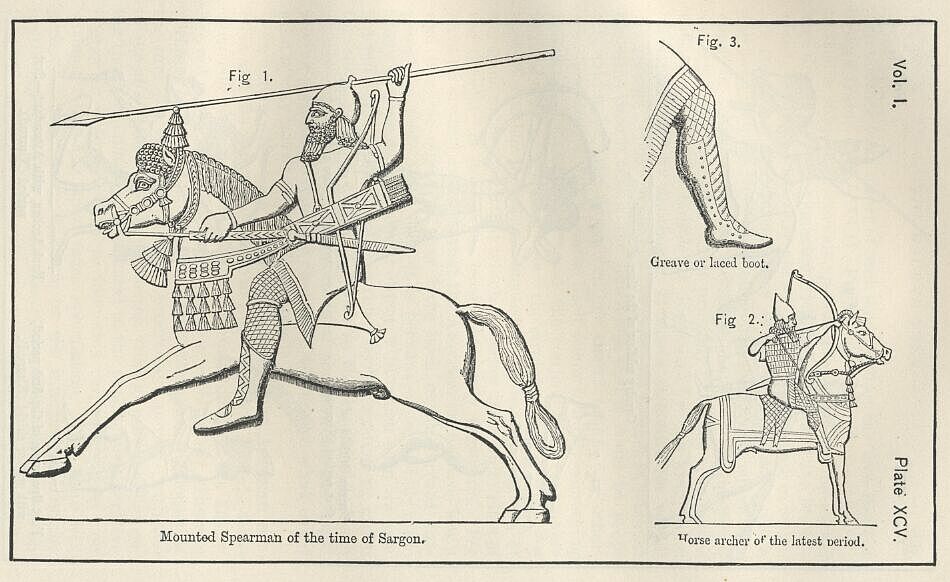
A great change is observable in the sculptures of the second period with respect to the dress of the riders. [PLATE XCV., Fig. 1.] The cavalry soldier is now completely clothed, with the exception of his two arms, which are bare from a little below the shoulder. He wears most commonly a tunic which fits him closely about the body, but below the waist expands into a loose kilt or petticoat, very much longer behind than in front, which is sometimes patterned, and always terminates in a fringe. Round his waist he has a broad belt; and another, of inferior width, from which a sword hangs, passes over his left shoulder. His legs are encased in a close-fitting pantaloon or trouser, over which he wears a laced boot or greave, which generally reaches nearly to the knee, though sometimes it only covers about half the calf. [PLATE XCV., Fig. 2.] This costume, which is first found in the time of Sargon, and continues to the reign of Asshur-bani-pal, Esarhaddon's son, may probably be regarded as the regular cavalry uniform under the monarchs of the Lower Empire. In Sennacherib's reign there is found in conjunction with it another costume, which is unknown to the earlier sculptures. This consists of a dress closely fitting the whole body, composed apparently of a coat of mail, leather or felt breeches, and a high greave or jack boot. [PLATE XCVI., Fig. 1.] The wearers of this costume are spearmen or archers indifferently. The former carry a long weapon, which has generally a rather small head, and is grasped low down the shaft. The bow of the latter is either round-arched or angular, and seems to be not more than four feet in length; the arrows measure less than three feet, and are slung in a quiver at the archer's back. Both spearmen and archers commonly carry swords, which are hung on the left side, in a diagonal, and sometimes nearly in a horizontal position. In some few cases the spearman is also an archer, and carries his bow on his right arm, apparently as a reserve in case he should break or lose his spear.

The seat of the horseman is far more graceful in the second than in the first period his limbs appear to move freely, and his mastery over his horse is such that he needs no attendant. The spearman holds the bridle in his left hand; the archer boldly lays it upon the neck of his steed, who is trained either to continue his charge, or to stand firm while a steady aim is taken. [PLATE XCV., Fig. 3.]
In the sculptures of the son and successor of Esarhaddon, the horses of the cavalry carry not unfrequently, in addition to the ordinary saddle or pad, a large cloth nearly similar to that worn sometimes by chariot-horses, of which a representation has been already given. It is cut square with two drooping lappets, and covers the greater part of the body. Occasionally it is united to a sort of breastplate which protects the neck, descending about halfway clown the chest. The material may be supposed to have been thick felt or leather, either of which would have been a considerable protection against weapons.
While the cavalry and the chariots were regarded as the most important portions of the military force, and were the favorite services with the rich and powerful, there is still abundant reason to believe that Assyrian armies, like most others, consisted mainly of foot. Ctesias gives Minis 1,700,000 footmen to 210,000 horsemen, and 10,600 chariots. Xenophon contrasts the multitude of the Assyrian infantry with the comparatively scanty numbers of the other two services: Herodotus makes the Assyrians serve in the army of Xerxes on foot only. The author of the book of Judith assigns to Holofernes an infantry force ten times as numerous as his cavalry.—The Assyrian monuments entirely bear out the general truth involved in all these assertions, showing us, as they do, at least ten Assyrian warriors on foot for each one mounted on horseback, and at least a hundred for each one who rides in a chariot. However terrible to the foes of the Assyrians may have been the shock of their chariots and the impetuosity of their horsemen, it was probably to the solidity of the infantry, to their valor, equipment, and discipline, that the empire was mainly indebted for its long series of victories.
In the time of the earliest sculptures, all the Assyrian foot-soldiers seem to have worn nearly the same costume. This consisted of a short tunic, not quite reaching to the knees, confined round the waist by a broad belt, fringed, and generally opening in front, together with a pointed helmet, probably of metal. The arms, legs, neck, and even the feet, were ordinarily bare, although these last had sometimes the protection of a very simple sandal. [PLATE XCVI., Fig. 2.] Swordsmen used a small straight sword or dagger which they wore at their left side in an ornamented sheath, and a shield which was either convex and probably of metal, or oblong-square and composed of wickerwork. [PLATE XCVI., Fig. 2.] Spearmen had shields of a similar shape and construction, and carried in their right hands a short pike or javelin, certainly not exceeding five feet in length. [PLATE XCVI., Fig. 4.] Sometimes, but not always, they carried, besides the pike, a short sword. Archers had rounded bows about four feet in length, and arrows a little more than three feet long. Their quivers, which were often highly ornamented, hung at their backs, either over the right or over the left shoulder. [PLATE XCVI., Fig. 4.] They had swords suspended at their left sides by a cross-belt, and often carried maces, probably of bronze or iron, which bore a rosette or other ornament at one end, and a ring or strap at the other. The tunics of archers were sometimes elaborately embroidered; and on the whole they seem to have been regarded as the flower of the foot-soldiery. Generally they are represented in pairs, the two being in most cases armed and equipped alike; but, occasionally, one of the pair acts as guard while the other takes his aim. In this case both kneel on one knee, and the guard, advancing his long wicker shield, protects both himself and his comrade from missiles, while he has at the same time his sword drawn to repel all hand-to-hand assailants. [PLATE XCVII., Fig. 1.]
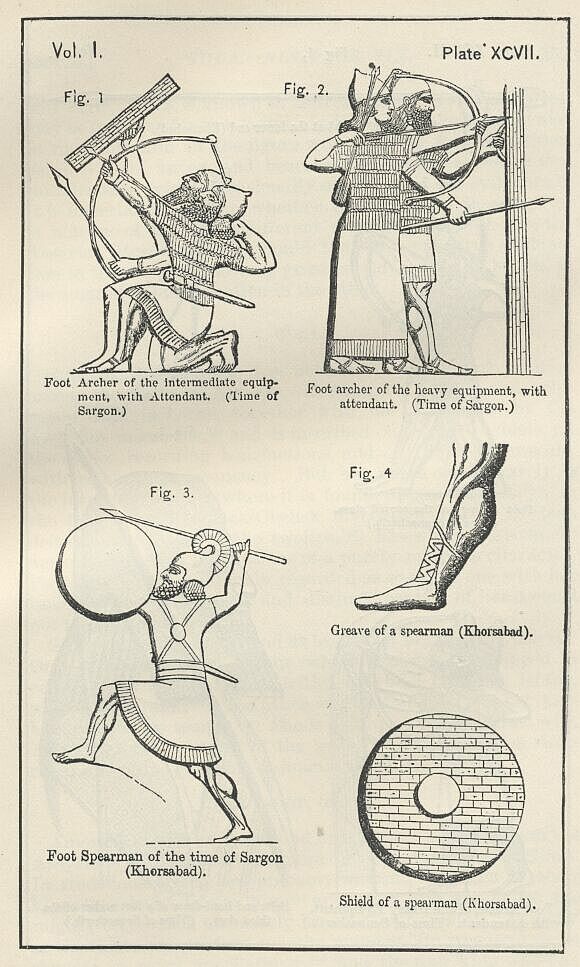
In the early part of the second period, which synchronizes with the reign of Sargon, the difference in the costumes of the foot-soldiers becomes much more marked. The Assyrian infantry now consists of two great classes, archers and spear-men. The archers are either light-armed or heavy-armed, and of the latter there are two clearly distinct varieties. The light-armed have no helmet, but wear on their heads a mere fillet or band, which is either plain or patterned. [PLATE XCVI., Fig. 3.] Except for a cross-belt which supports the quiver, they are wholly naked to the middle. Their only garment is a tunic of the scantiest dimensions, beginning at the waist, round which it is fastened by a broad belt or girdle, and descending little more than half-way down the thigh. In its make it sometimes closely resembles the tunic of the first period, but more often it has the peculiar pendent ornament which has been compared to the scotch phillibeg, and which will be here given that name. It is often patterned with squares and gradines. The light-armed archer has usually bare feet; occasionally, however, he wears the slight sandal of this period, which is little more than a cap for the heel held in place by two or three strings passed across the instep. There is nothing remarkable in his arms, which resemble those of the preceding period: but it may be observed that, while shooting, he frequently holds two arrows in his right hand besides that which is upon the string. He shoots either kneeling or standing, generally the latter. His ordinary position is in the van of battle, though sometimes a portion of the heavy-armed troops precede him. He has no shield, and is not protected by an attendant, thus running more risk than any of the rest of the army.
The more simply equipped of the heavy archers are clothed in a coat of mail, which reaches from their neck to their middle, and partially covers the arms. Below this they wear a fringed tunic reaching to the knees, and confined at the waist by a broad belt of the ordinary character. Their feet have in most instances the protection of a sandal, and they wear on their heads the common or pointed helmet. They usually discharge their arrows kneeling on the left knee, with the right foot advanced before them. Daring this operation they are protected by an attendant, who is sometimes dressed like themselves, sometimes merely clad a tunic, without a coat of mail. Like them, he wears a pointed helmet; and while in one hand he carries a spear, with the other he holds forward a shield, which is either of a round form—apparently, of metal embossed with figures—or oblong-square in shape, and evidently made of wickerwork. Archers of this class are the least common, and scarcely ever occur unless in combination with some of the class which has the heaviest equipment.
The principal characteristic of the third or most heavily armed class of archers is the long robe, richly fringed, which descends nearly to their feet, thus completely protecting all the lower part of their person. [PLATE XCVII., Fig. 2.] Above this they wear a coat of mail exactly resembling that of archers of the intermediate class, which is sometimes crossed by a belt ornamented with crossbars. Their head is covered by the usual pointed helmet, and their feet are always, or nearly always, protected by sandals. They are occasionally represented without either sword or quiver, but more usually they have a short sword at their left side, which appears to have been passed through their coat of mail, between the armor plates, and in a few instances they have also quivers at their backs. Where these are lacking, they generally either carry two extra arrows in their right hand, or have the same number borne for them by an attendant. They are never seen unattended: sometimes they have one, sometimes two attendants, who accompany them, and guard them from attack. One of these almost always bears the long wicker shield, called by the Greeks [_yeppov_] which he rests firmly upon the ground in front of himself and comrade. The other, where there is a second, stands a little in the rear, and guards the archer's head with a round shield or targe. Both attendants are dressed in a short tunic, a phillibeg, a belt, and a pointed helmet. Generally they wear also a coat of mail and sandals, like those of the archer. They carry swords at their left sides, and the principal attendant, except when he bears the archer's arrows, guards him from attack by holding in advance a short spear. The archers of this class never kneel, but always discharge their arrows standing. They seem to be regarded as the most important of the foot-soldiers, their services being more particularly valuable in the siege of fortified places.
The spearmen of this period are scarcely better armed than the second or intermediate class of archers. Except in very rare instances they have no coat of mail, and their tunic, which is either plain or covered with small squares, barely reaches to the knee. The most noticeable point about them is their helmet, which is never the common pointed or conical one, but is always surmounted by a crest of one kind or another. [PLATE XCVII.. Fig. 3.] Another very frequent peculiarity is the arrangement of their cross-belts, which meet on the back and breast, and are ornamented at the points of junction with a circular disk, probably of metal. The shield of the spearman is also circular, and is formed generally, if not always—of wickerwork, with (occasionally) a central boss of wood or metal. [PLATE XCVII., Fig. 4.] In most cases their legs are wholly bare; but sometimes they have sandals, while in one or two instances they wear a low boot or greave laced in front, and resembling that of the cavalry. [PLATE XCVII.. Fig. 4.] The spear with which they are armed varies in length, from about four to six feet. [PLATE XCVIII.. Fig. 1.] It is grasped near the lower extremity, at which a weight was sometimes attached, in order the better to preserve the balance. Besides this weapon they have the ordinary short sword. The spear-men play an important part in the Assyrian wars, particularly at sieges, where they always form the strength of the storming party.
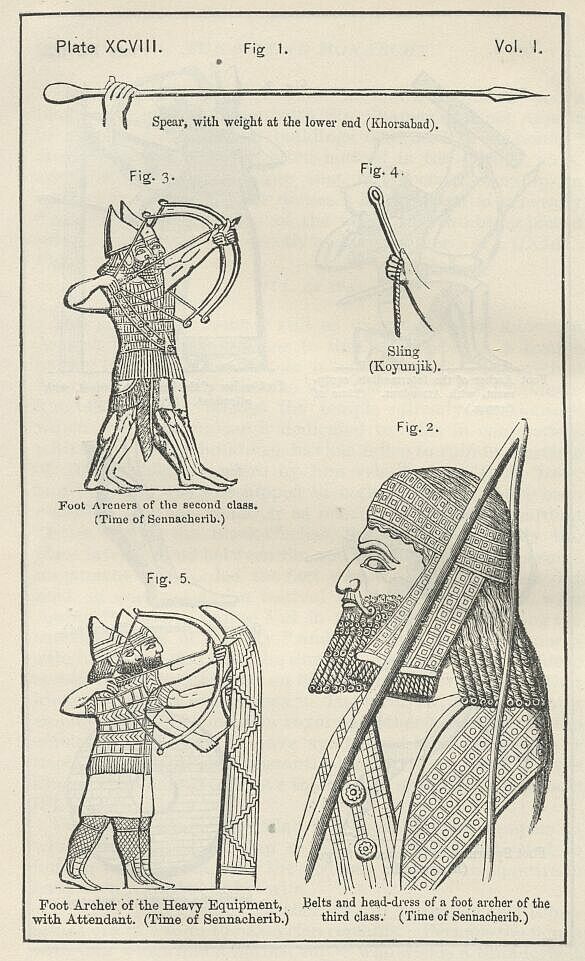
Some important changes seen to have been made under Sennacherib in the equipment and organization of the infantry force. These consisted chiefly in the establishment of a greater number of distinct corps differently armed, and in an improved equipment of the more important of them. Sennacherib appears to have been the first to institute a corps of slingers, who at any rate make their earliest appearance in his sculptures. They were kind of soldier well-known to the Egyptians and Sennacherib's acquaintance with the Egyptian warfare may have led to their introduction among the troops of Assyria. The slinger in most countries where his services were employed was lightly clad, and reckoned almost as a supernumerary. It is remarkable that in Assyria he is, at first, completely armed according to Assyrian ideas of completeness, having a helmet, a coat of mail to the waist, a tunic to the knees, a close-fitting trouser, and a short boot or greave. The weapon which distinguishes him appears to have consisted of two pieces of rope or string, attached to a short leathern strap which received the stone. [PLATE XCVIII., Fig. 4.] Previous to making his throw, the slinger seems to have whirled the weapon round his head two or three times, in order to obtain on increased impetus—a practice which was also known to the Egyptians and the Romans. With regard to ammunition, it does not clearly appear how the Assyrian slinger was supplied. He has no bag like the Hebrew slinger, no sinus like the Roman. Frequently we see him simply provided with a single extra stone, which he carries in his left hand. Sometimes, besides this reserve, he has a small heap of stones at his feet; but whether he has collected them from the field, or has brought them with him and deposited them where they lie, is not apparent.
Sennacherib's archers fall into four classes, two of which may be called heavy-armed and two light-armed. None of them exactly resemble the archers of Sargon. The most heavily equipped wears a tunic, a coat of mail reaching to the waist, a pointed helmet, a close-fitting trouser, and a short boot or greave. [PLATE XCVIII., Fig. 1.] He is accompanied by an attendant (or sometimes by two attendants) similarly attired, and fights behind a large wicker shield or gerrhon. A modification of this costume is worn by the second class, the archers of which have bare legs, a tunic which seems to open at the side, and a phillibeg. They fight without the protection of a shield, generally in pairs, who shoot together. [PLATE XCVIII., Fig. 3.]
The better equipped of the light-armed archers of this period have a costume which is very striking. Their head-dress consists of a broad fillet, elaborately patterned, from which there often depends on either side of the head a large lappet, also richly ornamented, generally of an oblong-square shape, and terminating in a fringe. [PLATE XCVIII., Fig. 2.] Below this they wear a closely fitting tunic, as short as that worn by the light-armed archers of Sargon, sometimes patterned, like that, with squares and gradines, sometimes absolutely plain. The upper part of this tunic is crossed by two belts of very unusual breadth, which pass respectively over the right and the left shoulder. There is also a third broad belt round the waist; and both this and the transverse belts are adorned with elegant patterns. The phillibeg depends from the girdle, and is seen in its full extent, hanging either in front or on the right side. The arms are naked from the shoulder, and the legs from considerably above the knee, the feet alone being protected by a scanty sandal. The ordinary short sword is worn at the side, and a quiver is carried at the back; the latter is sometimes kept in place by means of a horizontal strap which passes over it and round the body. [PLATE XCIX., Fig. 2.]
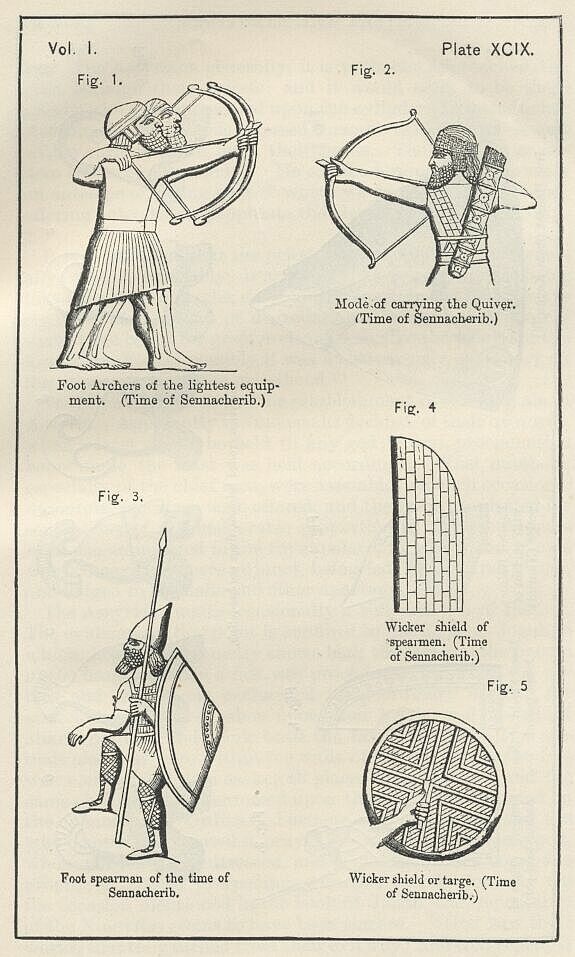
The archers of the lightest equipment wear nothing but a fillet, with or without lappets, upon the head, and a striped tunic, longer behind than in front, which extends from the neck to the knees, and is confined at the waist by a girdle. [PLATE XCIX., Fig. 1.] Their arms, legs, and feet are bare, they have seldom any sword, and their quiver seems to be suspended only by a single horizontal strap, like that represented in [PLATE XCIX., Fig. 2.] They do not appear very often upon the monuments: when seen, they are interspersed among archers and soldiers of other classes.
Sennacherib's foot spearmen are of two classes only. The better armed have pointed helmets, with lappets protecting the ears, a coat of mail descending to the waist and also covering all the upper part of the arms, a tunic opening at the side, a phillibeg, close-fitting trousers, and greaves of the ordinary character. [PLATE XCIX., Fig. 3.] They carry a large convex shield, apparently of metal, which covers them almost from head to foot, and a spear somewhat less than their own height. Commonly they have a short sword at their right side. Their shield is often ornamented with rows of bosses towards the centre and around the edge. It is ordinarily carried in front; but when the warrior is merely upon the march, he often bears it slung at his back, as in the accompanying representation. There is reason to suspect that the spearmen of this description constituted the royal bodyguard. They are comparatively few in number, and are usually seen in close proximity to the monarch, or in positions which imply trust, as in the care of prisoners and of the spoil. They never make the attacks in sieges, and are rarely observed to be engaged in battle. Where several of them are seen together, it is almost always in attendance upon the king whom they constantly precede upon his journeys.
The inferior spearmen of Sennacherib are armed nearly like those of Sargon. They have crested helmets, plain tunics confined at the waist by a broad girdle, cross-belts ornamented with circular disks where they meet in the centre of the breast, and, most commonly, round wicker shields. The chief points wherein they differ from Sargon's spearmen is the following: they usually (though not universally) wear trousers and greaves; they have sleeves to their tunics, winch descend nearly to the elbow; and they carry sometimes, instead of the round shield, a long convex one arched at the top. [PLATE XCIX., fig. 4.] Where they have not this defence, but the far commoner targe, it is always of larger dimensions than the targe of Sargon, and is generally surrounded by a rim. [PLATE XCIX., Fig. 4.] Sometimes it appears to be of metal: but more often it is of wickerwork, either of the plain construction common in Sargon's time, or of one considerably more elaborate.
Among the foot soldiers of Sennacherib we seem to find a corps of pioneers. They wear the same dress as the better equipped of the spearmen, but carry in their hands, instead of a spear, a doubled-headed axe or hatchet, wherewith they clear the ground for the passage and movements of the army. They work in pairs, one pulling at the tree by its branches while the other attacks the stem with his weapon.
After Sennacherib's time we find but few alterations in the equipment of the foot soldiers. Esarhaddon has left us no sculptures, and in those of his son and successor, Asshur-bani pal, the costumes of Sennacherib are for the most part reproduced almost exactly. The chief difference is that there are not at this time quite so many varieties of equipment, both archers and spearmen being alike divided into two classes only, light armed and heavy-armed. The light-armed archers correspond to Sennacherib's bowmen of the third class. They have the fillet, the plain tunic, the cross-belts, the broad girdle, and the phillibeg. They differ only in having no lappets over the ears and no sandals. The heavy-armed archers resemble the first class of Sennacherib exactly, except that they are not seen shooting from behind the gerrhon.
In the case of the spearmen, the only novelty consists in the shields. The spearmen of the heavier equipment, though sometimes they carry the old convex oval shield, more often have one which is made straight at the bottom, and rounded only at top. [PLATE C., Fig. 1. ] The spearmen of the lighter equipment have likewise commonly a shield of this shape, but it is of wicker work instead of metal, like that borne occasionally by the light-armed spearmen of Sennacherib.
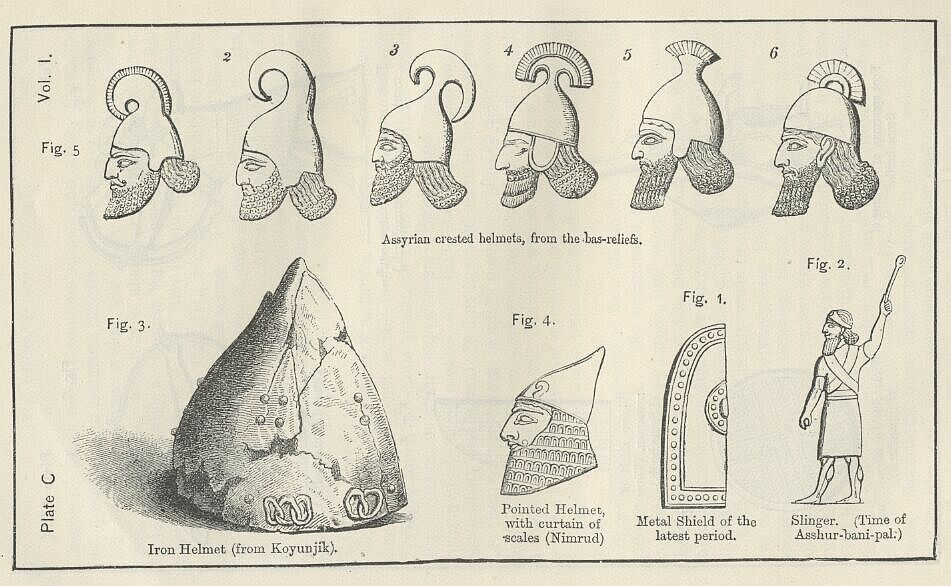
Besides spearmen and archers, we see among the foot soldiers of Asshur-bani-pal, slingers, mace-bearers, and men armed with battle axes. For the slingers Sennacherib's heavy equipment has been discarded; and they wear nothing but a plain tunic, with a girdle and cross-belts. [PLATE C., Fig. 2.] The mace-bearers and men with axes have the exact dress of Asshur-bani-pal's heavy-armed spearmen, and may possibly be spearmen who have broken or lost their weapons. It makes, however, against this view, that they have no shields, which spearmen always carry. Perhaps, therefore, we must conclude that towards the close of the empire, besides spearmen, slingers, and archers, there were distinct corps of mace-bearers and axe-bearers.
The arms used by the Assyrians have been mentioned, and to a certain extent described, in the foregoing remarks upon the various classes of their soldiers. Some further details may, however, be now added on their character and on the variety observable in them.
The common Assyrian pointed helmet has been sufficiently described already, and has received abundant illustration both in the present and in former chapters. It was at first regarded as Scythic in character; but Mr. Layard long ago observed that the resemblance which it bears to the Scythian cap is too slight to prove any connection. That cap appears, whether we follow the foreign, or the native representations of it, to have been of felt, whereas the Assyrian pointed helmet was made of metal: it was much taller than the Assyrian head-dress, and it was less upright. [PLATE C, Fig. 3.]
The pointed helmet admitted of but few varieties. In its simplest form it was a plain conical casque, with one or two rings round the base, and generally with a half-disk in front directly over the forehead. [PLATE C. Fig. 4.] Sometimes, however, there was appended to it a falling curtain covered with metal scales, whereby the chin, neck, ears, and back of the head were protected. More often it had, in lieu of this effectual but cumbrous guard, a mere lappet or cheek-piece, consisting of a plate of metal, attached to the rim, which descended over the ears in the form of a half-oval or semicircle. If we may judge by the remains actually found, the chief material of the helmet was iron; copper was used only for the rings and the half-disk in front, which were inlaid into the harder metal.
As if to compensate themselves for the uniformity to which they submitted in this instance, the Assyrians indulged in a variety of crested helmets. [PLATE. C., Fig. 5.] We cannot positively say that they invented the crest; but they certainly dealt with it in the free spirit which is usually seen where a custom is of home growth and not a foreign importation. They used either a plain metal crest, or one surmounted by tuffs of hair; and they either simply curved the crest forwards over the front of the helmet, or extended it and carried it back-wards also. In this latter case they generally made the curve a complete semicircle, while occasionally they were content with a small segment, less even than a quarter of a circle. They also varied considerably the shape of the lappet over the ear, and the depth of the helmet behind and before the lappet.
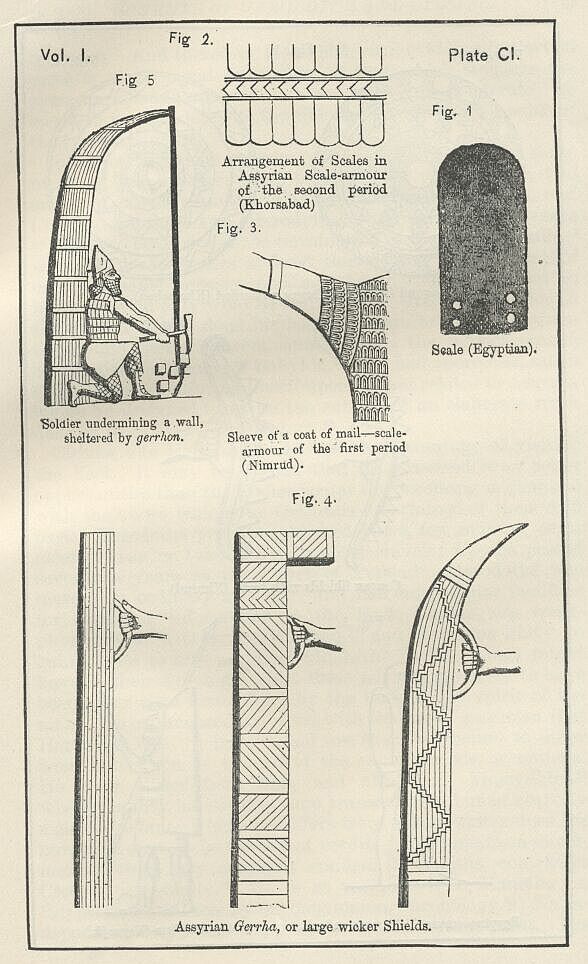
Assyrian coats of mail were of three sizes, and of two different constructions. In the earlier times they were worn long, descending either to the feet or to the knees; and at this period they seem to have been composed simply of successive rows of similar iron scales sewn on to a shirt of linen or felt. [PLATE CI., Fig. 1.] Under the later monarchs the coat of mail reached no lower than the waist, and it was composed of alternate bands of dissimilar arrangement and perhaps of different material. Mr. Layard suggests that at this time the scales, which were larger than before, were "fastened to bands of iron or copper." But it is perhaps more probable that scales of the old character alternated in rows with scales of a new shape and smaller dimensions. [PLATE CI., Fig. 2.] The old scales were oblong, squared at one end and rounded at the other, very much resembling the Egyptian. They were from two to three inches, or more, in length, and were placed side by side, so that their greater length corresponded with the height of the wearer. The new scales seem to have been not more than an inch long; they appear to have been pointed at one end, and to have been laid horizontally, each a little overlapping its fellow. It was probably found that this construction, while possessing quite as much strength as the other, was more favorable to facility of movement.
Remains of armor belonging to the second period have been discovered in the Assyrian ruins. The scales are frequently embossed over their whole surface with groups of figures and fanciful ornaments. The small scales of the first period have no such elaborate ornamentation, being simply embossed in the centre with a single straight line, which is of copper inlaid into the iron.
The Assyrian coat of mail, like the Egyptian, had commonly a short sleeve, extending about half way down to the elbow. [PLATE CI.. Fig. 1.] This was either composed of scales set similarly to those of the rest of the cuirass, or of two, three, or more rows placed at right angles to the others. The greater part of the arm was left without any protection.
A remarkable variety existed in the form and construction of the Assyrian shields. The most imposing kind is that which has been termed the gerrhon, from its apparent resemblance to the Persian shield mentioned under that name by Herodotus. [PLATE CI.. Fig. 1.] This was a structure in wickerwork, which equalled or exceeded the warrior in height, and which was broad enough to give shelter to two or even three men. In shape it was either an oblong square, or such a square with a projection at top, which stood out at right angles to the body of the shield; or, lastly, and most usually, it curved inwards from a certain height, gradually narrowing at the same time, and finally ending in a point. Of course a shield of this vast size, even although formed of a light material, was too heavy to be very readily carried upon the arm. The plan adopted was to rest it upon the ground, on which it was generally held steady by a warrior armed with sword or spear, while his comrade, whose weapon was the bow, discharged his arrows from behind its shelter. Its proper place was in sieges, where the roof-like structure at the top was especially useful in warding off the stones and other missiles which the besieged threw down upon their assailants. We sometimes see it employed by single soldiers, who lean the point against the wall of the place, and, ensconcing themselves beneath the penthouse thus improvised, proceed to carry on the most critical operations of the siege in almost complete security.
Modifications of this shield, reducing it to a smaller and more portable size, were common in the earlier times, when among the shields most usually borne we find one of wicker-work oblong-square in shape, and either perfectly fiat, or else curving slightly inwards both at top and at bottom. This shield was commonly about half the height of a man, or a little more; it was often used as a protection for two, but must have been scanty for that purpose.
Round shields were commoner in Assyria than any others. They were used by most of those who fought in chariots, by the early monarchs' personal attendants, by the cross-belted spear-men, and by many of the spearmen who guarded archers. In the most ancient times they seem to have been universally made of solid metal, and consequently they were small, perhaps not often exceeding two feet, or two feet and a half, in diameter. They were managed by means of a very simple handle, placed in the middle of the shield at the back, and fastened to it by studs or nails, which was not passed over the arm but grasped by the hand. The rim was bent inwards, so as to form a deep groove all round the edge. The material of which these shields were composed was in some cases certainly bronze; in others it may have been iron: in a few silver, or even gold. Some metal shields were perfectly plain; others exhibited a number of concentric rings, others again were inlaid or embossed with tasteful and elaborate patterns.
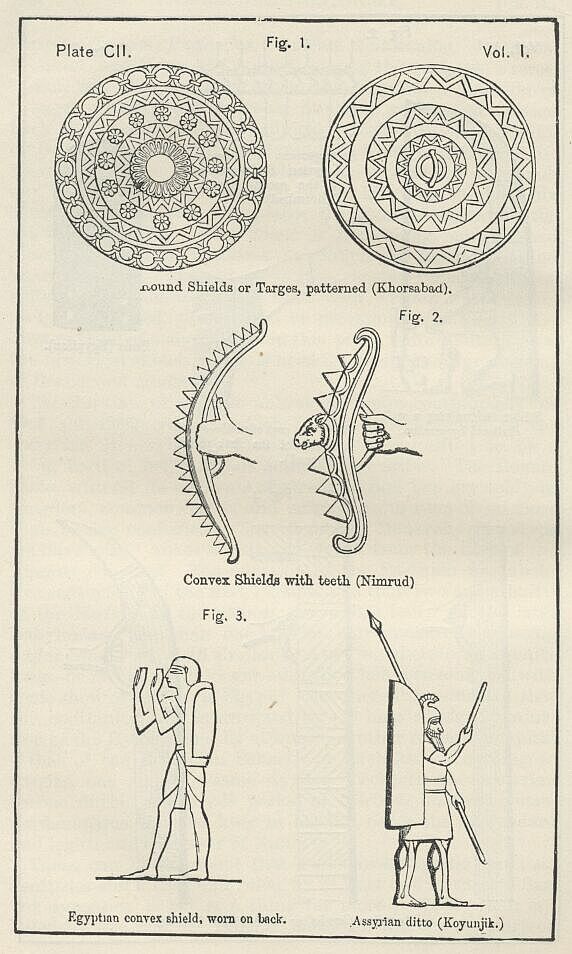
Among the later Assyrians the round metal shield seems to have been almost entirely disused, its place being supplied by a wicker buckler of the same shape, with a rim round the edge made of solid wood or of metal, and sometimes with a boss in the centre. [PLATE CII., Fig. 1.] The weight of the metal shield must have been considerable; and this both limited their size and made it difficult to move them with rapidity. With the change of material we perceive a decided increase of magnitude, the diameter of the wicker buckler being often fully half the warrior's height, or not much short of three feet.
Convex shields, generally of an oblong form, were also in common use during the later period, and one kind is found in the very earliest sculptures. This is of small dimensions and of a clumsy make. Its curve is slight, and it is generally ornamented with a perpendicular row of spikes or teeth, in the centre of which we often see the head of a lion. [PLATE CII., Fig. 2.]
The convex shields of later date were very much larger than these. [PLATE CIII., Fig. 3.] They were sometimes square at bottom and rounded at top, in which case they were either made of wickerwork, or (apparently) of metal. These latter had generally a boss in the centre, and both this and the edge of the shield were often ornamented with a row of rosettes or rings. Shields of this shape were from four to five feet in height, and protected the warrior from the head to the knee. On a march they were often worn upon the back, like the convex shield of the Egyptians, which they greatly resembled.
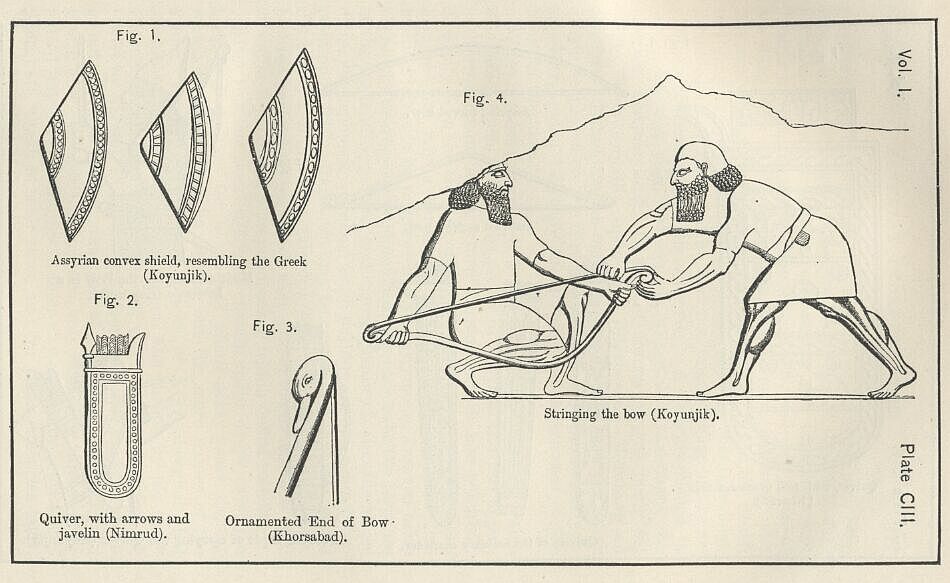
The more ordinary convex shield was of an oval form, like the convex shield of the Greeks, but larger, and with a more prominent centre. [PLATE CIII., Fig. 1.] In its greater diameter it must often have exceeded five feet, though no doubt sometimes it was smaller. It was generally ornamented with narrow bands round the edge and round the boss at the centre, the space between the bands being frequently patterned with ring; or otherwise. Like the other form of convex shield, it could be slung at the back, and was so carried on marches, on crossing rivers, and other similar occasions.
The offensive arms certainly used by the Assyrians were the bow, the spear, the sword, the mace, the sling, the axe or hatchet, and the dagger. They may also have occasionally made use of the javelin, which is sometimes seen among the arrows of a quiver. But the actual employment of this weapon in war has not yet been found upon the bas-reliefs. If faithfully represented, it must have been very short,—scarcely, if at all, exceeding three feet. [PLATE CIII., Fig. 2.]
Assyrian bows were of two kinds, curved and angular. Compared with the Egyptian, and with the bows used by the archers of the middle ages, they were short, the greatest length of the strung bow being about four feet. They seem to have been made of a single piece of wood, which in the angular bow was nearly of the same thickness throughout, but in the curved one tapered gradually towards the two extremities. At either end was a small knob or button, in the later times often carved into the representation of a duck's head. [PLATE CIII, Fig. 3.] Close above this was a notch or groove, whereby the string was held in place. The mode of stringing was one still frequently practised in the East. The bowman stooped, and placing his right knee against the middle of the bow on its inner side, pressed it downwards, at the same time drawing the two ends of the bow upwards with his two hands. [PLATE CIII, Fig. 4.] A comrade stood by, and, when the ends were brought sufficiently near, slipped the string over the knob into the groove, where it necessarily remained. The bend of the bow, thus strung, was slight. When full drawn, however, it took the shape of a half-moon, which shows that it must have possessed great elasticity. [PLATE CIV., Fig. 4.] The bow was known to be full drawn when the head of the arrow touched the archer's left hand.
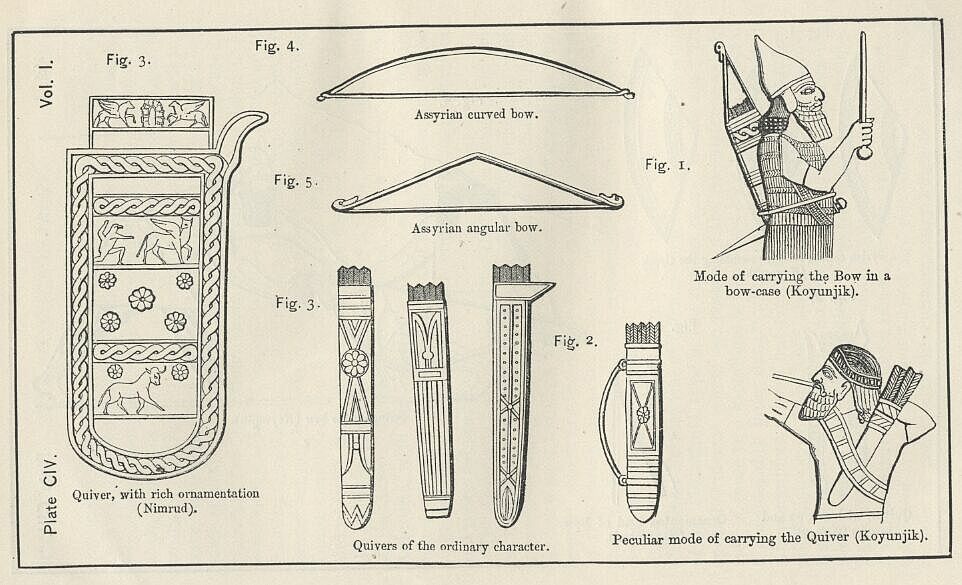
The Assyrian angular bow was of smaller size than the curved one. It was not often carried unless as a reserve by those who also possessed the larger and better weapon. [PLATE CIV., Fig. 5.]
Bows were but seldom unstrung. When not in use, they were carried strung, the archer either holding them by the middle with his left hand, or putting his arm through them, and letting them rest upon his shoulders, or finally carrying them at his back in a bow case. [PLATE CIV., Fig. I. ] The bow-case was a portion of the quiver, as frequently with the Greeks, and held only the lower half of the bow, the upper portion projecting from it.
Quivers were carried by foot and horse archers at their backs, in a diagonal position, so that the arrows could readily be drawn from them over the right shoulder. They were commonly slung in this position by a strap of their own, attached to two rings, one near the top and the other near the bottom of the quiver, which the archer slipped over his left arm and his head. Sometimes, however, this strap seems to have been wanting, and the quiver was either thrust through one of the cross-belts, or attached by a strap which passed horizontally round the body a little above the girdle. [PLATE CIV.,Fig. 2.] The archers who rode in chariots carried their quivers at the chariot's side, in the manner which has been already described and illustrated.
The ornamentation of quivers was generally elaborate. [PLATE CIV., Fig. 3.] Rosettes and bands constituted their most usual adornment; but sometimes these gave place to designs of a more artistic character, as wild bulls, griffins, and other mythic figures. Several examples of a rich type have been already given in the representations of chariots, but none exhibit this peculiarity. One further specimen of a chariot quiver is therefore appended, which is among the most tasteful hitherto discovered. [PLATE CIV., Fig. 3. ]
The quivers of the foot and horse archers were less richly adorned than those of the bowmen who rode in chariots, but still they were in almost every case more or less patterned. The rosette and the band here too constituted the chief resource of the artist, who, however, often introduced with good effect other well-known ornaments, as the guilloche, the boss and cross, the zigzag, etc.
Sometimes the quiver had an ornamented rod attached to it, which projected beyond the arrows and terminated in a pomegranate blossom or other similar carving. [PLATE CV. Fig. 1]. To this rod was attached the rings which received the quiver strap, a triple tassel hanging from them at the point of attachment. The strap was probably of leather, and appears to have been twisted or plaited.
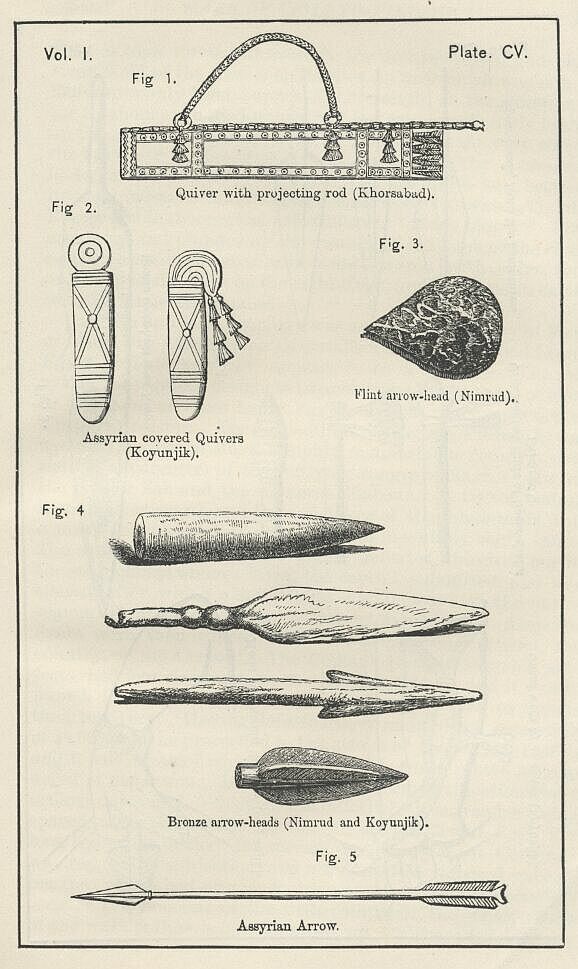
It is uncertain whether the material of the quivers was wood or metal. As, however, no remains of quivers have been discovered in any of the ruins, while helmets, shields, diggers, spear-heads, and arrow-heads have been found in tolerable abundance, we may perhaps assume that they were of the more fragile substance, which would account for their destruction. In this case their ornamentation may have been either by carving or painting, the bosses and rosettes being perhaps in some cases of metal, mother-of-pearl, or ivory. Ornaments of this kind were discovered by hundreds at Nimrud in a chamber which contained arms of many descriptions. Quivers have in some cases a curious rounded head, which seems to have been a lid or cap used for covering the arrows. They have also, occasionally, instead of this, a kind of bag at their top, which falls backwards, and is ornamented with tassels. [PLATE CV., Fig. 2.] Both these constructions, however, are exceptional, a very large majority of the quivers being open, and having the feathered ends of the arrows projecting from them.
There is nothing remarkable in the Assyrian arrows except their perfect finish and completeness in all that constitutes the excellence of such a weapon. The shaft was thin and straight, and was probably of reed, or of some light and tough wood. The head was of metal, either of bronze or iron, and was generally diamond-shaped, like a miniature spear-head. [PLATE CV., Fig. 4. ] It was flattish, and for greater strength had commonly a strongly raised line down the centre. The lower end was hollowed, and the shaft was inserted into it. The notching and feathering of the shaft were carefully attended to. It is doubtful whether three feathers were used, as by ourselves and by the Egyptians, or two only as by many nations. The fact that we never see more than two feathers upon the monuments cannot be considered decisive, since the Assyrian artists, from their small knowledge of perspective, would have been unable to represent all three feathers. So far as we can judge from the representations, it would seem that the feathers were glued to the wood exactly as they are with ourselves. The notch was somewhat large, projecting beyond the line of the shaft—a construction rendered necessary by the thickness of the bowstring., which was seldom less than of the arrow it-self. [PLATE CV., Fig. 5.]
The mode of drawing the bow was peculiar. It was drawn neither to the ear, nor to the breast, but to the shoulder. In the older sculptures the hand that draws it is represented in a curiously cramped and unnatural position, which can scarcely be supposed to be true to nature. But in the later bas-reliefs greater accuracy seems to have been attained, and there we probably see the exact mode in which the shooting was actually managed. The arrow was taken below the feathers by the thumb and forefinger of the right hand, the forefinger bent down upon it in the way represented in the accompanying illustration, and the notch being then placed upon the string, the arrow was drawn backwards by the thumb and forefinger only, the remaining three fingers taking no part in the operation. [PLATE CVI., Fig. 1.] The bow was grasped by the left hand between the fingers and the muscle of the thumb, the thumb itself being raised, and the arrow made to pass between it and the bow, by which it was kept in place and prevented from slipping. The arrow was then drawn till the cold metal head touched the forefinger of the left hand, upon which the right hand quitted its hold, and the shaft sped on its way. To save the left arm from being bruised or cut by the bowstring, a guard, often simply yet effectively ornamented, was placed upon it, at one end passing round the thumb and at the other round the arm a little above the elbow. [PLATE CVI., Fig. 2.]
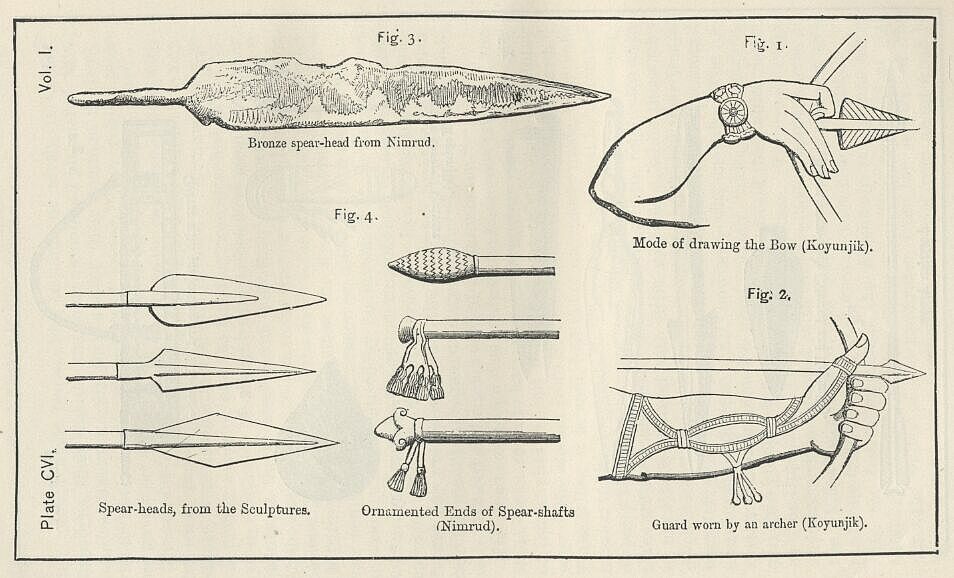
The Assyrians had two kinds of spears, one a comparatively short weapon, varying from five to six feet in length, with which they armed a portion of their foot soldiers, the other a weapon nine or ten feet long, which was carried by most of their cavalry. The shaft seems in both cases to have been of wood, and the head was certainly of metal, either bronze or iron. [PLATE CVI., Fig. 3.] It was most usually diamond-shaped, but sometimes the side angles were rounded off, and the contour became that of an elongated pear. [PLATE CVI., Fig. 4.] In other instances, the jambs of the spear-head were exceedingly short, and the point long and tapering. The upper end of the shaft was sometimes weighted, and it was often carved into some ornamental form, as a fir-cone or a pomegranate blossom, while in the earlier times it was further occasionally adorned with streamers. [PLATE CVI., Fig. 4.] The spear of the Assyrians seems never to have been thrown, like that of the Greeks, but was only used to thrust with, as a pike.
The common sword of the Assyrians was a short straight weapon, like the sword of the Egyptians, or the acinaces of the Persians. It was worn at the left side, generally slung by a belt of its own which was passed over the right shoulder, but sometimes thrust through the girdle or (apparently) through the armor. It had a short rounded handle, more or less ornamented [PLATE CVII.. Fig. 1], but without any cross-bar or guard, and a short blade which tapered gradually from the handle to the point. The swordsman commonly thrust with his weapon, but he could cut with it likewise, for it was with this arm that the Assyrian warrior was wont to decapitate his fallen enemy. The sheath of the sword was almost always tastefully designed, and sometimes possessed artistic excellence of a high order. [PLATE CVII., Fig. 3.] The favorite terminal ornament consisted of two lions clasping one another, with their heads averted and their mouths agape. Above this, patterns in excellent taste usually adorned the scabbard, which moreover exhibited occasionally groups of figures, sacred trees, and other mythological objects.
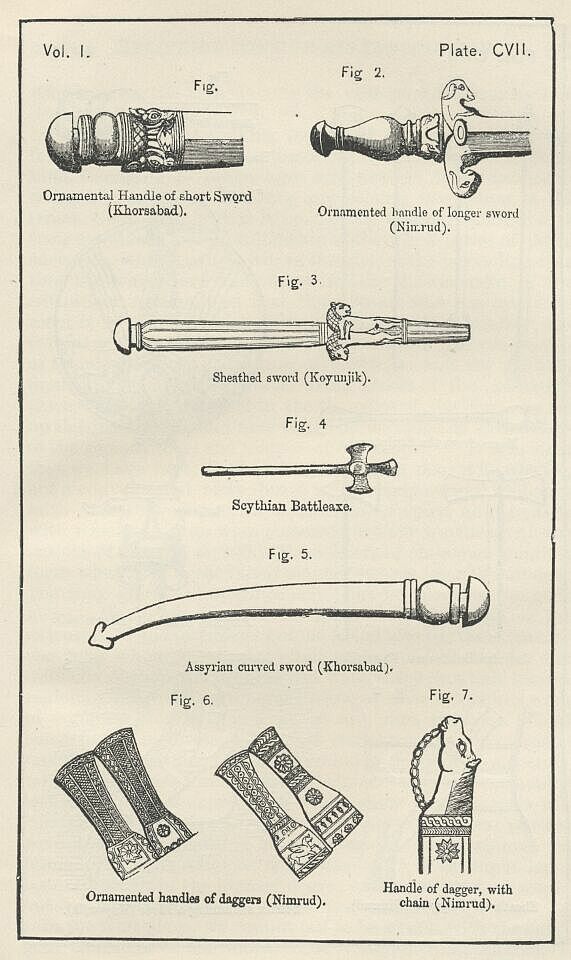
Instead of the short sword, the earlier warriors had a weapon of a considerable length. This was invariably slung at the side by a cross-belt passing over the shoulder. In its ornamentation it closely resembled the later short sword, but its hilt was longer and more tasteful.
One or two instances occur where the sword of an Assyrian warrior is represented as curved slightly. The sheath in these cases is plain, and terminates in a button. [PLATE CVII, Fig. 5.]
The Assyrian mace was a short thin weapon, and must either have been made of a very tough wood, or—and this is more probable of metal. [PLATE CVIII., Fig. 7.] It had an ornamented head, which was sometimes very beautifully modelled and generally a strap or string at the lower end, by which it could be grasped with greater firmness. Foot archers frequently carried it in battle, especially those who were in close attendance upon the king's person. It seems, however, not to have been often used as a warlike weapon until the time of the latest sculptures, when we see it wielded, generally with both hands, by a certain number of the combatants. In peace it was very commonly borne by the royal attendants, and it seems also to have been among the weapons used by the monarch himself, for whom it is constantly carried by one of those who wait most closely upon his person. [PLATE., CVIII., Fig. I.]
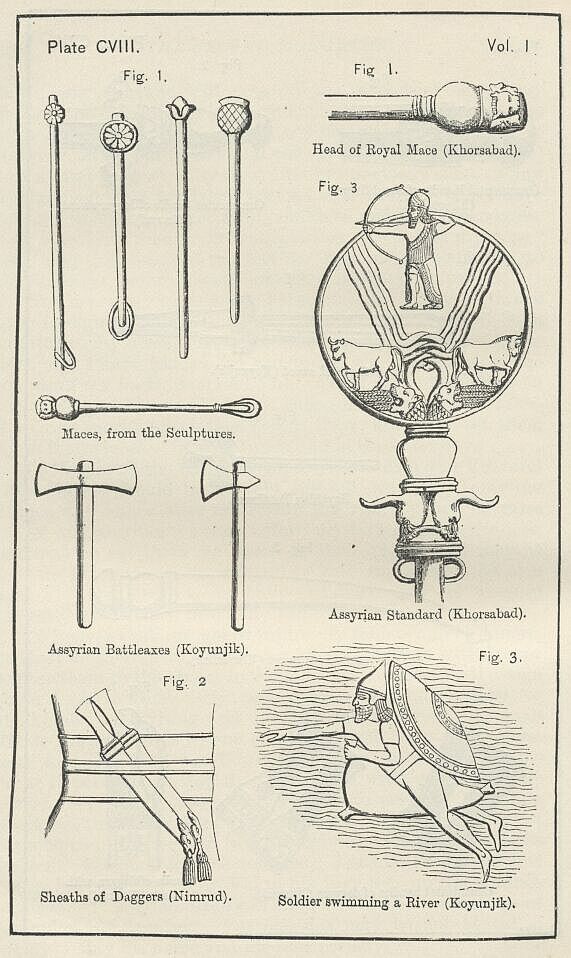
The battle-axe was a weapon but rarely employed by the Assyrians. It is only in the very latest sculptures and in a very few instances that we find axes represented as used by the warriors for any other purpose besides the felling of trees. Where they are seen in use against the enemy, the handle is short, the head somewhat large, and the weapon wielded with one hand. Battle-axes had heads of two kinds. [PLATE CVIII., Fig. 1.] Some were made with two blades, like the bipennis of the Romans. and the labra of the Lydians and Carians; others more nearly resembled the weapons used by our own knights in the middle ages, having a single blade, and a mere ornamental point on the other side of the haft.
The dagger was worn by the Assyrian kings at almost all times in their girdles, and was further often assigned to the mythic winged beings, hawk headed or human-headed, which occur so frequently in the sculptures; but it seems to have been very seldom carried by subjects. It had commonly a straight handle, slightly concave, and very richly chased, exhibiting the usual Assyrian patterns, rosettes, chevrons, guilloches, pine-cones, and the like. [PLATE CVII., Fig. 6.] Sometimes, however, it was still more artistically shaped, being cast into the form of a horse's head and neck. In this case there was occasionally a chain attached at one end to the horse's chin, and at the other to the bottom of his neck, which, passing outside the hand, would give it a firmer hold on the weapon. The sheaths of daggers seem generally to have been plain, or nearly so, but occasionally they terminated in the head of an animal, from whose mouth depended a tassel. [PLATE CVIII., Fig. 2.]
Though the Assyrian troops were not marshalled by the aid of standards, like the Roman and the Egyptian, yet still a kind of standard is occasionally to be recognized in the bas-reliefs. This consists of a pole of no great height, fixed upright at the front of a chariot, between the charioteer and the warrior, and carrying at the top a circular frame, within which are artistic representations of gods or sacred animals. Two bulls, back to back, either trotting or running at speed, are a favorite device. Above there sometimes stands a figure in a horned cap, shooting his arrows against the enemy. Occasionally only one bull is represented, and the archer shoots standing upon the bull's back. Below the circular framework are minor ornaments, as lions' and bulls' heads, or streamers adorned with tassels. [PLATE CVIII., Fig. 2.]
We do not obtain much information from the monuments with respect to the military organization or the the tactics of the Assyrians. It is clear, however, that they had advanced beyond the first period in military matters, when men fight in a confused mass of mingled horse, foot, and chariots, heavy-armed and light-armed spear-men, archers, and stingers, each standing and moving as mere chance may determine. It is even certain that they had advanced beyond the second period, when the phalanx order of battle is adopted, the confused mass being replaced by a single serried body presenting its best armed troops to the enemy, and keeping in the rear, to add their weight to the charge, the weaker and more imperfectly protected. It was not really left for Cyaxares the Mede to be the first to organize an Asiatic army—to divide the troops into companies and form distinct bodies of the spearmen, the archers, and the cavalry. The Assyrian troops were organized in this way, at least from the time of Sennacherib, on whose sculptures we find, in the first place, bodies of cavalry on the march unaccompanied by infantry; secondly, engagements where cavalry only are acting against the enemy; thirdly, long lines of spearmen on foot marching in double file, and sometimes divided into companies; and, fourthly, archers drawn up together, but similarly divided into companies, each distinguished by its own uniform. We also meet with a corps of pioneers, wearing a uniform and armed only with a hatchet, and with bodies of slingers, who are all armed and clothed alike. If, in the battles and the sieges of this time, the troops seem to be to a great extent confused together, we may account for it partly by the inability of the Assyrian artists to represent bodies of troops in perspective, partly by their not aiming at an actual, but rather at a typical representation of events, and partly also by their fondness for representing, not the preparation for battle or its first shock, but the rout and flight of the enemy and their own hasty pursuit of them.
The wars of the Assyrians, like those of ancient Rome, consisted of annual inroads into the territories of their neighbors, repeated year after year, till the enemy was exhausted, sued for peace, and admitted the suzerainty of the more powerful nation. The king in person usually led forth his army, in spring or early summer, when the mountain passes were opened, and, crossing his own borders, invaded some one or other of the adjacent countries. The monarch himself invariably rode forth in his chariot, arrayed in his regal robes, and with the tiara upon his head: he was accompanied by numerous attendants, and generally preceded and followed by the spearmen of the Royal Guard, and a detachment of horse-archers. Conspicuous among the attendants were the charioteer who managed the reins, and the parasol-bearer, commonly a eunuch, who, standing in the chariot behind the monarch, held the emblem of sovereignty over his head. A bow-bearer, a quiver-bearer, and a mace-bearer were usually also in attendance, walking before or behind the chariot of the king, who, however, did not often depend for arms wholly upon them, but carried a bow in his left hand, and one or more arrows in his right, while he had a further store of the latter either in or outside his chariot. Two or three led horses were always at hand, to furnish a means of escape in any difficulty. The army, marshalled in its several corps, in part preceded the royal cortege, in part followed at a little distance behind it.
On entering the enemy's country, if a wooded tract presented itself, the corps of pioneers was thrown out in advance, and cleared away the obstructions. When a river was reached too deep to be forded, the horses were detached from the royal and other chariots by grooms and attendants; the chariots themselves were embarked upon boats and rowed across the stream; while the horses, attached by ropes to a post near the stern of the boat, swam after it. The horses of the cavalry were similarly drawn across by their riders. The troops, both cavalry and infantry, and the attendants, a very numerous body, swam the stream, generally upon inflated skins, which they placed under them, holding the neck in their left hand, and sometimes increasing the inflation as they went by applying the orifice at the top of the neck to their mouths. [PLATE CVIII., Fig. 3.] We have no direct evidence as to the mode in which the baggage of an army, which must have been very considerable, was conveyed, either along the general line of route, or when it was necessary to cross a river. We may conjecture that in the latter case it was probably placed upon rafts supported on inflated skins, such as those which conveyed stones from distant quarries to be used in the Assyrian buildings. In the former, we may perhaps assume that the conveyance was chiefly by beasts of burden, camels and asses, as the author of the book of Judith imagined. Carts may have been used to some extent; since they were certainly employed to convey back to Assyria the spoil of the conquered nations.
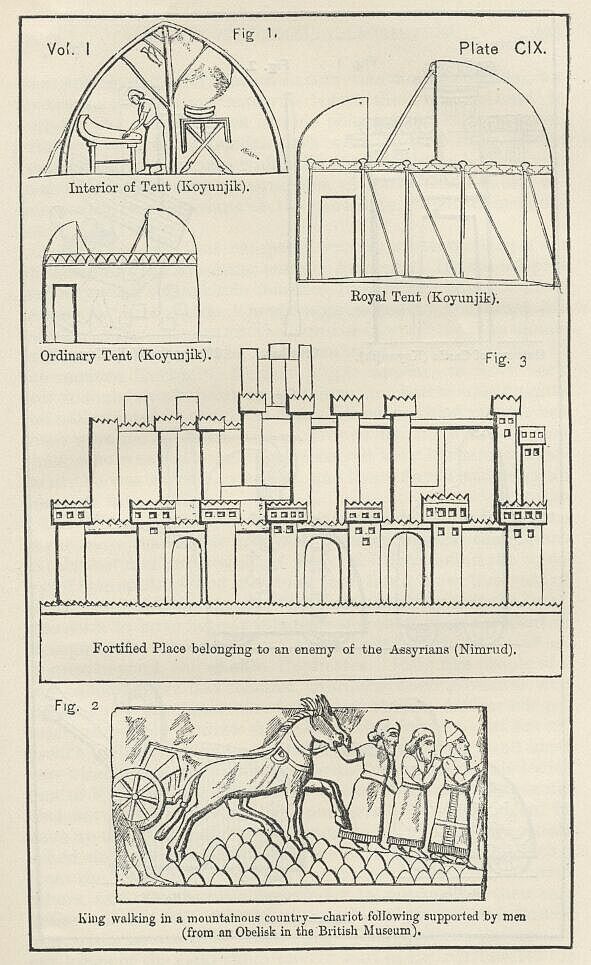
It does not appear whether the army generally was provided with tents or not. Possibly the bulk of the soldiers may have bivouacked in the open field, unless when they were able to obtain shelter in towns or villages taken from the enemy. Tents, however, were certainly provided for the monarch and his suite. [PLATE CIX., Fig. 1.] Like the tents of the Romans, these appear to have been commonly pitched within a fortified enclosure, which was of an oval shape. They were disposed in rows, and were all nearly similar in construction and form, the royal tent being perhaps distinguished from the others by a certain amount of ornamentation and by a slight superiority of size. The material used for the covering was probably felt. All the tents were made open to the sky in the centre, but closed in at either extremity with a curious semicircular top. [PLATE CIX., Fig. 1.] The two tops were unequal of size. Internally, either both of them, or at any rate the larger ones, were supported by a central pole, which threw out branches in different directions resembling the branches of a tree or the spokes of a parasol. Sometimes the walls of the tent had likewise the support of poles, which were kept in place by ropes passed obliquely from the top of each to the ground in front of them, and then firmly secured by pegs. Each tent had a door, square-headed, which was placed at the side, near the end which had the smaller covering. The furniture of tents consisted of tables, couches, footstools, and domestic utensils of various kinds. [PLATE CIX., Fig. 1.] Within the fortified enclosure, but outside the tents, were the chariot and horses of the monarch, an altar where sacrifice could be made, and a number of animals suitable for food, as oxen, sheep, and goats.
It appears that occasionally the advance of the troops was along a road. Ordinarily, however, they found no such convenience, but had to press forward through woods and over mountains as they best could. Whatever the obstructions, the chariot of the monarch was in some way or other conveyed across them, though it is difficult to suppose that he could have always remained, as he is represented, seated in it. Probably he occasionally dismounted, and made use of one of the led horses by which he was always accompanied, while sometimes he even condescended to proceed on foot. [PLATE CIX., Fig. 2.] Tile use of palanquins or litters seem not to have been known to the Assyrians, though it was undoubtedly very ancient in Asia; but the king was sometimes carried on men's shoulders, seated on his throne in the way that we see the enthroned gods borne in many of the sculptures.
The first object in entering a country was to fight, if possible, a pitched battle with the inhabitants. The Assyrians were always confident of victory in such an encounter, being better armed, better disciplined, and perhaps of stronger frames than any of their neighbors. There is no evidence to show how their armies were drawn up, or how the troops were handled in an engagement; but it would seem that in most cases, after a longer or a shorter resistance, the enemy broke and fled, sometimes throwing away his arms, at other tunes fighting as he retired, always vigorously pursued by horse and foot, and sometimes driven headlong into a river. Quarter was not very often given in a battle. The barbarous practice of rewarding those who carried back to camp the heads of foemen prevailed; and this led to the massacre in many cases even of the wounded, the disarmed, and the unresisting, though occasionally quarter was given, more especially to generals and other leading personages whom it was of importance to take alive. Even while the engagement continued, it would seem that soldiers might quit the ranks, decapitate a fallen foe, and carry off his head to the rear, without incurring any reproof; and it is certain that, so soon as the engagement was over, the whole army turned to beheading the fallen, using for this purpose the short sword which almost every warrior carried at his left side. A few unable to obtain heads, were forced to be content with gathering the spoils of the slain and of the fled, especially their arms, such as quivers, hews, helmets, and the like; while their more fortunate comrades, proceeding to an appointed spot in the rear, exhibited the tokens of their valor, or of their good luck, to the royal scribes, who took an exact account of the amount, of the spoil, and of the number of the enemy killed.
When the enemy could no longer resist in the open field, he usually fled to his strongholds. Almost all the nations with whom the Assyrians waged their wars possessed fortified cities, or castles, which seem to have been places constructed with a good deal of skill, and possessed of no inconsiderable strength. According to the representations of the sculptures, they were all nearly similar in character, the defences consisting of high battlemented walls, pierced with loopholes or windows towards their upper part, and flanked at intervals along their whole course by towers. [PLATE CIX., Fig. 3.] Often they possessed two or more enceintes, which in the bas-reliefs are represented one above the other; and in these cases the outermost circuit was sometimes a mere plain continuous wall, as in the illustration. They were entered by large gateways, most commonly arched, and closed by two huge gates or doors, which completely filled up the aperture. Occasionally, however, the gateways were square-headed, as in the illustration, where there occurs, moreover, a very curious ornamentation of the battlements. [PLATE CX., Fig. 1.]
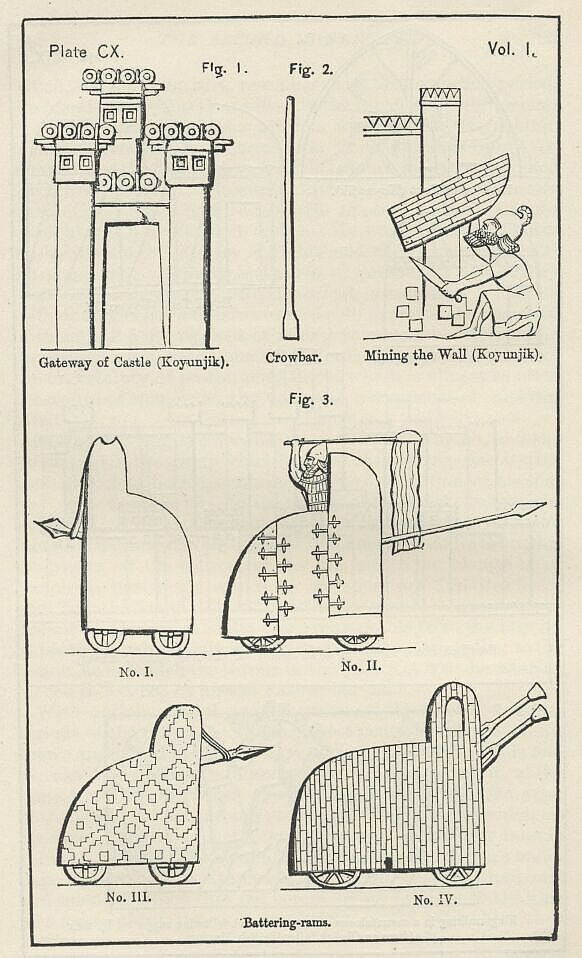
These fortified places the Assyrians attacked in three principal ways. Sometimes they endeavored to take them by escalade, advancing for this purpose a number of long ladders against different parts of the walls, thus distracting the enemy's attention and seeking to find a weak point. Up the ladders proceeded companies of spearmen and archers in combination, the spearmen invariably taking the lead, since their large shields afforded them a protection which archers advancing in file up a ladder could not have. Meanwhile from below a constant discharge was kept up by bowmen and slingers, the former of whom were generally protected by the gerrhon or high wicker shield, held in front of them by a comrade. The besieged endeavored to dislodge and break the ladders, which are often represented in fragments; or, failing in this attempt, sought by hurling down large stones, and by discharges from their bows and slings, to precipitate and destroy their assailants. If finally they were unable by these means to keep the Assyrians from reaching the topmost rounds of the ladders, they had recourse to their spears, and man to man, spear to spear, and shield to shield, they still struggled to defend themselves. The Assyrians always represent the sieges which they conduct as terminating successfully: but we may be tolerably sure that in many instances the invader was beaten back, and forced to relinquish his prey, or to try fresh methods of obtaining it.
If the escalade failed, or if it was thought unadvisable to attempt it, the plan most commonly adopted was to try the effect of the battering-ram. [PLATE CX., Fig. 3.] The Assyrian armies were abundantly supplied with these engines, of which we see as many as seven engaged in a single siege. They were variously designed and arranged. Some had a head shaped like the point of a spear; others, one more resembling the end of a blunderbuss. All of them were covered with a frame-work, which was of ozier, wood, felt, or skins, for the better protection of those who worked the implement; but some appear to have been stationary, having their framework resting on the ground itself, while others were moveable, being provided with wheels, which in the early times were six, but in the later times four only. Again, sometimes, combined with the ram and its framework was a moveable tower containing soldiers, who at once fought the enemy on a level, and protected the engine from their attacks. Fire was the weapon usually turned against the ram, torches, burning tow, or other inflammable substances being cast from the walls upon its framework, which, wherever it was of ozier or of wood, could be easily set alight and consumed. To prevent this result, the workers of the ram were sometimes provided with a supply of water, which they could direct through leathern or metal pipes against the combustibles. At other times they sought to protect themselves by suspending from a pole in front of their engine a curtain of cloth, leather, or some other non-inflammable substance.
Another mode of meeting the attacks of the battering-ram was by catching the point with a chain suspended by its two ends from the walls, and then, when the ram was worked, diverting the stroke by drawing the head upwards. To oppose this device, the besiegers provided some of their number with strong metal hooks, and stationed them below the ram, where they watched for the descent of the chain. As soon as ever it caught the head of the ram, they inserted their hooks into its links, and then hanging upon it with their whole weight, prevented its interference with the stroke.
Battering-rams were frequently used against the walls from the natural ground at their foot. Sometimes, however, the besiegers raised vast mounds against the ramparts, and advanced their engines up these, thus bringing theirs on a level with the upper and weaker portions of the defences. Of this nature probably were the mounds spoken of in Scripture as employed by the Babylonians and Egyptians, as well as the Assyrians, in their sieges of cities. The intention was not so much to pile up the mounds till they were on a level with the top of the walls as to work the battering-ram with greater advantage from them. A similar use was made of mounds by the Peloponnesian Greeks, who nearly succeeded in taking Plataea in this way. The mounds were not always composed entirely of earth; the upper portion was often made of several layers of stone or brick, arranged in regular order, so as to form a sort of paved road, up which the rams might be dragged with no great difficulty. Trees, too, were sometimes cut down and built into the mound.
Besides battering-rams, the Assyrians appear to have been acquainted with an engine resembling the catapult, or rather the balista of the Romans. [PLATE CXI., Fig. 1.] This engine, which was of great height, and threw stones of a large size, was protected, like the ram, by a framework, apparently of wood, covered with canvas, felt, or hides. The stones thrown from the engine were of irregular shape, and it was able to discharge several at the same time. The besiegers worked it from a mound or inclined plane, which enabled them to send their missiles to the top of the ramparts. It had to be' brought very close to the walls in order to be effective—a position which gave the besieged an opportunity of assailing it by fire. Perhaps it was this liability which caused the infrequent use of the engine in question, which is rare upon the earlier, and absent from the later, sculptures.
The third mode of attack employed by the Assyrians in their sieges of fortified places was the mine. While the engines were in full play, and the troops drawn up around the place assailed the defenders of the walls with their slings and bows, warriors, singly, or in twos and threes, advanced stealthily to the foot of the ramparts, and either with their swords and the points of their spears, or with implements better suited for the purpose, such as crowbars and pickaxes, attacked the foundations of the walls, endeavoring to remove the stones one by one, and so to force an entrance. While thus employed, the assailant commonly either held his shield above him as a protection or was guarded by the shield of a comrade; or, finally, if he carried the curved gerrhon, leant it against the wall, and then placed himself under its shelter. [PLATE CX., Fig. 2.] Sometimes, however, he dispensed with the protection of a shield altogether, and, trusting his helmet and coat of mail, which covered him at all vital points, pursued his labor without paying any attention to the weapons aimed at him by the enemy.
Occasionally the efforts of the besiegers were directed against the gates, which they endeavored to break open with axes, or to set on fire by an application of the torch. From this latter circumstance we may gather that the gates were ordinarily of wood, not, like those of Babylon and Veii, of brass. In the hot climate of Southern Asia wood becomes so dry by exposure to the sun that the most solid doors may readily be ignited and consumed.
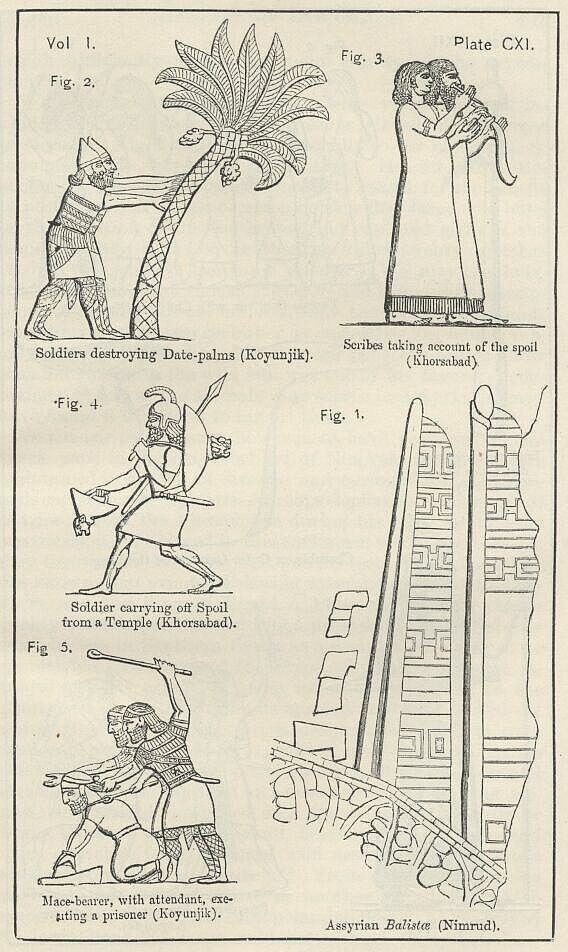
When at last the city or castle was by some of these means reduced, and the garrison consented to surrender itself, the work of demolition, already begun, was completed. Generally the place was set on fire; sometimes workmen provided with pickaxes and other tools mounted upon the ramparts and towers, hurled down the battlements, broke breaches in the walls, or even levelled the whole building. [PLATE CXII., Fig. 1.] Vengeance was further taken by the destruction of the valuable trees in the vicinity, more especially the highly prized date-palms, which were cut with hatchets half through their stems at the distance of about two feet from the ground, and then pulled or pushed down. [PLATE CXI., Fig. 2.] Other trees were either treated similarly, or denuded of their branches. Occasionally the destruction was of a less wanton and vengeful character. Timber-trees were cut down for transport to Assyria, where they were used in the construction of the royal-palaces; and fruit-trees were occasionally taken up by the roots, removed carefully, and planted in the gardens and orchards of the conquerors. Meanwhile there was a general plundering of the captured place. The temples were entered, and the images of the gods, together, with the sacred vessels, which were often of gold and silver, were seized and carried off in triumph. [PLATE CXI., Fig. 4.] This was not mere cupidity. It was regarded as of the utmost importance to show that the gods of the Assyrians were superior to those of other countries, who were powerless to protect either their votaries or even themselves from the irresistible might of the servants of Asshur. The ordinary practice was to convey the images of the foreign gods from the temples of the captured places to Assyria, and there to offer then at the shrines of the principal Assyrian deities. Hence the special force of the proud question, "Where are the gods of Hanath and of Arpad? Where are the gods of Sepharvaim, Hena, and Ivah? Where are they but carried captive to Assyria, prisoners and slaves in the temples of those deities whose power they ventured to resist?"
The houses of the city were also commonly plundered, and everything of value in them was carried off. Long files of men, each bearing some article of furniture out of the gate of a captured town, are frequent upon the bas-reliefs, where we likewise often observe in the train of a returning army carts laden with household stuff of every kind, alternating with long strings of captives. All the spoil seems to have been first brought by the individual plunderers to one place, where it was carefully sorted and counted in the presence and under the superintendence of royal scribes, who took an exact inventory of the whole before it was carried away by its captors. [PLATE CXI., Fig. 3.] Scales were used to determine the weight of articles made of the precious metals, which might otherwise have been subjected to clipping. We may conclude from these practices that a certain proportion of the value of all private spoil was either due to the royal treasury, or required to be paid to the gods in acknowledgment of their aid and protection. Besides the private spoil, there was a portion which was from the first set apart exclusively for the monarch. This consisted especially of the public treasure of the captured city, the gold and silver, whether in bullion, plate, or ornaments, from the palace of its prince, and the idols, and probably the other valuables from the temples.
The inhabitants of a captured place were usually treated with more or less of severity. Those regarded as most responsible for the resistance or the rebellion were seized; generally their hands were manacled either before them or behind their backs, while sometimes fetters were attached to their feet, and even rings passed through their lips, and in this abject guise they were brought into the presence of the Assyrian king. Seated on his throne in his fortified camp without the place, and surrounded by his attendants, he received them one by one, and instantly pronounced their doom. On some he proudly placed his foot, some he pardoned, a few he ordered for execution, many he sentenced to be torn from their homes and carried into slavery.
Various modes of execution seem to have been employed in the case of condemned captives. One of them was empalement. This has always been, and still remains, a common mode of punishment in the East; but the manner of empaling which the Assyrians adopted was peculiar. They pointed a stake at one end, and, having fixed the other end firmly into the ground, placed their criminal with the pit of his stomach upon the point, and made it enter his body just below the breastbone. This method of empaling must have destroyed life tolerably soon, and have thus been a far less cruel punishment than the crucifixion of the Romans. We do not observe it very often in the Assyrian sculptures, nor do we ever see it applied to more than a few individuals. It was probably reserved for those who were considered the worst criminals. Another very common mode of executing captives was by beating in their skulls with a mace. In this case the victim commonly knelt; his two hands were placed before him upon a block or cushion: behind him stood two executioners, one of whom held him by a cord round the neck, while the other, seizing his back hair in one hand, struck him a furious blow upon the head with a mace which he held in the other. [PLATE CXI., Fig. 5.] It must have been rarely, if ever, that a second blow was needed.
Decapitation was less frequently practised. The expression, indeed. "I cut off their heads," is common in the Inscriptions but in most instances it evidently refers to the practice, already noticed, of collecting the heads of those who had fallen in battle. Still there are instances, both in the Inscriptions and in the sculptures, of what appears to have been a formal execution of captives by beheading. In these cases the criminal, it would seem, stood upright, or bending a little forwards, and the executioner, taking him by a lock of hair with his left hand, struck his head from his shoulders with a short sword, which he held in his right. [PLATE CXII., Fig. 5.]
It is uncertain whether a punishment even more barbarous than these was not occasionally resorted to. In two or three bas-reliefs executioners are represented in the act of flaying prisoners with a knife. The bodies are extended upon the ground or against a wall, to which they are fastened by means of four pegs attached by strings or thongs to the two wrists and the two ankles. The executioner leans over the victim, and with his knife detaches the skin from the flesh. One would trust that this operation was not performed until life was extinct. We know that it was the practice of the Persians, and even of the barbarous Scythians, to flay the corpses, and not the living forms, of criminals and of enemies; we may hope, therefore, that the Assyrians removed the skin from the dead, to use it as a trophy or as a warning, and did not inflict so cruel a torture on the living.
Sometimes the punishment awarded to a prisoner was mutilation instead of death. Cutting off the ears close to the head, blinding the eyes with burning-irons, cutting off the nose, and plucking out the tongue by the roots, have been in all ages favorite Oriental punishments. We have distinct evidence that some at least of these cruelties were practised by the Assyrians. Asshur-izir-pal tells us in his great Inscription that he often cut off the noses and the ears of prisoners; while a slab of Asshur-bani-pal, the son of Esarhaddon, shows a captive in the hands of the torturers, one of whom holds his head firm and fast, while another thrusts his hand into his mouth for the purpose of tearing out the tongue.
The captives carried away by the conquerors consisted of men, women, and children. The men were formed into bands, under the conduct of officers, who urged theme forward on their way by blows, with small regard to their sufferings. Commonly they were conveyed to the capital, where they were employed by the monarchs in the lower or higher departments of labor, according to their capacities. The skilled workmen were in request to assist in the ornamentation of shrines and palaces, while the great mass of the unskilled were made use of to quarry and drag stone, to raise mounds, make bricks, and the like. Sometimes, instead of being thus employed in task-work in or near the capital, the captives were simply settled in new regions, where it was thought that they would maintain the Assyrian power against native malcontents. Thus Esarhaddon planted Babylonians, Susanchites, Dehavites, Elamites, and others in Samaria, while Sargon settled his Samaritan captives in Gauzanitis and in "the cities of the Medes."
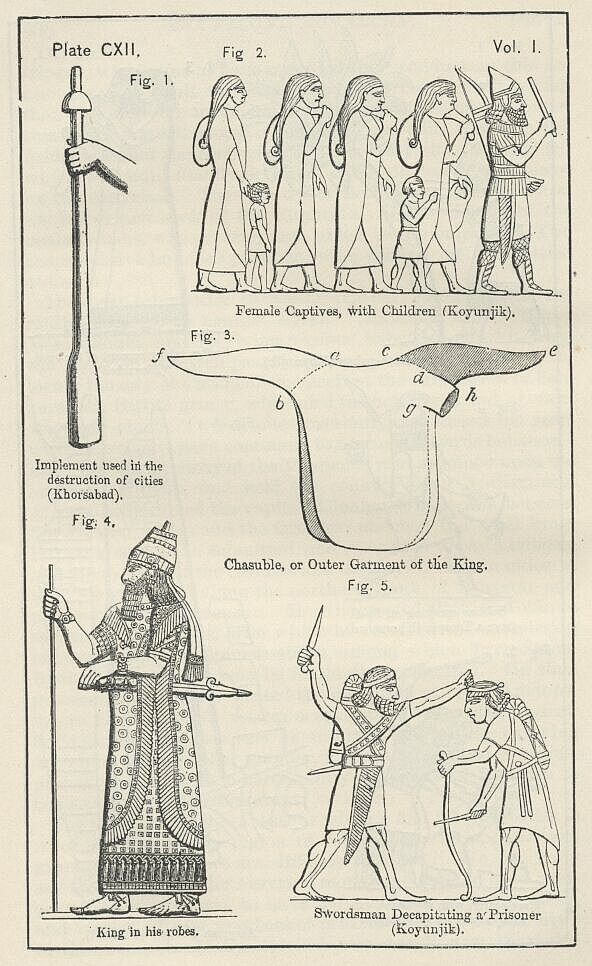
The women and children carried off by the conquerors were treated with more tenderness than the men. [PLATE CXII., Fig. 2.] Sometimes on foot, but often mounted on mules, or seated in carts drawn by bullocks or asses, they followed in the train of their new masters, not always perhaps unwilling to exchange the monotony of domestic life at home for the excitement of a new and unknown condition in a fresh country. We seldom see them exhibiting any signs of grief. The women and children are together, and the mothers lavish on their little ones the usual caresses and kind offices, taking them in their laps, giving then the breast, carrying them upon their shoulders, or else leading them by the hand. At intervals they were allowed to stop and rest; and it was not even the practice to deprive them of such portion of their household stuff as they might have contrived to secure before quitting their homes. This they commonly bore in a bag or sack, which was either held in the hand or thrown over one shoulder, When they reached Assyria, it would seem that they were commonly assigned as wives to the soldiers of the Assyrian army.
Together with their captives, the Assyrians carried off vast quantities of the domesticated animals, such as oxen, sheep, goats, horses, asses, camels, and mules. The numbers mentioned in the Inscriptions are sometimes almost incredible. Sennacherib, for instance, says that in one foray he bore off from the tribes on the Euphrates "7200 horses and mares, 5230 camels, 11,000 mules, 120,000 oxen, and 800,000 sheep"! Other kings omit particulars, but speak of the captured animals which they led away as being "too numerous to be counted," or "countless as the stars of heaven." The Assyrian sculptors are limited by the nature of their art to comparatively small numbers, but they show us horses, camels, and mules in the train of a returning army, together with groups of the other animals, indicative of the vast flocks and herds continually mentioned in the Inscriptions.
Occasionally the monarchs were not content with bringing home domesticated animals only, but took the trouble to transport from distant regions into Assyria wild beasts of various kinds. Tiglath-Pileser I. informs us in general terms that, besides carrying off the droves of the horses, cattle, and asses that he obtained from the subjugated countries, he "took away and drove off the herds of the wild goats and the ibexes, the wild sheep and the wild cattle;" and another monarch mentions that in one expedition he carried off from the middle Euphrates a drove of forty wild cattle, and also a flock of twenty ostriches. The object seems to have been to stock Assyria with a variety and an abundance of animals of chase.
The foes of the Assyrians would sometimes, when hard pressed, desert the dry land, and betake themselves to the marshes, or cross the sea to islands where they trusted that they might be secure from attack. Not unfrequently they obtained their object by such a retreat, for the Assyrians were not a maritime people. Sometimes, however, they were pursued. The Assyrians would penetrate into the marshes by means of reed boats, probably not very different from the terradas at present in use among the Arabs of the Mesopotamian marsh districts. Such boats are represented upon the bas-reliefs as capable of holding from three to five armed men. On these the Assyrian foot-soldiers would embark, taking with them a single boatman to each boat, who propelled the vessel much as a Venetian gondolier propels his gondola, i.e., with a single long oar or paddle, which he pushed from him standing at the stern. They would then in these boats attack the vessels of the enemy, which are always represented as smaller than theirs, run them down or board them, kill their crews or force them into the water, or perhaps allow them to surrender. Meanwhile, the Assyrian cavalry was stationed round the marsh among the tall reeds which thickly clothed its edge, ready to seize or slay such of the fugitives as might escape from the foot.
When the refuge sought was an island, if it lay near the shore, the Assyrians would sometimes employ the natives of the adjacent coast to transport beams of wood and other materials by means of their boats, in order to form a sort of bridge or mole reaching from the mainland to the isle whereto their foes had fled. Such a design was entertained, or at least professed, by Xerxes after the destruction of his fleet in the battle of Salamis, and it was successfully executed by Alexander the Great, who took in this way the new or island of Tyre. From a series of reliefs discovered at Khorsabad wo may conclude that more than two hundred years before the earlier of these two occasions, the Assyrians had conceived the idea, and even succeeded in carrying out the plan, of reducing islands near the coast by moles.
Under the Chaldaeans, whose "cry was in their ships," the Assyrians seem very rarely to have adventured themselves upon the deep. If their enemies fled to islands which could not be reached by moles, or to lands across the sea, in almost every instance they escaped. Such escapes are represented upon the sculptures, where we see the Assyrians taking a maritime town at one end, while at the other the natives are embarking their women and children, and putting to sea, without any pursuit being made after them. In none of the bas-reliefs do we observe any sea-going vessels with Assyrians on board and history tells us of but two or three expeditions by sea in which they took part. One of these was an expedition by Sennacharib against the coast of the Persian Gulf, to which his Chaldaean enemies had fled. On this occasion he brought shipwrights from Phoenicia to Assyria, and made them build him ships there, which were then launched upon the Tigris, and conveyed down to the sea. With a fleet thus constructed, and probably manned, by Phoenicians, Sennacherib crossed to the opposite coast, defeated the refugees, and embarking his prisoners on board, returned in triumph to the mainland. Another expedition was that of Shalmaneser IV. against the island Tyre. Assyrians are said to have been personally engaged in it; but here again we are told that they embarked in ships furnished to then by the Phoenicians, and maimed chiefly by Phoenician sailors.
When a country was regarded as subjugated, the Assyrian monarch commonly marked the establishment of his sovereignty by erecting a memorial in some conspicuous or important situation within the territory conquered, as an enduring sign of his having taken possession. These memorials were either engraved on the natural rock or on solid blocks of stone cut into the form of a broad low stele. They contained a figure of the king, usually enclosed in an arched frame; and an inscription, of greater or less length, setting forth his name, his titles, and some of his exploits. More than thirty such memorials are mentioned in the extant Inscriptions, and the researches of recent times have recovered some ten or twelve of them. They uniformly represent the king in his sacerdotal robes, with the sacred collar round his neck, and the emblems of the gods above his head, raising the right hand in the act of adoration, as if he were giving thanks to Asshur and his guardian deities on account of his successes.
It is now time to pass from the military customs of the Assyrians to a consideration of their habits and usages in time of peace, so far as they are made known to us either by historical records or by the pictorial evidence of the has reliefs. And here it may be convenient to treat separately of the public life of the king and court, and of the private life of the people.
In Assyria, as in most Oriental countries, the keystone of the social arch, the central point of the system, round which all else revolved, and on which all else depended, was the monarch. "L'etat, c'est moi" might have been said with more truth by an Assyrian prince than even by the "Grand Monarque," whose dictum it is reported to have been. Alike in the historical notices, and in the sculptures, we have the person of the king presented to us with consistent prominence, and it is consequently with him that we most naturally commence the present portion of our inquiry.
The ordinary dress of the monarch in time of peace was a long flowing robe, reaching to the ankles, elaborately patterned and fringed, over which was worn, first, a broad belt, and then a species of open mantle, or chasuble, very curiously contrived. [PLATE CXII., Fig. 3.] This consisted mainly of two large flaps, both of which were commonly rounded, though sometimes one of them was square at bottom. These fell over the robe in front and behind, leaving the sides open, and so exposing the under dress to view. The two flaps must have been sewn together at the places marked with the dotted lines a b and c d, the space from a to c being left open, and the mantle passed by that means over the head. At d g there was commonly a short sleeve (h), which covered the upper part of the left arm, but the right arm was left free, the mantle falling of either side of it. Sometimes, besides the flaps, the mantle seems to have had two pointed wings attached to the shoulders (a f b and c e h in the illustration), which were made to fall over in front. Occasionally there was worn above the chasuble a broad diagonal belt ornamented with a deep fringe and sometimes there depended at the back of the dress a species of large hood.
The special royal head-dress was a tall mitre or tiara, which at first took the shape of the head, but rose above it to a certain height in a gracefully curved line, when it was covered in with a top, flat, like that of a hat, but having a projection towards the centre, which rose up into a sort of apex, or peak, not however pointed, but either rounded or squared off. The tiara was generally ornamented with a succession of bands, between which were commonly patterns more or less elaborate. Ordinarily the lowest band, instead of running parallel with the others, rose with a gentle curve towards the front, allowing room for a large rosette over the forehead, and for other similar ornaments. If we may trust the representations on the enamelled bricks, supported as they are to some extent by the tinted reliefs, we may say that the tiara was of three colors, red, yellow, and white. The red and white alternated in broad bands; the ornaments upon them were yellow, being probably either embroidered on the material of the head-dress in threads of gold, or composed of thin gold plates which may have been sown on. The general material of the tiara is likely to have been cloth or felt; it can scarcely have been metal, if the deep crimson tint of the bricks and the reliefs is true. [PLATE CXII., Fig. 4.]
In the early sculptures the tiara is more depressed than in the later, and it is also less richly ornamented. It has seldom more than two bands, viz., a narrow one at top, and at bottom a broader curved one, rising towards the front. To this last are attached two long strings or lappets, which fall behind the monarch's back to a level with his elbow. [PLATE CXIII., Fig. 1.]
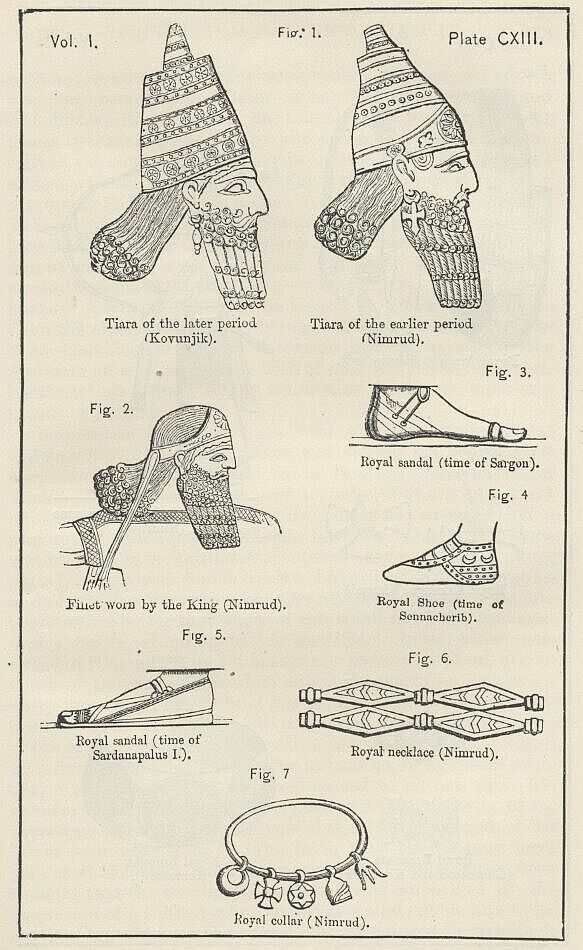
Another head-dress which the monarch sometimes wore was a sort of band or fillet. This was either elevated in front and ornamented with a single rosette, like the lowest band of the tiara, or else of uniform width and patterned along its whole course. In either case there depended from it, on each side of the back hair, a long ribbon or streamer, fringed at the end and sometimes ornamented with a delicate pattern. [PLATE CXIII., Fig 2.]
The monarch's feet were protected by sandals or shoes. In the early sculptures sandals only appear in use, shoes being unknown (as it would seem) until the time of Sennacherib. The sandals worn were of two kinds. The simplest sort had a very thin sole and a small cap for the heel, made apparently of a number of strips of leather sewn together. It was held in place by a loop over the great-toe, attached to the fore part of the sole, and by a string which was laced backwards and forwards across the instep, and then tied in a bow. [PLATE CXIII., Fig. 4.]
The other kind of sandal had a very different sort of sole; it was of considerable thickness, especially at the heel, from which it gradually tapered to the toe. Attached to this was an upper leather which protected the heel and the whole of the side of the foot, but left the toes and the instep exposed. A loop fastened to the sole received the great-toe, and at the point where the loop was inserted two straps were also made fast, which were then carried on either side the great-toe to the top of the foot, where they crossed each other, and, passing twice through rings attached to the edge of the upper leather, were finally fastened, probably by a buckle, at the top of the instep. [PLATE CXIII., Fig. 6.]
The shoe worn by the later kings was of a coarse and clumsy make, very much rounded at the toe, patterned with rosettes, crescents, and the like, and (apparently) laced in front. In this respect it differed from the shoe of the queen, which will be represented presently, and also from the shoes worn by the tribute-bearers. [PLATE CXIII, Fig. 5.]
The accessory portions of the royal costume were chiefly belts, necklaces, armlets, bracelets, and earrings. Besides the belt round the waist, in which two or three highly ornamented daggers were frequently thrust, and the broad fringed cross-belt, of which mention was made above, the Assyrian monarch wore a narrow cross-belt passing across his right shoulder, from which his sword hung at his left side. This belt was sometimes patterned with rosettes. It was worn over the front flap of the chasuble, but under the back flap, and was crossed at right angles by the broad fringed belt, which was passed over the right arm and head so as to fall across the left shoulder.
The royal necklaces were of two kinds. Some consisted merely of one or more strings of long lozenge-shaped beads slightly chased, and connected by small links, ribbed perpendicularly. [PLATE CXIII., Fig. 7.] The other kind was a band or collar, perhaps of gold, on which were hung a number of sacred emblems: as the crescent or emblem of the Moon-God, Sin; the four-rayed disk, the emblem of the Sun-God, Shamas; the six-rayed or eight-rayed disk, the emblem of Gula, the Sun-Goddess; the horned cap, perhaps the emblem of the king's guardian genius; and the double or triple bolt, which was the emblem of Vul, the god of the atmosphere. This sacred collar was a part of the king's civil and not merely of his sacerdotal dress; as appears from the fact that it was sometimes worn when the king was merely receiving prisoners. [PLATE CXIII., Fig. 8.]
The monarch wore a variety of armlets. The most common was a plain bar of a single twist, the ends of which slightly overlapped each other. A more elegant kind was similar to this, except that the bar terminated in animal heads carefully wrought, among which the heads of rams, horses, and ducks were the most common. A third sort has the appearance of being composed of a number of long strings or wires, confined at intervals of less than an inch by cross bands at right angles to the wires. This sort was carried round the arm twice, and even then its ends overlapped considerably. It is probable that all the armlets were of metal, and that the appearance of the last was given to it by the workman in imitation of an earlier and ruder armlet of worsted or leather. [PLATE CXIV., Fig. 1. ]
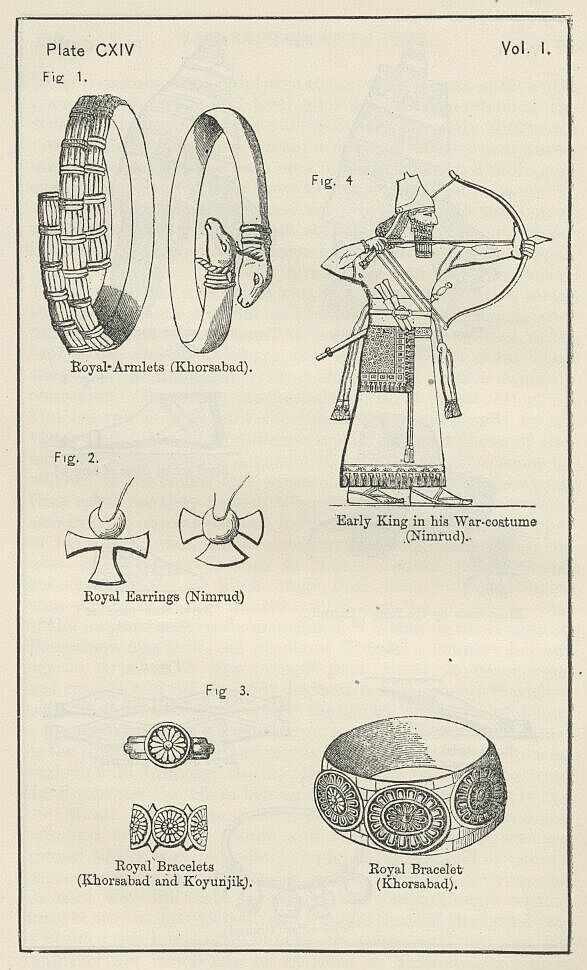
The bracelets of the king, like his armlets, were sometimes mere bars of metal, quite plain and without ornament. More often, however, they were ribbed and adorned with a large rosette at the centre. Sometimes, instead of one simple rosette, we see three double rosettes, between which project small points, shaped like the head of a spear. Occasionally these double rosettes appear to be set on the surface of a broad bar, which is chased so as to represent brickwork. In no case can we see how the bracelets were fastened; perhaps they were elastic, and were slipped over the hand. [PLATE CXIV., Fig. 3.]
Specimens of royal earrings have been already given in an earlier chapter of this volume. The most ordinary form in the more ancient times was a long drop, which was sometimes delicately chased Another common kind was an incomplete Maltese cross, one arm of the four being left out because it would have interfered with the ear. [PLATE CXIV., Fig. 2.] In later times there was a good deal of variety in the details; but the drop and the cross were always favorite features.
When the monarch went out to the hunt or to the battle, he laid aside such ornaments as encumbered him, reserving however his earrings, bracelets, and armlets, and then, stripping off his upper dress or chasuble, appeared in the under robe which has been already described. This robe was confined at the waist by a broad cincture or girdle, outside of which was worn a narrowish belt wherein daggers were often thrust. In early times this cincture seems to have been fastened by a ribbon with long streaming ends, which are very conspicuous in the Nimrud sculptures. At the same period the monarch often wore, when he hunted or went out to battle, a garment which might have been called an apron, if it had not been worn behind instead of in front. This was generally patterned and fringed very richly, besides being ornamented with one or more long pendent tassels. [PLATE CXIV., Fig. 4.]
The sacerdotal dress of the king, or that which he commonly wore when engaged in the rites of his religion, differed considerably from his ordinary costume. His inner garment, indeed, seems to have been the usual long gown with a fringe descending to the ankles; but this was almost entirely concealed under an ample outer robe, which was closely wrapped round the form and kept in place by a girdle. A deep fringe, arranged in two rows, one above the other, and carried round the robe in curved sweeps at an angle with the horizontal line, is the most striking feature of this dress, which is also remarkable for the manner in which it confines and conceals the left arm, while the right is left free and exposed to view. A representation of a king thus apparelled will be found in an earlier part of this work, taken from a statue now in the British Museum. It is peculiar in having the head uncovered, and in the form of the implement borne in the right hand. It is also incomplete as a representation, from the fact that all the front of the breast is occupied by an inscription. Other examples show that the tiara was commonly worn as a part of the sacerdotal costume; that the sacred collar adorned the breast, necklaces the neck, and bracelets the two arms; while in the belt, which was generally to some extent knotted, were borne two or three daggers. The mace seems to have been a necessary appendage to the costume, and was always grasped just below its head by the left hand.
We have but one representation of an Assyrian queen. Despite the well-known stories of Semiramis and her manifold exploits, it would seem that the Assyrians secluded their females with as rigid and watchful a jealousy as modern Turks or Persians. The care taken with respect to the direction of the passages in the royal hareem has been noticed already. It is quite in accordance with the spirit thus indicated, and with the general tenor of Oriental habits, that neither in inscriptions nor in sculptured representations do the Assyrians allow their women to make more than a most rare and occasional appearance. Fortunately for us, their jealousy was sometimes relaxed to a certain extent; and in one scene, recovered from the debris of an Assyrian palace we are enabled to contemplate at once the domestic life of the monarch and the attire and even the features of his consort.
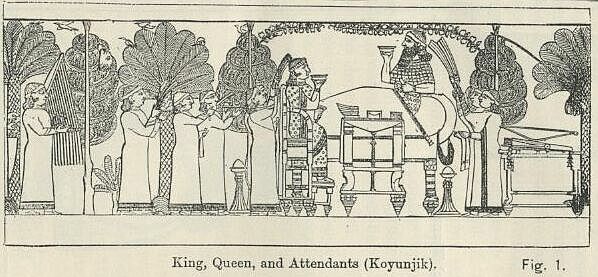
It appears that in the private apartments, while the king, like the Romans and the modern Orientals, reclined upon a couch leaning his weight partly upon his left elbow, and having his right arm free and disposable, her majesty the queen sat in a chair of state by the couch's side, near its foot, and facing her lord. [PLATE CXV., Fig. 1.] Two eunuchs provided with large fans were in attendance upon the monarch, and the same number waited upon the queen, standing behind her chair. Her majesty, whose hair was arranged nearly like that of her royal consort, wore upon her head a band or fillet having something of the appearance of a crown of towers, such as encircles the brow of Cybele on Greek coins and statues. Her dress was a long-sleeved gown reaching from the neck to the feet, flounced and trimmed at the bottom in an elaborate way, and elsewhere patterned with rosettes, over which she wore a fringed tunic or frock descending half-way between the knees and the feet. [PLATE CXV., Fig. 3.] In addition to these two garments, she wore upon her back and shoulders a light cloak or cape, patterned (like the rest of her dress) with rosettes and edged with a deep fringe. Her feet were encased in shoes of a clumsy make, also patterned. Her ornaments, besides the crown upon her head, were earrings, a necklace, and bracelets. Her hair was cushioned, and adorned with a drapery which hung over the back. Her feet rested on a handsome footstool, also cushioned.
On the slab from which this description is taken the royal pair seem to be refreshing themselves with wine. Each supports on the thumb and fingers of the right hand a saucer or shallow drinking-cup, probably of some precious metal, which they raise to their lips simultaneously, as if they were pledging one another. The scene of the entertainment is the palace garden; for trees grow on either side of the main figures, while over their heads, a vine hangs its festoons and its rich clusters. By the side of the royal couch, and in front of the queen, is a table covered with a table-cloth, on which are a small box or casket, a species of shallow bowl which may have held incense or perfume of some kind, and a third article frequently seen in close proximity to the king, but of whose use it is impossible to form a conjecture. At the couch's head stands another curious article, a sort of tall vase surmounted by a sugarloaf, which probably represents an altar. The king bears in his left hand the lotus or sacred flower, while the queen holds in hers what looks like a modern fan. All the lower part of the monarch's person is concealed beneath a coverlet, which is plain, except that it has tassels at the corners and an embroidered border.
The officers in close attendance upon the monarch varied according to his employment. In war he was accompanied by his charioteer, his shield-bearer or shield-bearers, his groom, his quiver-bearer, his mace-bearer, and sometimes by his parasol-bearer. In peace the parasol-bearer is always represented as in attendance, except in hunting expeditions, or where he is replaced by a fan-bearer. The parasol, which exactly resembled that still in use throughout the East, was reserved exclusively for the monarch. [PLATE CXVI., Fig. 1.] It had a tall and thick pole, which the bearer grasped with both his hands, and in the early times a somewhat small circular top. Under the later kings the size of the head was considerably enlarged; and, at the same time, a curtain or flap was attached, which, falling from the edge of the parasol, more effectually protected the monarch from the sun's rays. The head of the parasol was fringed with tassels, and the upper extremity of the pole commonly terminated in a flower or other ornament. In the later time both the head and the curtain which depended from it were richly patterned. If we may trust the remains of color upon the Khorsabad sculptures, the tints preferred were red and white, which alternated in bands upon the parasol as upon the royal tiara.
There was nothing very remarkable in the dress or quality of the royal attendants. Except the groom, the charioteer, and the shield-bearers, they were in the early times almost invariably eunuchs; but the later kings seem to have preferred eunuchs for the offices of parasol-bearer and fan-bearer only. The dress of the eunuchs is most commonly a long fringed gown, reaching from the neck to the feet, with very short sleeves, and a broad belt or girdle confining the gown at the waist. Sometimes they have a cross-belt also; and occasionally both this and the girdle round the waist are richly fringed. The eunuchs commonly wear earrings, and sometimes armlets and bracelets; in a few instances they have their necks adorned with necklaces, and their long dresses elaborately patterned. Their heads are either bare, or at most encircled with a fillet.
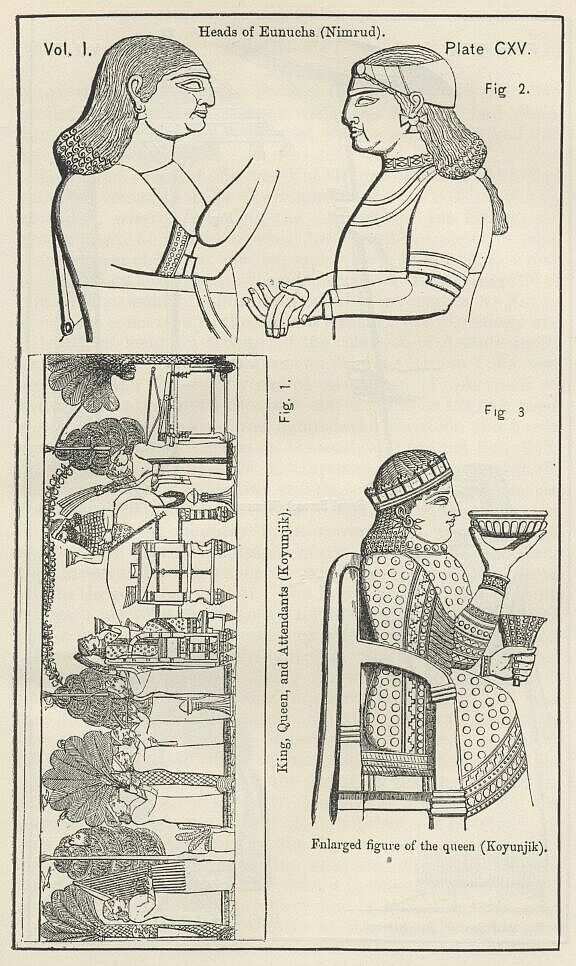
A peculiar physiognomy is assigned to this class of persons—the forehead low, the nose small and rounded, the lips full, the chin large and double, the cheeks bloated. [PLATE CXV., Fig. 2.] They are generally represented as shorter and stouter than the other Assyrians. Though placed in confidential situations about the person of the monarch, they seem not to have held very high or important offices. The royal Vizier is never a eunuch, and eunuchs are rarely seen among the soldiers; they are scribes, cooks, musicians, perhaps priests; as they are grooms-in-waiting, huntsmen, parasol-bearers, and fan-bearers; but it cannot be said with truth that they had the same power in Assyria which they have commonly possessed in the more degraded of the Oriental monarchies. It is perhaps a sound interpretation of the name Rabsaris in Scripture to understand it as titular, not appellative, and to translate it "the Chief Eunuch" or "the Master of the Eunuchs;" and if so, we have an instance of the employment by one Assyrian king of a person of this class on an embassy to a petty sovereign: but the sculptures are far from bearing out the notion that eunuchs held the same high position in the Assyrian court as they have since held generally in the East, where they have not only continually filled the highest offices of state, but have even attained to sovereign power. On the contrary, their special charge seems rather to have been the menial offices about the person of the monarch, which imply confidence in the fidelity of those to whom they are entrusted, but not submission to their influence in the conduct of state affairs. And it is worthy of notice that, instead of becoming more influential as time went on, they appear to have become less so; in the later sculptures the royal attendants are far less generally eunuchs than in the earlier ones; and the difference is most marked in the more important offices.
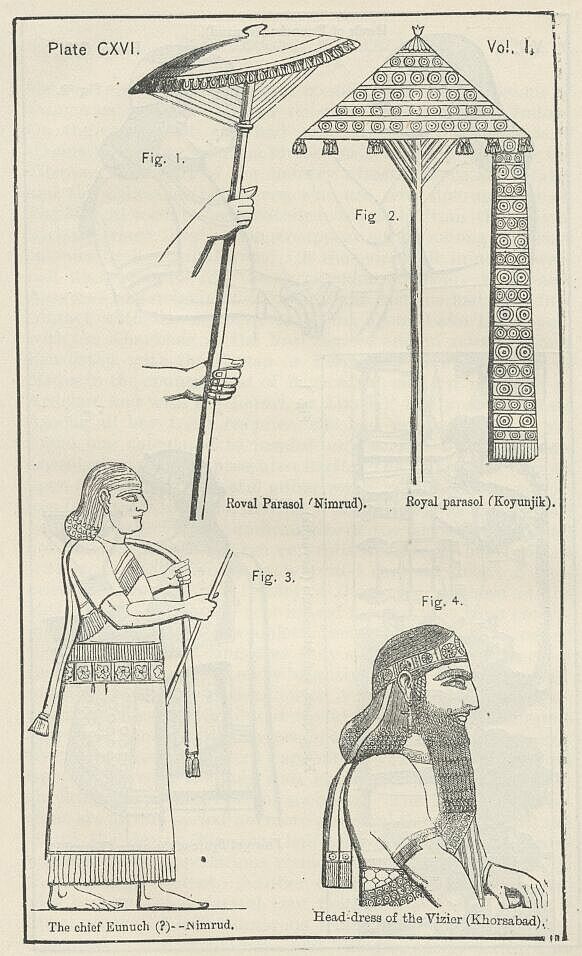
It is not quite certain that the Chief Eunuch is represented upon the sculptures. Perhaps we may recognize him in an attendant, who commonly bears a fan, but whose special badge of office is a long fringed scarf or band, which hangs down below his middle both before him and behind him, being passed over the left shoulder. [PLATE CXVI., Fig. 2.] This officer appears, in one bas-relief, alone in front of the king; in another, he stands on the right hand of the Vizier, level with him, facing the king as he drinks; in a third, he receives prisoners after a battle; while in another part of the same sculpture he is in the king's camp preparing the table for his master's supper. There is always a good deal of ornamentation about his dress, which otherwise nearly resembles that of the inferior royal attendants, consisting of a long fringed gown or robe, a girdle fringed or plain, a cross-belt generally fringed, and the scarf already described. His head and feet are generally bare, though sometimes the latter are protected by sandals. He is found only upon the sculptures of the early period.
Among the officers who have free access to the royal person, there is one who stands out with such marked prominence from the rest that he has been properly recognized as the Grand Vizier or prime minister at once the chief counsellor of the monarch, and the man whose special business it was to signify and execute his will. The dress of the Grand Vizier is more rich than that of any other person except the monarch; and there are certain portions of his apparel which he and the king have alone the privilege of wearing. These are, principally, the tasselled apron and the fringed band depending from the fillet, the former of which is found in the early period only, while the latter belongs to no particular time, but throughout the whole series of sculptures is the distinctive mark of royal or quasi-royal authority. To these two may be added the long ribbon or scarf, with double streamers at the ends, which depended from, and perhaps fastened, the belt—a royal ornament worn also by the Vizier in at least one representation. [PLATE CXVI., Fig. 3.]
The chief garment of the Vizier is always a long fringed robe, reaching from the neck to the feet. This is generally trimmed with embroidery at the top, round the sleeves, and round the bottom. It is either seen to be confined by a broad belt round the waist, or else is covered from the waist to the knees by two falls of a heavy and deep fringe. In this latter case, a broad cross-belt is worn over the left shoulder, and the upper fall of fringe hangs from the cross-belt. A fillet is worn upon the head, which is often highly ornamented. The feet are sometimes bare, but more often are protected by sandals, or (as in the accompanying representation) by embroidered shoes. Earrings adorn the ears; bracelets, sometimes accompanied by armlets, the arms. A sword is generally worn at the left side.
The Vizier is ordinarily represented in one of two attitudes. Either he stands with his two hands joined in front of him, the right hand in the left, and the fingers not clasped, but left loose—the ordinary attitude of passive and respectful attention, in which officers who carry nothing await the orders of the king,—or he has the right arm raised, the elbow bent, and the right hand brought to a level with his month, while the left hand rests upon the hilt of the sword worn at his left side. [PLATE CXVII., Fig. 1.] In this latter case it may be presumed that we have the attitude of conversation, as in the former we have that of attentive listening. When the Vizier assumes this energetic posture he is commonly either introducing prisoners or bringing in spoil to the king. When he is quiescent, he stands before the throne to receive the king's orders, or witnesses the ceremony with which it was usual to conclude a successful hunting expedition.
The pre-eminent rank and dignity of this officer is shown, not only by his participation in the insignia of royal authority, but also and very clearly by the fact that, when he is present, no one ever intervenes between him and the king. He has the undisputed right of precedence, so that he is evidently the first subject of the crown, and he alone, is seen addressing the monarch. He does not always accompany the king on his military expeditions but when he attends them, he still maintains his position, having a dignity greater than that of any general, and so taking the entire direction of the prisoners and of the spoil.
The royal fan-bearers were two in number. They were invariably eunuchs. Their ordinary position was behind the monarch, on whom they attended alike in the retirement of private life and in religious and civil ceremonies. On some occasions, however, one of the two was privileged to leave his station behind the king's chair or throne, and, advancing in front, to perform certain functions before the face of his master. He handed his master the sacred cup, and waited to receive it back, at the same time diligently discharging the ordinary duties of his office by keeping up a current of air and chasing away those plagues of the East—the flies. The fan-bearer thus privileged wears always the long tasselled scarf, which seems to have been a badge of office, and may not improbably mark him for the chief Eunuch. In the absence of the Vizier, or sometimes in subordination to him, he introduced the tribute-bearers to the king, reading out their names and titles from a scroll or tablet which he held in his left hand. [PLATE CXVII., Fig. 2.]
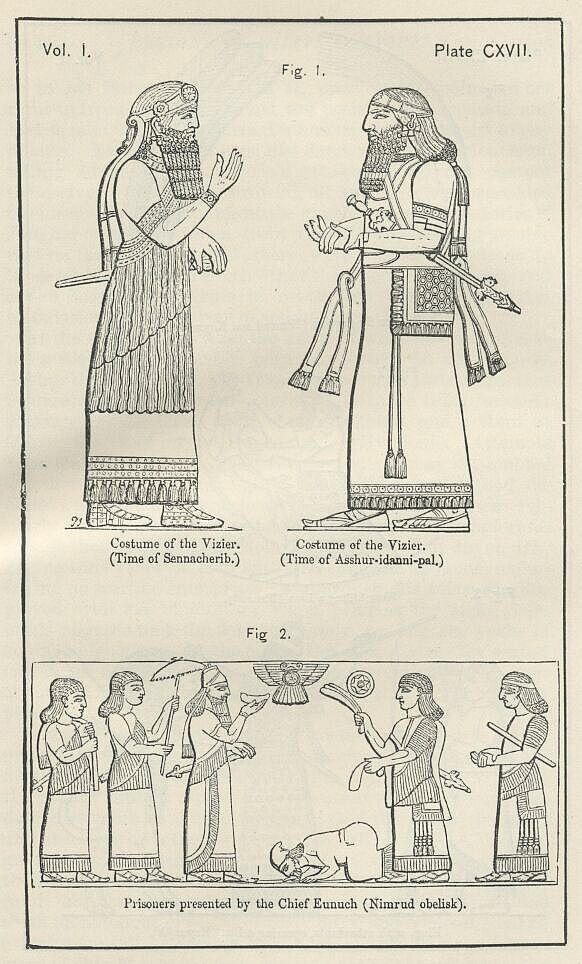
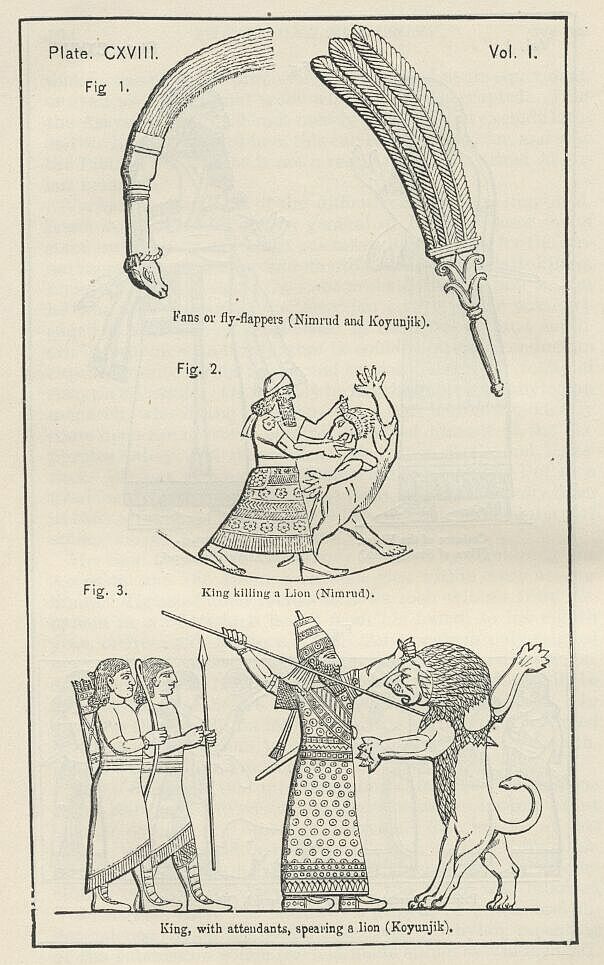
The fan carried by these attendants seems in most instances to have been made of feathers. It had a shortish handle, which was generally mere or less ornamented, and frequently terminated in the head of a ram or other animal. [PLATE CXVIII., Fig. 1.] The feathers were sometimes of great length, and bent gracefully by their own weight, as they were pointed slantingly towards the monarch. Occasionally a comparatively short fan was used, and the feathers were replaced by a sort of brush, which may have been made of horse-hair, or possibly of some vegetable fibre.
The other attendants on the monarch require no special notice. With regard to their number, however, it may be observed that, although the sculptures generally do not represent them as very numerous, there is reason to believe that they amounted to several hundreds. The enormous size of the palaces can scarcely be otherwise accounted for: and in one sculpture of an exceptional character, where the artist seems to have aimed at representing his subject in full, we can count above seventy attendants present with the monarch at one time. Of these less than one-half are eunuch; and these wear the long robe with the fringed belt and cross-belt. The other attendants wear in many cases the same costume; sometimes, however, they are dressed in a tunic and greaves, like the soldiers.
There can be no doubt that the court ceremonial of the Assyrians was stately and imposing. The monarch seems indeed not to have affected that privacy and seclusion which forms a predominant feature of the ceremonial observed in most Oriental monarchies. He showed himself very freely to his subjects on many occasions. He superintended in person the accomplishment of his great works. In war and in the chase he rode in an open chariot, never using a litter, though litters were not unknown to the Assyrians. In his expeditions he would often descend from his chariot, and march or fight on foot like the meanest of his subjects. But though thus familiarizing the multitude with his features and appearance, he was far from allowing familiarity of address. Both in peace and war he was attended by various officers of state, and no one had speech of him except through them. It would even seem as if two persons only were entitled to open a conversation with him—the Vizier and the Chief Eunuch. When he received them, he generally placed himself upon his throne, sitting, while they stood to address him. It is strongly indicative of the haughty pride of these sovereigns that they carried with them in their distant expeditions the cumbrous thrones whereon they were wont to sit when they dispensed justice or received homage. On these thrones they sat, in or near their fortified camps, when the battle or the siege was ended, and thus sitting they received in state the spoil and the prisoners. Behind them on such occasions were the two fan-bearers, while near at hand were guards, scribes, grooms, and other attendants. In their palace halls undoubtedly the ceremonial used was stricter, grander, and more imposing. The sculptures, however, furnish no direct evidence on this point, for there is nothing to mark the scene of the great processional pieces.
In the pseudo-history of Ctesias, the Assyrian kings were represented as voluptuaries of the extremest kind, who passed their whole lives within the palace, in the company of their concubines and their eunuchs, indulging themselves in perpetual ease, pleasure, and luxury. We have already seen how the warlike character of so many monarchs gives the lie to these statements, so far as they tax the Assyrian kings with sloth and idleness. It remains to examine the charge of over-addiction to sensual delights, especially to those of the lowest and grossest description. Now it is at least remarkable that, so far as we have any real evidence, the Assyrian kings appear as monogamists. In the inscription on the god Nebo, the artist dedicates his statue to his "lord Vol-lush (?) and his lady, Sammuramit." In the solitary sculptured representation of the private life of the king, he is seen in the company of one female only. Even in the very narrative of Ctesias, Ninus has but one wife, Semiramis; and Sardanapalus, notwithstanding his many concubines, has but five children, three sons and two daughters. It is not intended to press these arguments to an extreme, or to assume, on the strength of them, that the Assyrian monarchs were really faithful to one woman. They may have had—nay, it is probable that they had—a certain number of concubines; but there is really not the least ground for believing that they carried concubinage to an excess, or over-stepped in this respect the practice of the best Eastern sovereigns. At any rate they were not the voluptuaries which Ctesias represented them. A considerable portion of their lives was passed in the toils and dangers of war; and their peaceful hours, instead of being devoted to sloth and luxury in the retirement of the palace, were chiefly employed, as we shall presently see, in active and manly exercises in the field, which involved much exertion and no small personal peril.
The favorite occupation of the king in peace was the chase of the lion. In the early times he usually started on a hunting expedition in his chariot, dressed as when he went out to war, and attended by his charioteer, some swordsmen, and a groom holding a led horse. He carried a bow and arrows, a sword, one or two daggers, and a spear, which last stood in a rest made for it at the back of the chariot. Two quivers, each containing an axe and an abundant supply of arrows, hung from the chariot transversely across its right side, while a shield armed with teeth was suspended behind. When a lion was found, the king pursued it in his chariot, letting fly his arrows as he went, and especially seeking to pierce the animal about the heart and head. Sometimes he transfixed the beast with three or four shafts before it succumbed. Occasionally the lion attacked him in his chariot, and was met with spear and shield, or with a fresh arrow, according to the exigencies of the moment, or the monarch's preference for one or the other weapon. On rare occasions the monarch descended to the ground, and fought on foot. He would then engage the lion in close combat with no other weapon but a short sword, which he strove to plunge, and often plunged, into his heart. [PLATE CXVIII., Fig. 2.]
In the later time, though the chariot was still employed to some extent in the lion-hunts, it appears to have been far more usual for the king to enjoy the sport on foot. He carried a straight sword, which seems to have been a formidable weapon; it was strong, very broad, and two feet or a little more in length. Two attendants waited closely upon the monarch, one of whom carried a bow and arrows, while the other was commonly provided with one or two spears. From these attendants the king took the bow or spear at pleasure, usually commencing the attack with his arrows, and finally despatching the spent animal with sword or spear, as he deemed best. Sometimes, but not very often, the spearman in attendance carried also a shield, and held both spear and shield in advance of his master to protect him from the animal's spring. Generally the monarch faced the danger with no such protection, and received the brute on his sword, or thrust him through with his pike. [PLATE CXVIII., Fig. 3;] [PLATE CXIX., Fig. 1.] Perhaps the sculptures exaggerate the danger which he affronted at such moments; but we can hardly suppose that there was not a good deal of peril incurred in these hand-to-hand contests.
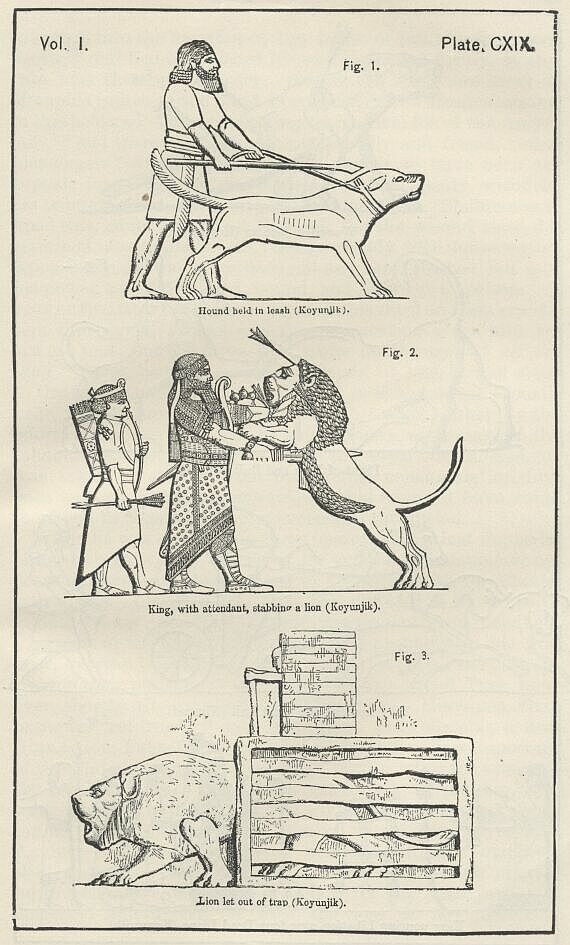
Two modes of hunting the king of beasts were followed at this time. Either he was sought in his native haunts, which were then, as now, the reedy coverts by the side of the canals and great streams; or he was procured beforehand, conveyed to the hunting-ground, and there turned out before the hunters. In the former case the monarch took the field accompanied by his huntsmen and beaters on horse and foot, these last often holding dogs in leash, which, apparently, were used only to discover and arouse the game, but were not slipped at it when started. No doubt the hunt was sometimes entirely on the land, the monarch accompanying his beaters along one or other of the two banks of a canal or stream. But a different plan is known to have been adopted on some occasions. Disposing his beaters to the right and left upon both banks, the monarch with a small band of attendants would take ship, and, while his huntsmen sought to start the game on either side, he would have himself rowed along so as just to keep pace with them, and would find his sport in attacking such lions as took the water. The monarch's place on these occasions was the middle of the boat. Before him and behind him were guards armed with spears, who were thus ready to protect their master, whether the beast attacked him in front or rear. The monarch used a round bow, like that commonly carried in war, and aimed either at the heart or at the head. The spearmen presented their weapons at the same time, while the sides of the boat were also sufficiently high above the water to afford a considerable protection against the animal's spring. An attendant immediately behind the monarch held additional arrows ready for him; and after piercing the noble brute with three or four of these weapons, the monarch had commonly the satisfaction of seeing him sink down and expire. The carcass was then taken from the water, the fore and hind legs were lashed together with string, and the beast was suspended from the hinder part of the boat, where he hung over the water just out of the sweep of the oars.
At other times, when it was felt that the natural chase of the animal might afford little or no sport, the Assyrians (as above stated) called art to their assistance, and, having obtained a supply of lions from a distance, brought them in traps or cages to the hunting-ground, and there turned them out before the monarch. The walls of the cage was made of thick spars of wood, with interstices between them, through which the lion could both see and be seen: probably the top was entirely covered with boards, and upon these was raised a sort of low hut or sentry-box, just large enough to contain a man, who, when the proper moment arrived, peeped forth from his concealment and cautiously raised the front of the trap, which was a kind of drop-door working in a groove. [PLATE CXIX., Fig. 2.] The trap being thus opened, the lion stole out, looking somewhat ashamed of his confinement, but doubtless anxious to vent his spleen on the first convenient object. The king, prepared for his attack, saluted him, as he left his cage, with an arrow, and, as he advanced, with others, which sometimes stretched him dead upon the plain, sometimes merely disabled him, while now and then they only goaded him to fury. In this case he would spring at the royal chariot, clutch some part of it, and in his agony grind it between his teeth, or endeavor to reach the inmates of the car from behind. If the king had descended from the car to the plain, the infuriated beast might make his spring at the royal person, in which case it must have required a stout heart to stand unmoved, and aim a fresh arrow at a vital part while the creature was in mid-air, especially if (as we sometimes see represented) a second lion was following close upon the first, and would have to be received within a few seconds. It would seem that the lions on some occasions were not to be goaded into making an attack, but simply endeavored to escape by flight. To prevent this, troops were drawn up in a double line of spearmen and archers round the space within which the lions were let loose, the large shields of the front or spearmen line forming a sort of wall, and the spears a chevaux de frise, through which it was almost impossible for the beasts to break. In front of the soldiers, attendants held hounds in leashes, which either by their baying and struggling frightened the animals back, or perhaps assisted to despatch them. [PLATE CXIX., Fig. 3.] The king meanwhile plied his bow, and covered the plain with carcasses, often striking a single beast with five or six shafts.
The number of lions destroyed at these royal battues is very surprising. In one representation no fewer than eighteen are seen upon the field, of which eleven are dead and five seriously wounded. The introduction of trapped beasts would seem to imply that the game, which under the earlier monarchs had been exceedingly abundant,—failed comparatively under the later ones, who therefore imported it from a distance. It is evident, however, that this scarcity was not allowed to curtail the royal amusement. To gratify the monarch, hunters sought remote and savage districts, where the beast was still plentiful, and, trapping their prey, conveyed it many hundreds of miles to yield a momentary pleasure to the royal sportsman.
It is instructive to contrast with the boldness shown in the lion-hunts of this remote period the feelings and conduct of the present inhabitants of the region. The Arabs, by whom it is in the main possessed, are a warlike race, accustomed from infancy to arms and inured to combat. "Their hand is against every man, and every man's hand is against them." Yet they tremble if a lion is but known to be near, and can only with the utmost difficulty be persuaded by an European to take any part in the chase of so dangerous an animal.
The lioness, no less than the lion, appears as a beast of chase upon the sculptures. It seems that in modern times she is quite as much feared as her consort. Indeed, when she has laid up cubs, she is even thought to be actually the more dangerous of the two. [PLATE CXX., Fig. 1.]
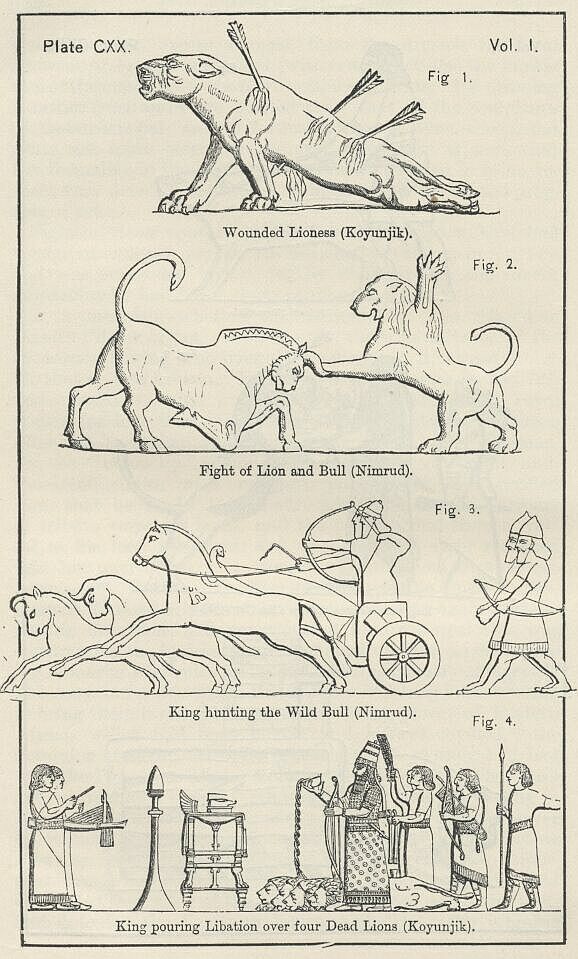
Next to the chase of the lion and lioness, the early Assyrian monarchs delighted in that of the wild bull. It is not quite certain what exact species of animal is sought to be expressed by the representations upon the sculptures; but on the whole it is perhaps most probable that the Aurochs or European bison (Bos urus of naturalists) is the beast intended. At any rate it was an animal of such strength and courage that, according to the Assyrian belief, it ventured to contend with the lion. [PLATE CXX., Fig. 2.] The Assyrian monarchs chased the wild bull in their chariots without dogs, but with the assistance of horsemen, who turned the animals when they fled, and brought them within the monarch's reach. [PLATE CXX., Fig. 3.] The king then aimed his arrows at them, and the attendant horsemen, who were provided with bows, seem to have been permitted to do the same. The bull seldom fell until he had received a number of wounds; and we sometimes see as many as five arrows still fixed in the body of one that has succumbed. It would seem that the bull, when pushed, would, like the lion, make a rush at the king's chariot, in which case the monarch seized him by one of the horns and gave him the coup de grace with his sword.
The special zest with which this animal was pursued may have arisen in part from its scarcity. The Aurochs is wild and shy; it dislikes the neighborhood of man, and has retired before him till it is now found only in the forests of Lithuania, Carpathia, and the Caucasus. It seems nearly certain that, in the time of the later kings, the species of wild cattle previously limited, whatever it was, had disappeared from Assyria altogether; at least this is the only probable account that can be given of its non-occurrence in the later sculptures, more especially in those of Asshur-bani-pal, the son of Esarhaddon, which seem intended to represent the chase under every aspect known at the time. We might therefore presume it to have been, even in the early period, already a somewhat rare animal. And so we find in the Inscriptions that the animal, or animals, which appear to represent wild cattle, were only met with in outlying districts of the empire—on the borders of Syria and in the country about Harrah; and then in such small numbers as to imply that even there they were not very abundant.
When the chase of the nobler animals—the lion and the wild bull—had been conducted to a successful issue, the hunters returned in a grand procession to the capital, carrying with then as trophies of their prowess the bodies of the slain. These were borne aloft on the shoulders of men, three or four being required to carry each beast. Having been brought to an appointed spot, they were arranged side by side upon the ground, the heads of all pointing the same way; and the monarch, attended by several of his principal officers, as the Vizier, the Chief Eunuch, the fan-bearers, the bow and mace bearers, and also by a number of musicians, came to the place, and solemnly poured a libation over the prostrate forms, first how-ever (as it would seem) raising the cup to his own lips. It is probable that this ceremony had to some extent a religious character. The Assyrian monarchs commonly ascribe the success of their hunting expeditions to the gods Nin (or Ninip) and Nergal; and we may well understand that a triumphant return would be accompanied by a thank-offering to the great protectors under whose auspices success had been achieved. [PLATE CXX., Fig. 4.]
Besides the wild bull and the lion, the Assyrians are known to have hunted the following animals: the onager or wild ass, the stag, the ibex or wild goat, the gazelle, and the hare.
The chase of the wild ass was conducted in various ways. The animal was most commonly pursued with dogs. The large and powerful hounds of the Assyrians, of which a certain use was made even in the chase of the lion, have been already noticed; but it may be desirable in this place to give a fuller account of them. They were of a type approaching to that of our mastiff, being smooth haired, strong limbed, with a somewhat heavy head and neck, small pointed but drooping ears, and a long tail, which was bushy and a little inclined to curl. They seem to have been very broad across the chest, and altogether better developed as to their fore than as to their hind parts, though even their hind legs were tolerably strong and sinewy. They must have been exceedingly bold, if they really faced the hunted lion; and their pace must have been considerable, if they were found of service in chasing the wild ass.
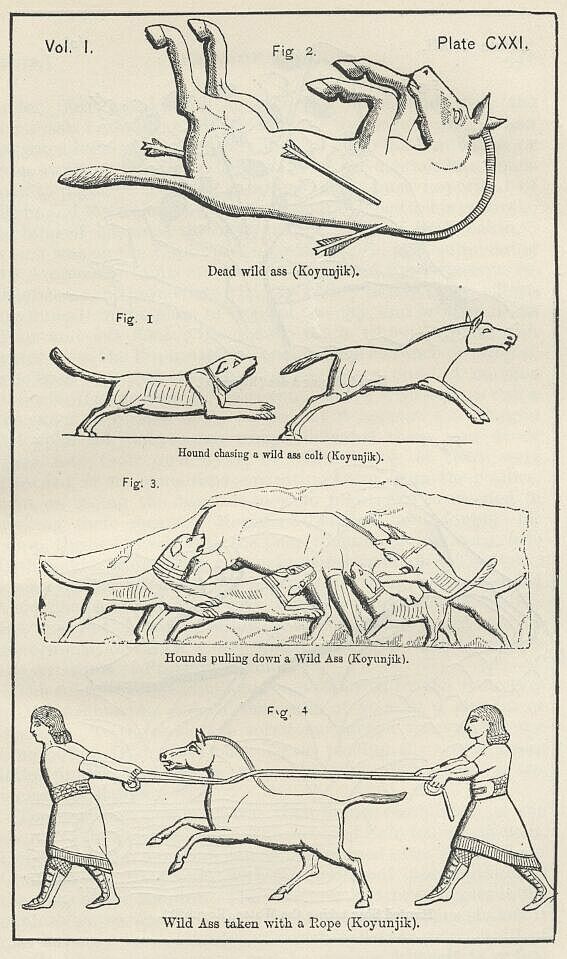
The hunters are represented as finding the wild asses in herds, among which are seen a certain number of foals. The King and his chief attendants pursue the game on horseback, armed with bows and arrows, and discharging their arrows as they go. Hounds also—not now held in leash, but free—join in the hunt, pressing on the game, and generally singling out some one individual from the herd, either a young colt or sometimes a full-grown animal. [PLATE CXXI., Fig. 1.] The horsemen occasionally brought down the asses with their shafts. [PLATE CXXI.. Fig. 2.] When their archery failed of success, the chase depended on the hounds, which are represented as running even the full-grown animal to a stand, and then worrying him till the hunters came up to give the last blow. Considering the speed of the full-grown wild ass, which is now regarded as almost impossible to take, we may perhaps conclude that the animals thus run down by the hounds were such as the hunters had previously wounded; for it can scarcely be supposed that such heavily-made dogs as the Assyrian could really have caught an unwounded and full-grown wild ass. [PLATE CXXI., Fig. 3.]
Instead of shooting the wild ass, or hunting him to the death with hounds, an endeavor was sometimes made to take him alive. [PLATE CXXI., Fig. 4] A species of noose seems to have been made by means of two ropes interlaced, which were passed—how, we cannot say—round the neck of the animal, and held him in such a way that all his struggles to release himself were vain. This mode of capture recalls the use of the lasso by the South Americans and the employment of nooses by various nations, not merely in hunting, but in warfare. It is doubtful, however, if the Assyrian practice approached at all closely to any of these. The noose, if it may be so called, was of a very peculiar kind. It was not formed by means of a slip-knot at the end of a single cord, but resulted from the interlacing of two ropes one with the other. There is great difficulty in understanding how the ropes were got into their position. Certainly no single throw could have placed then, round the neck of the animal in the manner represented, nor could the capture have been effected, according to all appearance, by a single hunter. Two persons, at least, must have been required to combine their efforts—one before and one behind the creature which it was designed to capture.
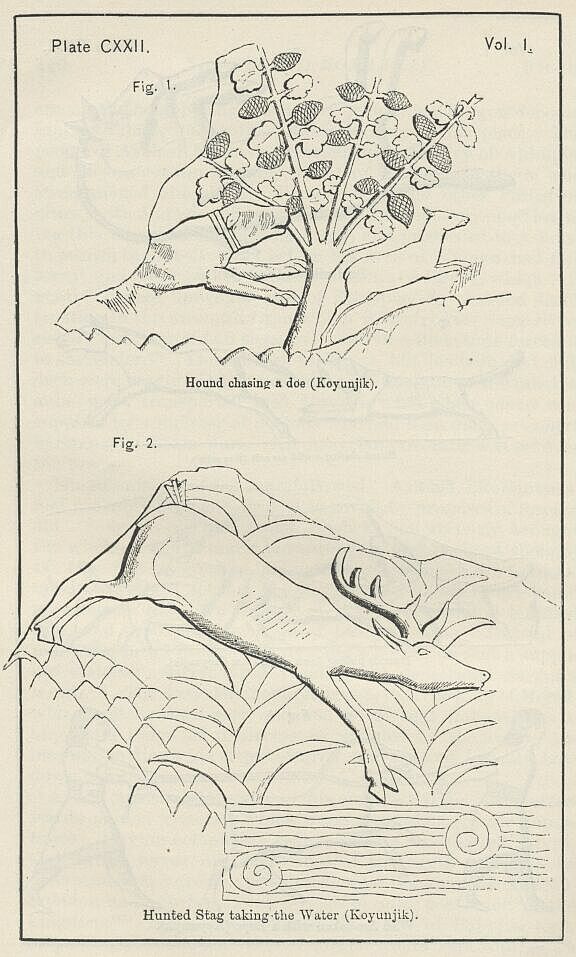
Deer, which have always abounded in Assyria were either hunted with dogs, or driven by beaters into nets, or sometimes shot with arrows by sportsmen. The illustration [PLATE CXXII., Fig. 1] represents a dog in chase of a hind, and shows that the hounds which the Assyrians used for this purpose were of the same breed as those employed in the hunt of the lion and of the wild ass. In [PLATE CXXII., Fig. 2.] we have a stricken stag, which may, perhaps, have been also hard pressed by hounds, in the act of leaping from rocky ground into water. It is interesting to find this habit of the stag, with which the modern English sportsman is so familiar, not merely existing in Assyria, but noticed by Assyrian sculptors, at the distance of more than twenty-five centuries from our own time.
When deer were to be taken by nets, the sportsman began by setting in an upright position, with the help of numerous poles and pegs, a long, low net, like the [dikrvov] of the Greeks. [PLATE CXXII., Fig. 1.] This was carried round in a curved line of considerable length, so as to enclose an ample space on every side excepting one, which was left open for the deer to enter. The meshes of the net were large and not very regular. They were carefully secured by knots at all the angles. The net was bordered both at top and at bottom by a rope of much greater strength and thickness than that which formed the network; and this was fastened to the ground at the two extremities by pegs of superior size. [PLATE CXXIII., Fig. 2.] The general height of the net was about that of a man, but the two ends were sloped gently to the ground. Beaters, probably accompanied by dogs, roused the game in the coverts, which was then driven by shouts and barkings towards the place where the net was set. If it once entered within the two extremities of the net (a b, [PLATE CXXIII., Fig. 1]), its destruction was certain; for the beaters, following on its traces, occupied the space by which it had entered, and the net itself was not sufficiently visible for the deer to rise at it and clear it by a leap.
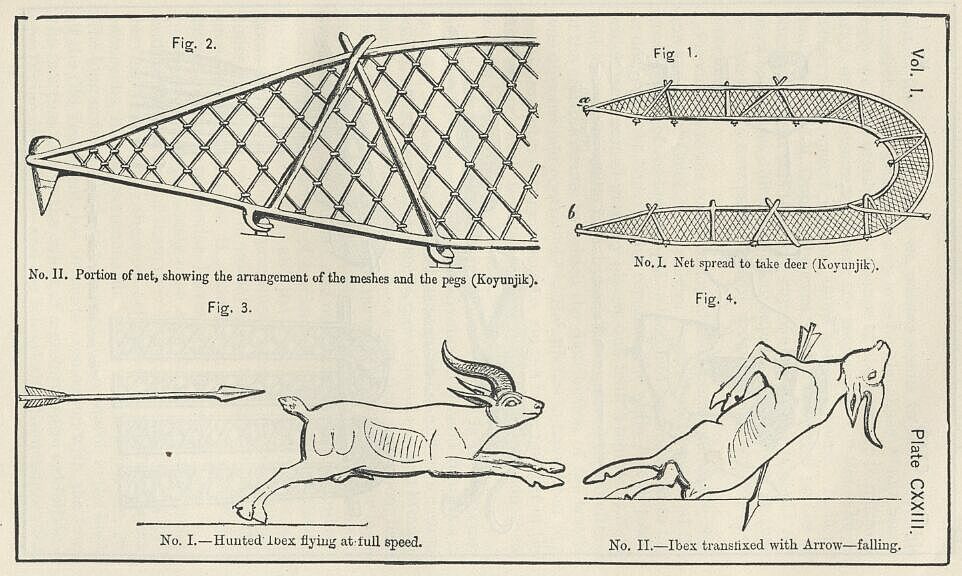
In the chase of the ibex or wild goat, horsemen were employed to discover the animals, which are generally found in herds, and to drive them towards the sportsman, who waited in ambush until the game appeared within bowshot. [PLATE CXXIII., Fig. 3.] An arrow was then let fly at the nearest or the choicest animal, which often fell at the first discharge. [PLATE CXXIII., Fig. 4.] The sport was tame compared with many other kinds, and was probably not much affected by the higher orders.
The chase of the gazelle is not shown on the sculptures. In modern times they are taken by the grayhound and the falcon, separately or in conjunction, the two being often trained to hunt together. They are somewhat difficult to run down with dogs only, except immediately after they have drunk water in hot weather. That the Assyrians sometimes captured them, appears by a hunting scene which Mr. Layard discovered at Khorsabad, where an attendant is represented carrying a gazelle on his shoulders, and holding a hare in his right hand. [PLATE CXXIV., Fig. 1.] As gazelles are very abundant both in the Sinjar country and in the district between the Tigris and the Zagros range, we may suppose that the Assyrians sometimes came upon them unawares, and transfixed them with their arrows before they could make their escape. They may also have taken them in nets, as they were accustomed to take deer; but we have no evidence that they did so.
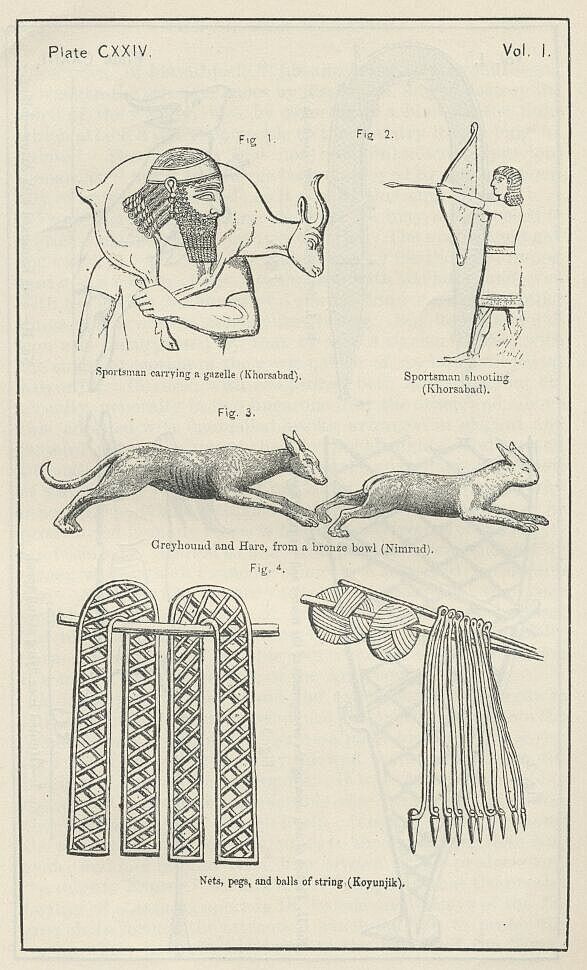
The hare is seen very commonly in the hands of those who attend upon the huntsmen. It is always represented as very small in proportion to the size of the men, whence we may perhaps conclude that the full-grown animal was less esteemed than the leveret. As the huntsmen in these representations have neither nets nor dogs, but seem to obtain their game solely by the bow, we must presume that they were expert enough to strike the hare as it ran.
There is no difficulty in making such a supposition as this, since the Assyrians have left us an evidence of their skill as marksmen which implies even greater dexterity. The game which they principally sought in the districts where they occasionally killed the hare and the gazelle seems to have been the partridge; and this game they had to bring down when upon the wing. We see the sportsmen in the sculptures aiming their arrows at the birds as they mount into the air [PLATE CXXIV., Fig. 21,] and in one instance we observe one of the birds in the act of falling to the ground, transfixed by a well aimed shaft. Such skill is not uncommon among savage hunting tribes, whose existence depends on the dexterity with which they employ their weapons; but it is rarely that a people which has passed out of this stage, and hunts for sport rather than subsistence, retains its old expertness.
Hunting the hare with dogs was probably not very common, as it is only in a single instance that the Assyrian remains exhibit a trace of it. On one of the bronze dishes discovered by Mr. Layard at Nimrud may be seen a series of alternate dogs and hares, which shows that coursing was not unknown to the Assyrians. [PLATE CXXIV., Fig. 3.] The dog is of a kind not seen elsewhere in the remains of Assyrian art. The head bears a resemblance to that of the wolf; but the form generally is that of a coarse grayhound, the legs and neck long, the body slim, and the tail curved at the end; offering thus a strong contrast to the ordinary Assyrian hound, which has been already represented more than once.
Nets may sometimes have been employed for the capture of small game, such as hares and rabbits, since we occasionally see beaters or other attendants carrying upon poles, which they hold over their shoulders, nets of dimensions far too small for them to have been used in the deer-hunts, with balls of string and pegs wherewith to extend them. [PLATE CXXIV., Fig. 4.] The nets in this case are squared at the ends, and seem to have been about eight or nine feet long, and less than a foot in height. They have large meshes, and, like the deer nets, are bordered both at top and bottom with a strong cord, to which the net-work is attached. Like the classical [evodia], they were probably placed across the runs of the animals, which, being baffled by then and turned from their accustomed tracks, would grow bewildered, and fall an easy prey to the hunters. Or, possibly, several of them may have been joined together, and a considerable space may then have been enclosed, within which the game may have been driven by the beaters. The ease of these three weak and tinnier animals, the gazelle, the hare, and the partridge, was not regarded as worthy of the monarch. When the king is represented as present, he takes no part in it, but merely drives in his chariot through the woods where the sportsmen are amusing themselves. Persons, however, of a good position, as appears from their dress and the number of their attendants, indulged in the sport, more especially eunuchs, who were probably those of the royal household. It is not unlikely that the special object was to supply the royal table with game.
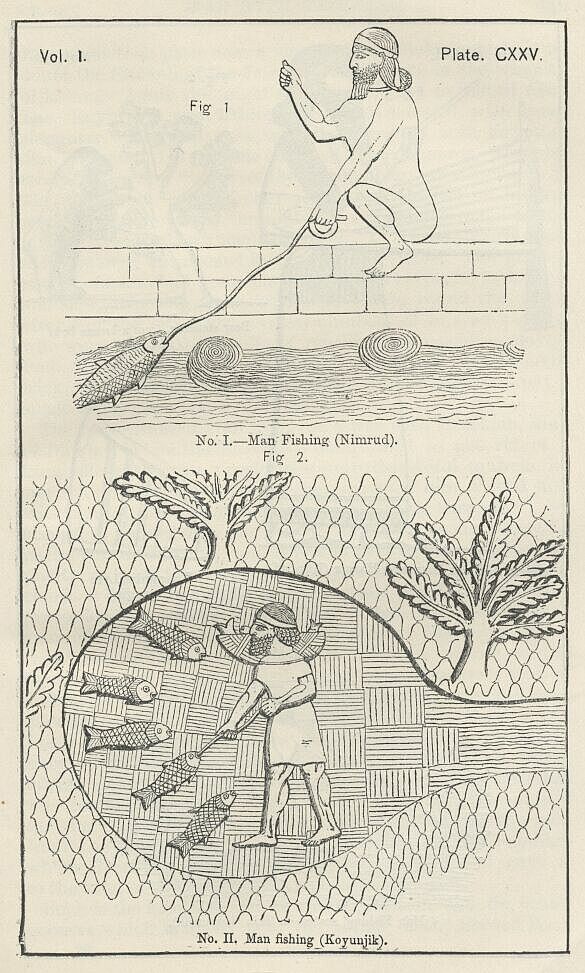
The Assyrians do not seem to have had much skill as fishermen. They were unacquainted with the rod, and fished by means of a simple line thrown into the water, one end of which was held in the hand. [PLATE CXXV., Figs. 1, 2.] No float was used, and the bait must consequently have sunk to the bottom, unless prevented from so doing by the force of the stream. This method of fishing was likewise known and practised in Egypt, where, however, it was far more common to angle with a rod. Though Assyrian fish-hooks have not been found, there can be no doubt that that invention was one with which they were acquainted, as were both the Egyptians and the early Chaldaeans.
Fishing was carried on both in rivers and in stews or ponds. The angler sometimes stood or squatted upon the bank; at other times, not content with commanding the mere edge of the water, he plunged in, and is seen mid-stream, astride upon an inflated skin, quietly pursuing his avocation. [PLATE CXXVI., Fig. 1.] Occasionally he improved his position by amounting upon a raft, and, seated at the stern, with his back to the rower, threw out his line and drew the fish from the water. Now and then the fisherman was provided with a plaited basket, made of rushes or flags, which was fastened round his neck with a string, and hung at his back, ready to receive the produce of his exertions.
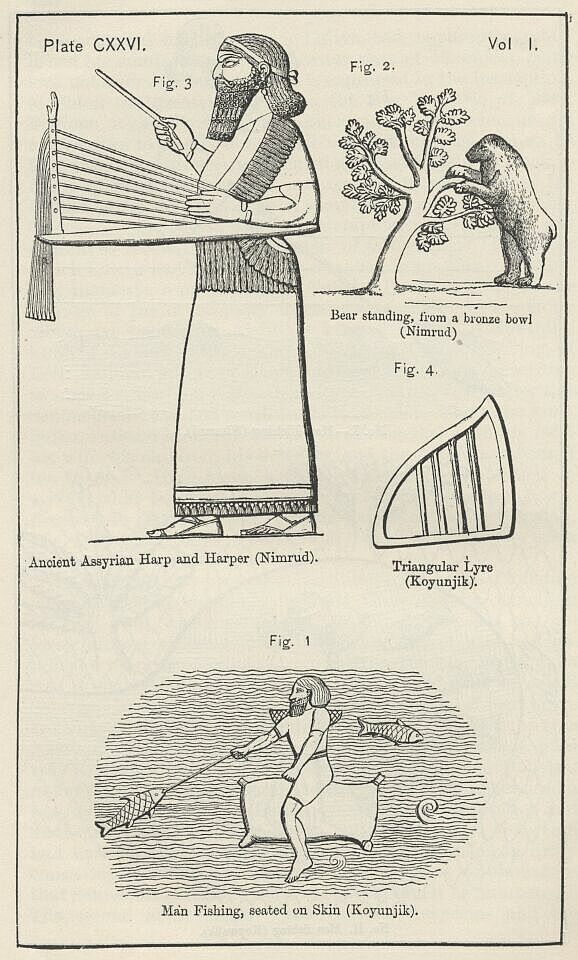
It does not appear that angling was practised by the Assyrians the way that the monuments show it to have been practised in Egypt, as an amusement of the rich. The fishermen are always poorly clothed, and seem to have belonged to the class which worked for its living. It is remarkable that do not anywhere in the sculptures see nets used for fishing; but perhaps we ought not to conclude from this that they were never so employed in Assyria. The Assyrian sculptors represented only occasionally the scenes of common everyday life; and we are seldom justified in drawing a negative conclusion as to the peaceful habits of the people on any point from the mere fact that the bas-reliefs contain no positive evidence on the subject.
A few other animals were probably, but not certainly, chased by the Assyrians, as especially the ostrich and the bear. The gigantic bird, which remained in Mesopotamia as late as the time of Xenophon, was well known to the Assyrian artists, who could scarcely have represented it with so much success, unless its habits had been described by hunters. The bear is much less frequent upon the remains than the ostrich; but its occurrence and the truthfulness of its delineation where it occurs, indicate a familiarity which may no doubt be due to other causes, but is probably traceable to the intimate knowledge acquired by those who hunted it. [PLATE CXXVI., Fig. 2.]
Of the other amusements and occupations of the Assyrians our knowledge is comparatively scanty; but some pages may be here devoted to their music, their navigation, their commerce, and their agriculture. On the first and second of these a good deal of light is thrown by the monuments, while some interesting facts with respect to the third and fourth may be gathered both from this source and also from ancient writers.
That the Babylonians, the neighbors of the Assyrians, and, in a certain sense, the inheritors of their empire, had a passion for music, and delighted in a great variety of musical instruments, has long been known and admitted. The repeated mention by Daniel, in his third chapter, of the cornet, flute, harp sackbut, psaltery, dulcimer, and all kinds of music—or, at any rate, of a number of instruments for which those terms were once thought the best English equivalents—has familiarized us with the fact that in Babylonia, as early as the sixth century B.C., musical instruments of many different kinds were in use. It is also apparent from the book of Psalms, that a variety of instruments were employed by the Jews. And we know that in Egypt as many as thirteen or fourteen different kinds were common. In Assyria, if there was not so much variety as this, there were at any rate eight or nine quite different sorts, some stringed, some wind, some merely instruments of percussion. In the early sculptures, indeed, only two or three musical instruments are represented. One is a kind of harp, held between the left arm and the side, and played with one hand by means of a quill or plectrum. [PLATE CXXVI., Fig. 3.] Another is a lyre, played by the hand; while a third is apparently cymbal. But in the later times we see besides these instruments—a harp of a different make played with both hands, two or three kinds of lyre, the double pipe, the guitar or cithern, the tambourine, a nameless instrument, and more than one kind of drum.
The harp of the early ages was a triangular instrument, consisting of a horizontal board which seems to have been about three feet in length, an upright bar inserted into one end of the board, commonly surmounted by an imitation of the human hand, and a number of strings which crossed diagonally from the board to the bar, and, passing through the latter, hung down some way, terminating in tassels of no great size. The strings were eight, nine, or ten in number, and (apparently) were made fast to the board, but could be tightened or relaxed by means of a row of pegs inserted into the upright bar, round which the strings were probably wound. No difference is apparent in the thickness of the strings; and it would seem therefore that variety of tone was produced solely by difference of length. It is thought that this instrument must have been suspended round the player's neck. It was carried at the left side, and was played (as already observed) with a quill or electrum held in the right hand, while the left hand seems to have been employed in pressing the strings so as to modify the tone, or stop the vibrations, of the notes. The performers on this kind of harp, and indeed all other Assyrian musicians, are universally represented as standing while they play.
The harp of later times was constructed, held, and played differently. It was still triangular, or nearly so; but the frame now consisted of a rounded and evidently hollow, sounding-board, to which the strings were attached with the help of pegs, and a plain bar whereto they were made fast below, and from which their ends depended like a fringe. The number of strings was greater than in the earlier harp, being sometimes as many as seventeen. The instrument was carried in such a way that the strings were perpendicular and the bar horizontal, while the sounding-board projected forwards at an angle above the player's head. It was played by the naked hand, without a plectrum; and both hands seem to have found their employment in pulling the strings. [PLATE CXXVII., Fig. 1.]
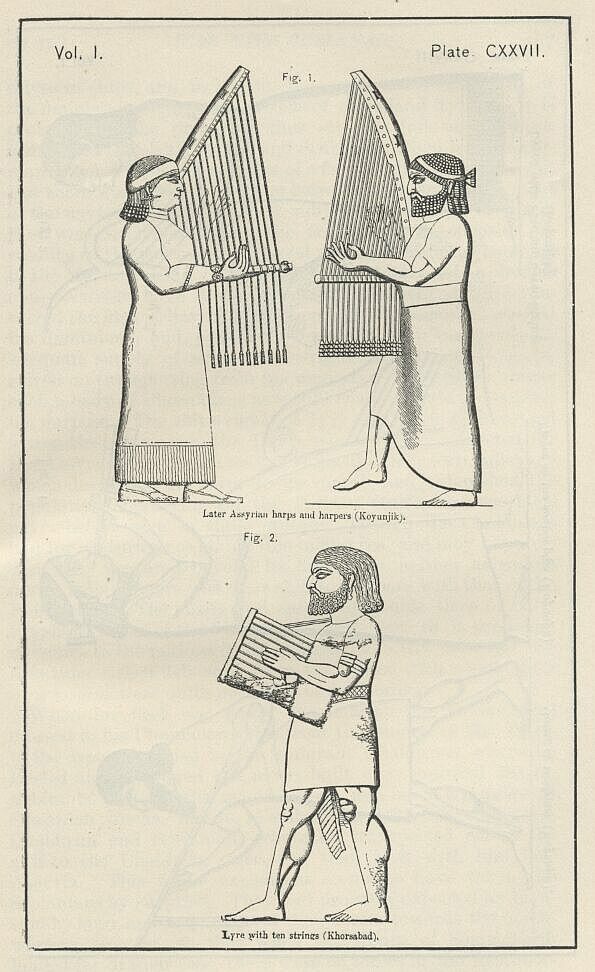
Three varieties of the lyre are seen in the Assyrian sculptures. One of them is triangular, or nearly so, and has only four strings, which, being carried from one side of the triangle to the other, parallel to the base, are necessarily of very unequal length. Its frame is apparently of wood, very simple, and entirely devoid of ornament. This sort of lyre has been found only in the latest sculptures. [PLATE CXXVI., Fig. 4.]
Another variety nearly resembles in its general shape the lyre of the Egyptians. It has a large square bottom or sounding-board, which is held, like the Egyptian, under the left elbow, two straight arms only slightly diverging, and a plain cross-bar at top. The number of strings visible in the least imperfect representation is eight; but judging by the width of the instrument, we may fairly assume that the full complement was nine or ten. The strings run from the cross-bar to the sounding-board, and must have been of a uniform length. This lyre was played by both hands, and for greater security was attached by a band passing round the player's neck. [PLATE CXXVII., Fig. 2.]
The third sort of lyre was larger than either of the others, and considerably more elaborate. It had probably a sounding-board at bottom, like the lyre just described, though this, being carried under the left elbow, is concealed in the representations. Hence there branched out two curved arms, more or less ornamented, which were of very unequal length; and these were joined together by a cross-bar, also curved, and projecting considerably beyond the end of the longer of the two arms. Owing to the inequality of the arms, the cross-bar sloped at an angle to the base, and the strings, which passed from the one to the other, consequently differed in length. The number of the strings in this lyre seems to have been either five or seven. [PLATE CXXVIII., Figs. 2, 3.]
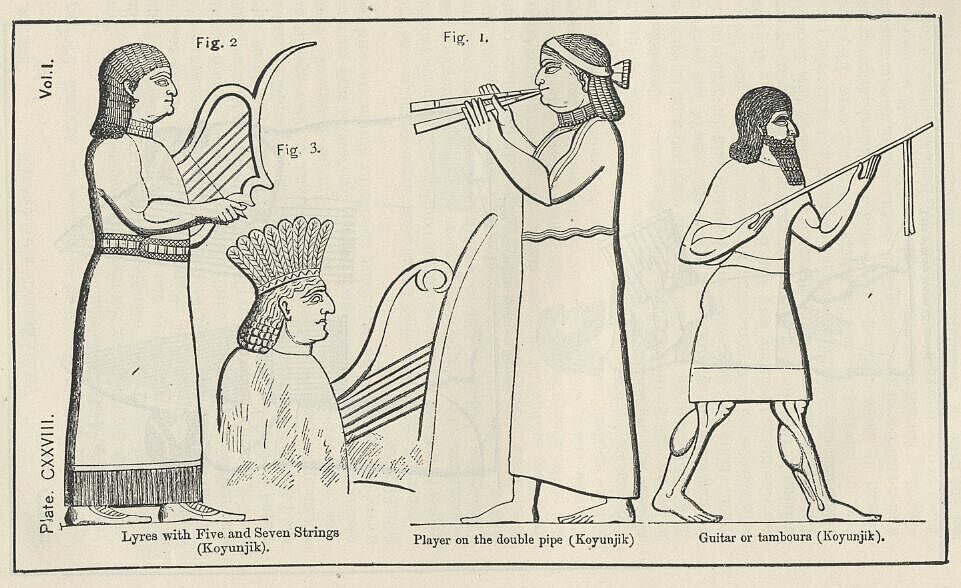
The Assyrian guitar is remarkable for the small size of the hollow body or sounding-board, and the great proportionate length of the neck or handle. There is nothing to show what was the number of the strings, nor whether they were stretched by pegs and elevated by means of a bridge. Both hands seen to be employed in playing the instrument, which is held across the chest in a sloping direction, and was probably kept in place by a ribbon or strap passed round the neck. [PLATE CXXVIII., Fig. 1.]
It is curious that in the Assyrian remains, while the double pipe is common, we find no instance at all either of the flute or of the single pipe. All three were employed in Egypt, and occur on the monuments of that country frequently; and though among the Greeks and Romans the double pipe was more common than the single one, yet the single pipe was well known, and its employment was not unusual. The Greeks regarded the pipe as altogether Asiatic, and ascribed its invention to Marsyas the Phrygian, or to Olympus, his disciple. We may conclude from this that they at any rate learnt the invention from Asia; and in their decided preference of the double over the single pipe we may not improbably have a trace of the influence which Assyria exercised over Asiatic, and thus even over Greek, music. [PLATE CXXVIII., Fig. 1.]
The Assyrian double pipe was short, probably not exceeding ten or twelve inches in length. It is uncertain whether it was really a single instrument consisting of two tubes united by a common mouthpiece, or whether it was not composed of two quite separate pipes, as was the case with the double pipes of the Greeks and Romans.
The two pipes constituting a pair seem in Assyria to have been always of the same length, not, like the Roman "right" and "left pipes," of unequal length, and so of different pitches. They were held and played, like the classical one, with either hand of the performer. There can be little doubt that they were in reality quite straight, though sometimes they have been awkwardly represented as crooked by the artist.
The tambourine of the Assyrian was round, like that in common use at the present day; not square, like the ordinary Egyptian. It seems to have consisted simply of a skin stretched on a circular frame, and to have been destitute altogether of the metal rings or balls which produce the jingling sound of the modern instrument. It was held at bottom by the left hand in a perpendicular position, and was struck at the side with the fingers of the right. [PLATE CXXIX., Fig. 1.]
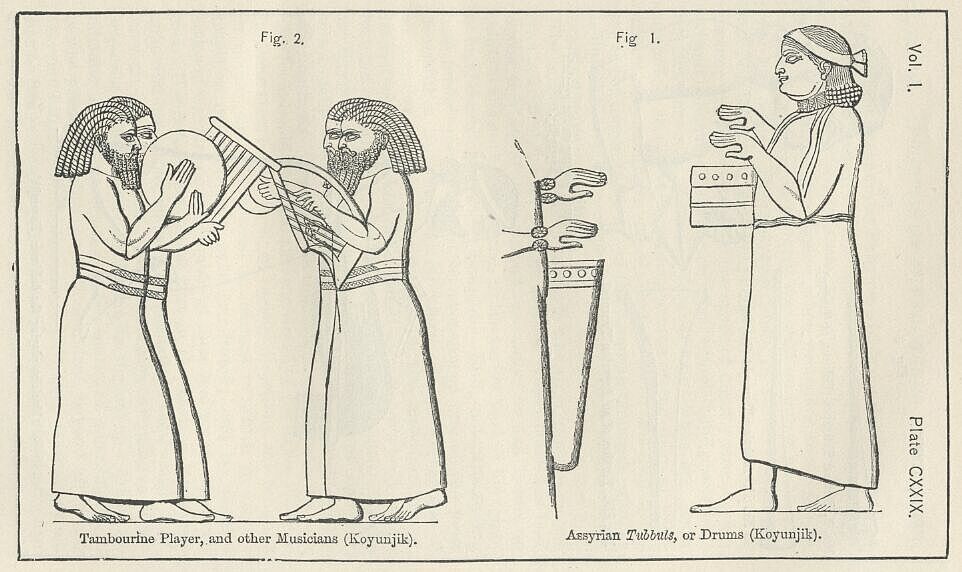
Assyrian cymbals closely resembled those in common use throughout the East at the present day. They consisted of two hemispheres of metal, probably of bronze, running off to a point, which was elongated into a bar or handle. The player grasped a cymbal in each hand, and either clashed theme together horizontally, or else, holding one cupwise in his left, brought the other down upon it perpendicularly with his right. [PLATE CXXX., Fig. 1.]
Two drums are represented on the Assyrian sculptures.
One is a small instrument resembling the tubbul, now frequently used by Eastern dancing girls. The other is of larger size, like the tubbul at top, but descending gradually in the shape of an inverted cone, and terminating almost in a point at bottom. Both were carried in front, against the stomach of the player—attached, apparently, to his girdle; and both were played in the same way, namely, with the fingers of the open hands on the top. [PLATE CXXX., Fig. 2.]
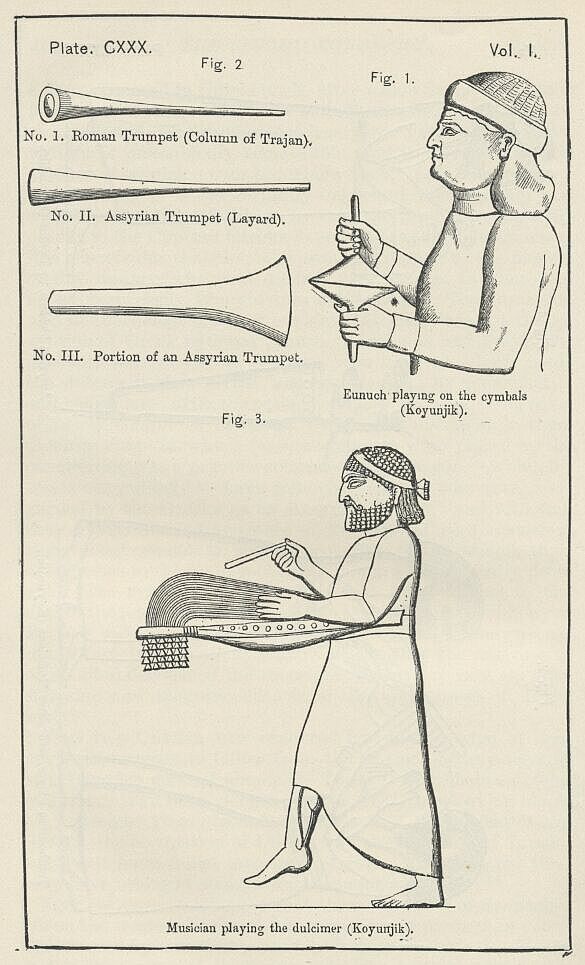
A few instruments carried by musicians are of an anomalous appearance, and do not admit of identification with any known species. One, which is borne by a musician in a processional scene belonging to the time of Sennacherib, resembles in shape a bag turned upside-down. By the manner in which it is held, we may conjecture that it was a sort of rattle—a hollow square box of wood or metal, containing stones or other hard substances which produced a jingling noise when shaken. But the purpose of the semicircular bow which hangs from the box is difficult to explain, unless we suppose that it was merely a handle by which to carry the instrument when not in use. Rattles of different kinds are found among the musical instruments of Egypt; and one of them consists of a box with a long handle attached to it. The jingling noise produced by such instruments may have corresponded to the sound now emitted by the side-rings of the tambourine.
Another curious-looking instrument occurs in a processional scene of the time of Asshur-bani-pal, which has been compared to the modern santour, a sort of dulcimer. It consisted (apparently) of a number of strings, certainly not fewer than ten stretched over a hollow case or sounding-board. The musician seems to have struck the strings with a small bar or hammer held in his right hand, while at the same time he made some use of his left hand in pressing them so as to produce the right note. It is clear that this instrument must have been suspended round the neck, though the Assyrian artist has omitted to represent the belt which kept it in place. [PLATE CXXIX., Fig. 2.]
In addition to all these various instruments, it is possible that the Assyrians may have made use of a sort of horn. An object is represented on a slab of Sennacherib's which is certainly either a horn or a speaking-trumpet. It is carried by one of the supervisors of the works in a scene representing the conveyance of a colossal bull to its destination. In shape it no doubt resembles the modern speaking-trumpet, but it is almost equally near to the tuba or military trumpet of the Greeks and Romans. This will appear sufficiently on a comparison of the two representations, one of which is taken from Mr. Layard's representation of Sennacherib's slab, while the other is from a sculpture on the column of Trajan. As we have no mention of the speaking-trumpet in any ancient writer, as the shape of the object under consideration is that of a known ancient instrument of music, and as an ordinary horn would have been of great use in giving signals to workmen engaged as the laborers are upon the sculpture, it seems best to regard the object in question as such a horn—an instrument of great power, but of little compass—more suitable therefore for signal-giving than for concerts. [PLATE CXXX., Fig. 3.]
Passing now from the instruments of the Assyrians to the general features and character of their music, we may observe, in the first place, that while it is fair to suppose them acquainted with each form of the triple symphony, there is only evidence that they knew of two forms out of the three—viz, the harmony of instruments, and that of instruments and voices in combination. Of these two they seem greatly to have preferred the concert of instruments without voices; indeed, one instance alone shows that they were not wholly ignorant of the more complex harmony. Even this leaves it doubtful whether they themselves practised it: for the singers and musicians represented as uniting their efforts are not Assyrians, but Susianians, who come out to greet their conquerors, and do honor to the new sovereign who has been imposed on them, with singing, playing, and dancing.
Assyrian bands were variously composed. The simplest consisted of two harpers. A band of this limited number seems to have been an established part of the religious ceremonial on the return of the monarch from the chase, when a libation was poured over the dead game. The instrument in use on these occasions was the antique harp, which was played, not with the hand, but with the plectrum. A similar band appears on one occasion in a triumphal return from a military expedition belonging to the time of Sennacherib. [PLATE CXXI.]
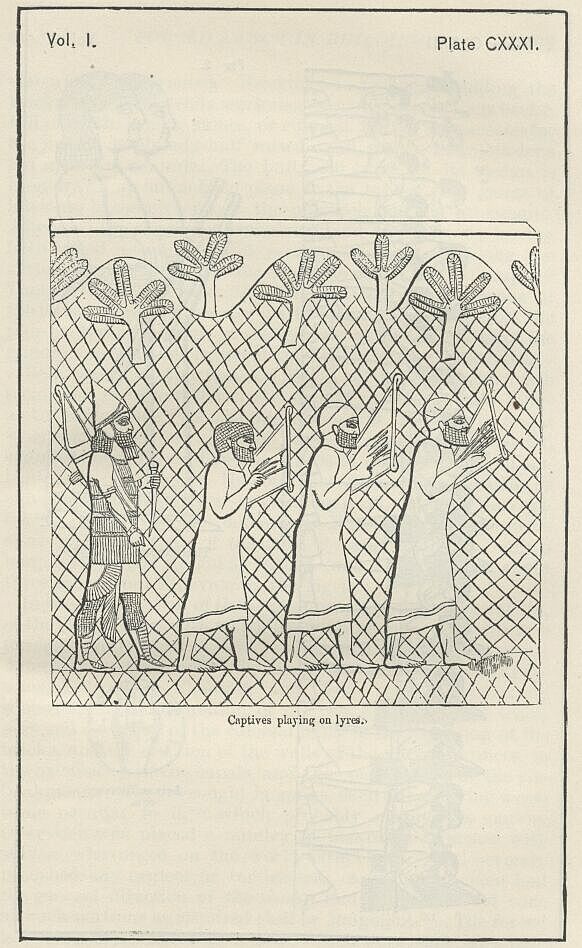
In several instances we find bands of three musicians. In one case all three play the lyre. The musicians here are certainly captives, whom the Assyrians have borne off front their own country. It has been thought that their physiognomy is Jewish, and that the lyre which they bear in their hands may represent that "kind of harp" which the children of the later captivity hung up upon the willows when they wept by the rivers of Babylon. There are no sufficient grounds, however, for this identification. The lyre may be pronounced foreign, since it is unlike any other specimen; but its ornamentation with an animal head is sufficient to show that it is not Jewish. And the Jewish kinnor was rather a harp than a lyre, and had certainly more than four strings. Still, the employment of captives as musicians is interesting, though we cannot say that the captives are Jews. It shows us that the Assyrians, like the later Babylonians, were in the habit of "requiring" music from their prisoners, who, when transported into a "strange land," had to entertain their masters with their native melodies.
Another band of three exhibits to us a harper, a player on the lyre, and a player on the double pipe. A third shows a harper, a player on the lyre, and a musician whose instrument is uncertain. In this latter case it is quite possible that there may originally have been more musicians than three, for the sculpture is imperfect, terminating in the middle of a figure.
Bands of four performers are about as common as bands of three. On an obelisk belonging to the time of Asshur-izir-pal we see a band composed of two cymbal-players and two performers on the lyre. A slab of Sennacherib's exhibits four harpers arranged in two pairs, all playing with the plectrum on the antique harp. Another of the same date, which is incomplete, shows us a tambourine-player, a cymbal-player, a player on the nondescript instrument which has been called a sort of rattle, and another whose instrument cannot be distinguished. In a sculpture of a later period, which is represented above, we see a band of four, composed of a tambourine-player, two players on two different sorts of lyres, and a cymbal-player.
It is not often that we find representations of bands containing more than four performers. On the sculptures hitherto discovered there seem to be only three instances where this number was exceeded. A bas-relief of Sennacherib's showed five players, of whom two had tambourines; two, harps of the antique pattern; and one, cymbals. Another, belonging to the time of his grandson, exhibited a band of seven, three of whom played upon harps of the later fashion, two on the double pipe, one on the guitar, and one on the long drum with the conical bottom. Finally, we have the remarkable scene represented in the illustration, a work of the sane date, where no fewer than twenty-six performers are seen uniting their efforts. Of these, eleven are players on instruments, while the remaining fifteen are vocalists. The instruments consist of seven harps, two double pipes, a small drum or tubbel, and the curious instrument which has been compared to the modern santour. The players are all men, six out of the eleven being eunuchs. The singers consist of six women and nine children of various ages, the latter of whom seem to accompany their singing, as the Hebrews and Egyptians sometimes did, with clapping of the hands. Three out of the first four musicians are represented with one leg raised, as if dancing to the measure. [PLATE CXXXII., Fig. 1.]
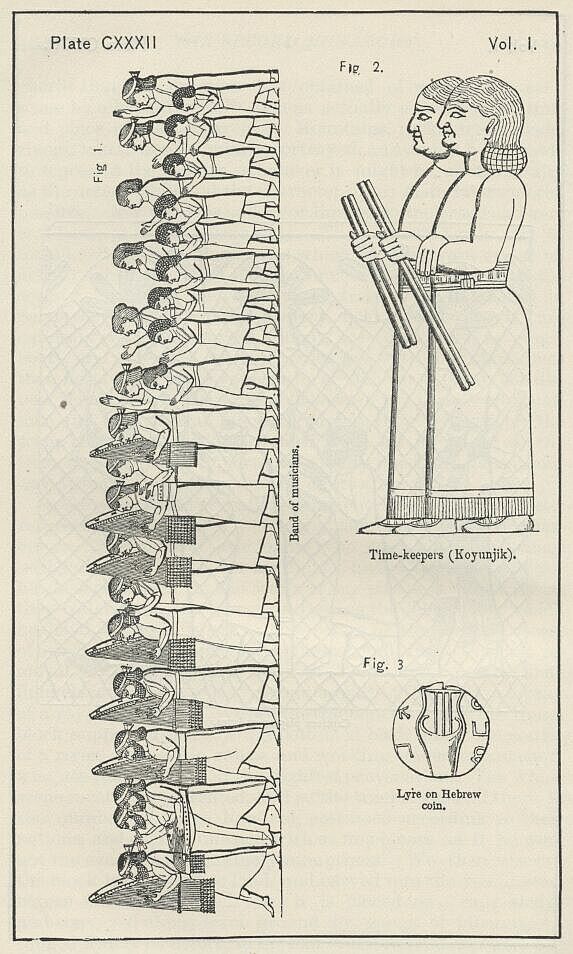

Bands in Assyria had sometimes, though not always, time-keepers or leaders, who took the direction of the performance. These were commonly eunuchs, as indeed were the greater number of the musicians. They held in one hand a double rod or wand, with which most probably they made their signals, and stood side by side facing the performers. [PLATE CXXXII., Fig. 2.]
The Assyrians seem to have employed music chiefly for festive and religious purposes. The favorite instrument in the religious ceremonies was the antique harp, which continued in use as a sacred instrument from the earliest to the latest times. On festive occasions the lyre was preferred, or a mixed band with a variety of instruments. In the quiet of domestic life the monarch and his sultana were entertained with concerted music played by a large number of performers: while in processions and pageants, whether of a civil or of a military character, bands were also very generally employed, consisting of two, three, four, five, or possibly more, musicians. Cymbals, the tambourine, and the instrument which has been above regarded as a sort of rattle, were peculiar to these processional occasions: the harp, the lyre, and the double pipe had likewise a place in them.
In actual war, it would appear that music was employed very sparingly, if at all, by the Assyrians. No musicians are ever represented in the battle-scenes: nor are the troops accompanied by any when upon the march. Musicians are only seen conjoined with troops in one or two marching processions, apparently of a triumphal character. It may consequently be doubted whether the Assyrian armies, when they went out on their expeditions, were attended, like the Egyptian and Roman armies, by military bands. Possibly, the musicians in the processional scenes alluded to belong to the court rather than to the camp, and merely take part as civilians in a pageant, wherein a share is also assigned to the soldiery.
In proceeding, as already proposed, to speak of the navigation of the Assyrians, it must be at once premised that it is not as mariners, but only as fresh-water sailors, that they come within the category of navigators at all. Originally an inland people, they had no power, in the earlier ages of their history, to engage in any but the secondary and inferior kind of navigation; and it would seem that, by the time when they succeeded in opening to themselves through their conquests a way to the Mediterranean and the Indian Ocean, their habits had become so fixed in this respect that they no longer admitted of change. There is satisfactory evidence which shows that they left the navigation of the two seas at the two extremities of their empire to the subject nations—the Phoenicians and the Babylonians contenting themselves with the profits without sharing the dangers of marine voyages, while their own attention was concentrated upon their two great rivers—the Tigris and the Euphrates, which formed the natural line of communication between the seas in question.
The navigation of these streams was important to the Assyrians in two ways. In the first place it was a military necessity that they should be able, readily and without delay, to effect the passage of both of them, and also of their tributaries, which were frequently too deep to be forded. Now from very early times it was probably found tolerably easy to pass an army over a great river by swimming, more especially with the aid of inflated skins, which would be soon employed for the purpose. But the materiel of the army—the provisions, the chariots, and the siege machines—was not so readily transported, and indeed could only be conveyed across deep rivers by means of bridges, rafts, or boats. On the great streams of the Tigris and Euphrates, with their enormous spring floods, no bridge, in the ordinary sense of the word, is possible. Bridges of boats are still the only ones that exist on either river below the point at which they issue from the gorges of the mountains. And these would be comparatively late inventions, long subsequent to the employment of single ferry boats. Probably the earliest contrivance for transporting the chariots, the stores, and the engines across a river was a raft, composed hastily of the trees and bushes growing in the neighborhood of the stream, and rendered capable of sustaining a considerable weight by the attachment to it of a number of inflated skins. A representation of such a raft, taken from a slab of Sennacherib, has been already given. Rafts of this kind are still largely employed in the navigation of the Mesopotamian streams, and, being extremely simple in their construction, may reasonably be supposed to have been employed by the Assyrians from the very foundation of their empire.
To these rafts would naturally have succeeded boats of one kind or another. As early as the time of Tiglath-Pileser I. (ab. B.C. 1120) we find a mention of boats as employed in the passage of the Euphrates. These would probably be of the kind described by Herodotus, and represented on one of the most ancient bas-reliefs—round structures like the Welsh coracles, made of wickerwork and covered with skins, smeared over with a coating of bitumen. Boats of this construction were made of a considerable size. The one represented contains a chariot, and is navigated by two men. [PLATE CXXXIII., Fig. 1.] In the later sculptures the number of navigators is raised to four, and the boats carry a heavy load of stone or other material. The mode of propulsion is curious and very unusual. The rowers sit at the stem and stern, facing each other, and while those at the stem pull, those at the stern must have pushed, as Herodotus tells us that they did. The make of the oars is also singular. In the earliest sculptures they are short poles, terminating in a head, shaped like a small axe or hammer; in the later, below this axe-like appendage, they have a sort of curved blade, which is, however, not solid, but perforated, so as to form a mere framework, which seems to require filling up. [PLATE CXXXIII., Fig. 3.]
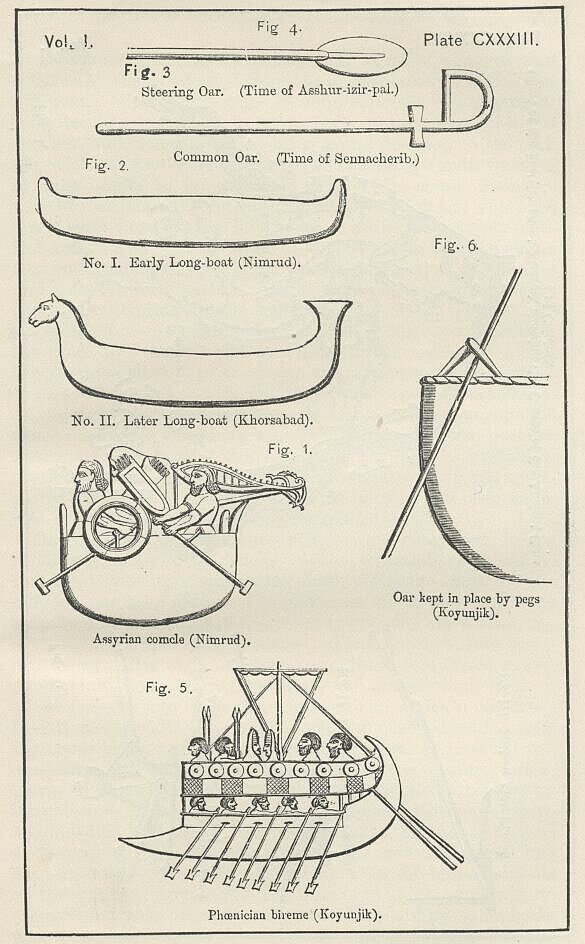
Beside these round boats, which correspond closely with the kufas in use upon the Tigris and Euphrates at the present day, the Assyrians employed for the passage of rivers, even in very early times, a vessel of a more scientific construction. The early bas-reliefs exhibit to us, together with the kufas, a second and much larger vessel, manned with a crew of seven men—a helmsman and six rowers, three upon either side and capable of conveying across a broad stream two chariots at a time, or a chariot and two or three passengers. This vessel appears to have been made of planks. It was long, and comparatively narrow. It had a flattish bottom, and was rounded off towards the stem and stern, much as boats are rounded off towards the bows at the present day. It did not possess either mast or sail, but was propelled wholly by oars, which were of the same shape as those used anciently by the rowers in the round boats. In the steersman's hand is seen an oar of a different kind. It is much longer than the rowing oars, and terminates in an oval blade, which would have given it considerable power in the water. [PLATE CXXXIII., Fig. 4.] The helmsman steered with both hands; and it seems that his oar was lashed to an upright post near the stern of the vessel.
It is evident that before armies could look habitually to being transported across the Mesopotamian streams, wherever they might happen to strike them in their expeditions, by boats of these two kinds, either ferries must have been established at convenient intervals upon them, or traffic along their courses by means of boats must have been pretty regular. An Assyrian army did not carry its boats with it, as a modern army does its pontoons. Boats were commonly found in sufficient numbers on the streams themselves when an army needed them, and were impressed, or hired, to convey the troops across. And thus we see that the actual navigation of the streams had another object besides the military one of transport from bank to bank. Rivers are Nature's roads; and we may be sure that the country had not been long settled before a water communication began to be established between towns upon the river-courses, and commodities began to be transported by means of them. The very position of the chief towns upon time banks of the streams was probably connected with this sort of transport, the rivers furnishing the means by which large quantities of building material could be conveniently concentrated at a given spot, and by which supplies could afterwards be regularly received from a distance. We see in the Assyrian sculptures the conveyance of stones, planks, etc. along the rivers, as well as the passage of chariots, horses, and persons across them. Rafts and round boats were most commonly used for this purpose. When a mass of unusual size, as a huge paving-stone, or a colossal bull or lion, had to be moved, a long, flat-bottomed boat was employed, which the mass sometimes more than covered. In this case, as there was no room for rower's, trackers were engaged, who dragged the vessel along by means of ropes, which were fastened either to the boat itself or to its burden. [PLATE CXXXIII., Fig. 2.]
During the later period of the monarchy various improvements took place in Assyrian boat-building. The Phoenician and Cyprian expeditions of the later kings made the Assyrians well acquainted with the ships of first-rate nautical nations; and they seem to have immediately profited by this acquaintance, in order to improve the appearance and the quality of their own river boats. The clumsy and inelegant long-boat of the earlier times, as replaced, even for ordinary traffic, by a light and graceful fabric, which was evidently a copy from Phoenician models. Modifications, which would seem trifling if described, changed the whole character of the vessels, in which light and graceful curves took the place of straight lines and angles only just rounded off. The stem and stern were raised high above the body of the boat, and were shaped like fishes' tails or carved into the heads of animals. [PLATE CXXXIII., Fig. 2.] Oars, shaped nearly like modern ones, came into vogue, and the rowers were placed so as all to look one way, and to pull instead of pushing with their oars. Finally, the principle of the bireme was adopted, and river-galleys were constructed of such a size that they had to be manned by thirty rowers, who sat in two tiers one above the other at the sides of the galley, while the centre part, which seems to have been decked, was occupied by eight or ten other persons.
In galleys of this kind the naval architecture of the Assyrians seems to have culminated. They never, so far as appears, adopted for their boats the inventions with which their intercourse with Phoenicia had rendered them perfectly familiar, of masts, and sails. This is probably to be explained from the extreme rapidity of the Mesopotamian rivers, on which sailing boats are still uncommon. The unfailing strength of rowers was needed in order to meet and stem the force of the currents; and this strength being provided in abundance, it was not thought necessary to husband it or eke it out by the addition of a second motive power. Again, the boats, being intended only for peaceful purposes, were unprovided with beaks, another invention well known to the Assyrians, and frequently introduced into their sculptures in the representations of Phoenician vessels. [PLATE CXXXIII., Fig. 5.]
In the Assyrian biremes the oars of the lower tier were worked through holes in the vessel's sides. This arrangement would of course at once supply a fulcrum and keep the oars in their places. But it is not so easy to see how the oar of a common row-boat, or the uppermost tier of a bireme, obtained their purchase on the vessel, and were prevented from slipping along its side. Assyrian vessels had no rowlocks, and in general the oars are represented as simply rested without any support on the upper edge of the bulwark. But this can scarcely have been the real practice; and one or two representations, where a support is provided, may be fairly regarded as showing what the practice actually was. In the figure of a kufa, or round boat, already given, it will be seen that one oar is worked by means of a thong, like the [—] or [—] of the Greeks, which is attached to a ring in the bulwark. In another bas-relief, several of the oars of similar boats are represented as kept in place by means of two pegs fixed into the top of the bulwark and inclined at an angle to one another. [PLATE CXXXIII., Fig. 6.] Probably one or other of these two methods of steadying the oar was in reality adopted in every instance.
With regard to Assyrian commerce, it must at the outset be remarked that direct notices in ancient writers of any real authority are scanty in the extreme. The prophet Nahum says indeed, in a broad and general way, of Nineveh, "Thou hast multiplied thy merchants above the stars of heaven;" and Ezekiel tells us, more particularly, that Assyrian merchants, along with others, traded with Tyre "in blue clothes, and broidered work, and in chests of rich apparel." But, except these two, there seem to be no notices of Assyrian trade in any contemporary or quasi-contemporary author. Herodotus, writing nearly two hundred years after the empire had come to an end, mentions casually that "Assyrian wares" had in very ancient times been conveyed by the Phoenicians to Greece, and there sold to the inhabitants. He speaks also of a river traffic in his own day between Armenia and Babylon along the course of the Euphrates, a fact which indirectly throws light upon the habits of earlier ages. Diodorus, following Ctesias, declares that a number of cities were established from very ancient times on the banks of both the Tigris and the Euphrates, to serve as marts of trade to the merchants who imported into Assyria the commodities of Media and Paraetacene. Among the most important of these marts, as we learn from Strabo, were Tiphsach or Thapsacus on the Euphrates, and Opis upon the Tigris.
It is from notices thus scanty, partial, and incidental, eked out by probability, and further helped by a certain number of important facts with respect to the commodities actually used in the country, whereof evidence has been furnished to us by the recent discoveries, that we have to form our estimate of the ancient commerce of the Assyrians. The Inscriptions throw little or no light upon the subject. They record the march of armies against foreign enemies, and their triumphant return laden with plunder and tribute, sometimes showing incidentally what products of a country were most in request among the Assyrians; but they contain no accounts of the journeys of merchants, or of the commodities which entered or quitted the country in the common course of trade.
The favorable situation of Assyria for trade has often attracted remark. Lying on the middle courses of two great navigable streams, it was readily approached by water both from the north-west and from the south-east. The communication between the Mediterranean and the Southern or Indian Ocean naturally—almost necessarily—followed this route. If Europe wanted the wares and products of India, or if India required the commodities of Europe, by far the shortest and easiest course was the line from the eastern Mediterranean across Northern Syria, and thence by one or other of the two great streams to the innermost recess of the Persian Gulf. The route by the Nile, the canal of Neco, and the Red Sea, was decidedly inferior, more especially on account of the dangerous navigation of that sea, but also because it was circuitous, and involved a voyage in the open ocean of at least twice the length of the other.
Again, Assyria lay almost necessarily on the line of land communication between the north-east and the south-west. The lofty Armenian mountain-chains—Niphates and the other parallel ranges—towards the north, and the great Arabian Desert towards the south, offered difficulties to companies of land-traders which they were unwilling to face, and naturally led them to select routes intermediate between these two obstacles, which could not fail to pass through some part or other of the Mesopotamian region.
The established lines of land trade between Assyria and her neighbors were probably very numerous, but the most important must have been some five or six. One almost certainly led from the Urumiyeh basin over the Keli-shin pass (lat. 37°, long. (45° nearly)), descending on Rowandiz, and thence following the course of the Greater Zab to Herir, whence it crossed the plain to Nineveh. At the summit of the Kell-shin pass is a pillar of dark blue stone, six feet in height, two in breadth, and one in depth, let into a basement block of the same material, and covered with a cuneiform inscription in the Scythic character. At a short distance to the westward on the same route is another similar pillar. The date of the inscriptions falls within the most flourishing time of the Assyrian empire, and their erection is a strong argument in favor of the use of this route (which is one of the very few possible modes of crossing the Zagros range) in the time when that empire was in full vigor.
Another line of land traffic probably passed over the same mountain-range considerably further to the south. It united Assyria with Media, leading from the Northern Ecbatana (Takht-i-Suleiman) by the Banneh pass to Suleimaniyeh, and thence by Kerkuk and Altura-Kiupri to Arbela and Nineveh.
There may have been also a route up the valley of the Lesser Zab, by Koi-Sinjah and over the great Kandil range into Lajihan. There are said to be Assyrian remains near Koi-Sinjah, at a place called the Bihisht and Jehennen ("the Heaven and Hell") of Nimrud, but no account has been given of them by any European traveller.
Westward there were probably two chief lines of trade with Syria and the adjacent countries. One passed along the foot of the Sinjar range by Sidikan (Arban) on the Khabour to Tiphsach (or Thapsacus) on the Euphrates, where it crossed the Great River. Thence it bent southwards, and, passing through Tadmor, was directed upon Phoenicia most likely by way of Damascus. Another took a more northern line by the Mons Masius to Harran and Seruj, crossing the Euphrates at Bir, and thence communicating both with Upper Syria and with Asia Minor. The former of these two routes is marked as a line of traffic by the foreign objects discovered in such abundance at Arban, by the name Tiphsach, which means "passage," and by the admitted object of Solomon in building Tadmor. The other rests on less direct evidence; but there are indications of it in the trade of Harran with Tyre which is mentioned by Ezekiel, and in the Assyrian remains near Seruj, which is on the route from Harran to the Bir fordway.
Towards the north, probably, the route most used was that which is thought by many to be the line followed by Xenophon, first up the valley of the Tigris to Til or Tilleh, and then along the Bitlis Chai to the lake of Van and the adjacent country. Another route may have led from Nineveh to Nisibis, thence through the Jebel Tur to Diarbekr, and from Diarbekr up the Western Tigris to Arghana, Kharput, Malatiyeh, and Asia Minor. Assyrian remains have been found at various points along this latter line, while the former is almost certain to have connected the Assyrian with the Armenian capital.
Armenian productions would, however, reach Nineveh and the other great central cities mainly by the Tigris, down which they could easily have been floated from Tilleh. or even from Diarbekr. Similarly, Babylonian and Susianian productions, together with the commodities which either or both of those countries imported by sea, would find their way into Assyria up the courses of the two streams, which were navigated by vessels capable of stemming the force of the current, at least as high as Opis and Thapsacus.
We may now proceed to inquire what were the commodities which Assyria, either certainly or probably, imported by these various lines of land and water communication. Those of which we seem to have some indication in the existing remains are gold, tin, ivory, lead, stones of various kinds, cedar-wood, pearls, and engraved seals.
Many articles in gold have been recovered at the various Assyrian sites where excavations have been made; and indications have been found of the employment of this precious metal in the ornamentation of palaces and of furniture. The actual quantity discovered has, indeed, been small; but this may be accounted for without calling in question the reality of that extraordinary wealth in the precious metals which is ascribed by all antiquity to Assyria. This wealth no doubt flowed in, to a considerable extent, from the plunder of conquered nations and the tribute paid by dependent monarchs. But the quantity obtained in this way would hardly have sufficed to maintain the luxury of the court and at the same time to accumulate, so that when Nineveh was taken there was "none end" of the store. It has been suggested that "mines of gold were probably once worked within the Assyrian dominions," although no gold is now known to be produced anywhere within her limits. But perhaps it is more probable that, like Judaea and Phoenicia, she obtained her gold in a great measure from commerce, taking it either from the Phoenicians, who derived it both from Arabia and from the West African coast, or else from the Babylonians, who may have imported it by sea from India.
Tin, which has not been found in a pure state in the remains of the Assyrians, but which enters regularly as an element into their bronze, where it forms from one-tenth to one-seventh of the mass, was also, probably, an importation. Tin is a comparatively rare metal. Abundant enough in certain places, it is not diffused at all widely over the earth's surface. Neither Assyria itself nor any of the neighboring countries are known to have ever produced this mineral. Phoenicia certainly imported it, directly or indirectly, from Cornwall and the Scilly Isles, which therefore became first known in ancient geography as the Cassiterides or "Tin Islands." It is a reasonable supposition that the tin wherewith the Assyrians hardened their bronze was obtained by their merchants from the Phoenicians in exchange for textile fabrics and (it may be) other commodities. If so, we may believe that in many instances the produce of our own tin mines which left our shores more than twenty-five centuries ago, has, after twice travelling a distance of many thousand miles, returned to seek a final rest in its native country.
Ivory was used by the Assyrians extensively in their furniture, and was probably supplied by them to the Phoenicians and the Greeks. It was no doubt sometimes brought to them by subject nations as tribute; but this source of supply is not sufficient to account, at once, for the consumption in Assyria itself, and for the exports from Assyria to foreign countries. A regular trade for ivory seems to have been carried on from very early times between India and Dedan (Bahrein,?) in the Persian Gulf. The travelling companies of the Dedanim, who conveyed this precious merchandise from their own country to Phoenicia, passed probably along the course of the Euphrates, and left a portion of their wares in the marts upon that stream, which may have been thence conveyed to the great Assyrian cities. Or the same people may have traded directly with Assyria by the route of the Tigris. Again, it is quite conceivable—indeed, it is probable—that there was a land traffic between Assyria and Western India by the way of Cabal, Herat, the Caspian Gates, and Media. Of this route we have a trace in the land animals engraved upon the well-known Black Obelisk, where the combination of the small-eared or Indian elephant and the rhinoceros with the two-humped Bactrian camel, sufficiently marks the line by which the productions of India, occasionally at, any rate, reached Assyria. The animals themselves were, we may be sure, very rarely transported. Indeed, it is not till the very close of the Persian empire that we find elephants possessed—and even then in scanty numbers—by the western Asiatic monarchs. But the more portable products of the Indus region, elephants' tusks, gold, and perhaps shawls and muslins, are likely to have passed to the west by this route with far greater frequency.
The Assyrians were connoisseurs in hard stones and gems, which they seem to have imported from all quarters. The lapis lazuli, which is found frequently among the remains as the material of seals, combs, rings, jars, and other small objects, probably came from Bactria or the adjacent regions, whence alone it is procurable at the present day. The cornelian used for cylinders may have come from Babylonia, which, according to Pliny furnished it of the best quality in the more ancient times. The agates or onyxes may have been imported from Susiana, where they were found in the bed of the Choaspes (Kerkhah), or they may possibly have been brought from India. Other varieties are likely to have been furnished by Armenia, which is rich in stones; and hence too was probably obtained the shamir, or emery-stone, by means of which the Assyrians were enabled to engrave all the other hard substances known to them.
That cedar-wood was imported into Assyria is sufficiently indicated by the fact that, although no cedars grew in the country, the beams in the palaces were frequently of this material. It may not, however, have been exactly an article of commerce, since the kings appear to have cut it after their successful expeditions into Syria, and to have carried it off from Lebanon and Amanus as part of the plunder of the country.
Pearls, which have been found in Assyrian ear rings, must have been procured from the Persian Gulf, one of the few places frequented by the shell-fish which produces then. The pearl fisheries in these parts were pointed out to Nearchus, the admiral of Alexander, and had no doubt been made to yield their treasures to the natives of the coasts and islands from a remote antiquity. The familiarity of the author of the book of Job with pearls is to be ascribed to the ancient trade in them throughout the regions adjoining the Gulf, which could not fail to bring them at an early date to the knowledge of the Hebrews.
Engraved stones, generally in the shape of scarabs, seem to have been largely imported from Egypt into Assyria, where they were probably used either as amulets or as seals. They have been found in the greatest plenty at Arban on the lower Khabour, the ancient Sidikan or Shadikanni, which lies nearly at the extreme west of the Assyrian territory; but many specimens have likewise been obtained from Nineveh and other of the central Assyrian cities.
If we were to indulge in conjecture, we might add to this list of Assyrian importations at least an equal number of commodities which, though they have not been found in the ancient remains, may be fairly regarded, on grounds of probability, as objects of trade between Assyria and her neighbors. Frankincense, which was burnt in such lavish profusion in the great temple at Babylon, was probably offered in considerable quantities upon Assyrian altars, and could only have been obtained from Arabia. Cinnamon, which was used by the Jews from the time of the Exodus, and which was early imported into Greece by the Phoenicians, who received it from the Arabians can scarcely have been unknown in Assyria when the Hebrews were familiar with it. This precious spice must have reached the Arabians from Ceylon or Malabar, the most accessible of the countries producing it. Mullins, shawls, and other tissues are likely to have come by the same route as the cinnamon; and these may possibly have been among the "blue clothes and broidered work and rich apparel" which the merchants of Asshur carried to Tyre in "chests, bound with cords and made of cedar-wood." Dyes, such as the Indian lacca, raw cotton, ebony and other woods, may have come by the same line of trade; while horses and mules are likely to have been imported from Armenia, and slaves from the country between Armenia and the Halys River.
If from the imports of Assyria we pass to her exports, we leave a region of uncertain light to enter upon one of almost total darkness. That the "wares of Assyria" were among the commodities which the Phoenicians imported into Greece at a very early period, we have the testimony of Herodotus; but he leaves us wholly without information as to the nature of the wares themselves. No other classical writer of real authority touches the subject; and any conclusions that we may form upon it must be derived from one of two sources, either general probability, or the single passage in a sacred author which gives us a certain amount of authentic information. From the passage in question, which has been already quoted at length, we learn that the chief of the Assyrian exports to Phoenicia were textile fabrics, apparently of great value, since they were most carefully packed in chests of cedar-wood secured by cords. These fabrics may have been "blue cloaks," or "embroidery," or "rich dresses" of any kind, for all these are mentioned by Ezekiel; but we cannot say definitely which Assyria traded in, since the merchants of various other countries are joined in the passage with hers. Judging by the monuments, we should conclude that at least a portion of the embroidered work was from her looms and workshops; for, as has been already shown, the embroidery of the Assyrians was of the most delicate and elaborate description. She is also likely to have traded in rich apparel of all kinds, both such as she manufactured at home, and such as she imported from the far East by the lines of traffic which have been pointed out. Some of her own fabrics may possibly have been of silk, which in Roman times was a principal Assyrian export. Whether she exported her other peculiar productions, her transparent and colored glass, her exquisite metal bowls, plates, and dishes, her beautifully carved ivories, we cannot say. They have not hitherto been found in any place beyond her dominion, so that it would rather seem that she produced them only for home consumption. Some ancient notices appear to imply a belief on the part of the Greeks and Romans that she produced and exported various spices. Horace speaks of Assyrian nard Virgil of Assyrian amomuum, Tibullus of Assyrian odors generally. AEschylus has an allusion of the same kind in his Agamemnon. Euripide, and Theocritus, who mention respectively Syrian myrrh and Syrian frankincense, probably use the word "Syrian" for "Assyrian." The belief thus implied is not, however, borne out by inquiry. Neither the spikenard nor the amonmum, nor the myrrh tree, nor the frankincense tree, nor any other actual spice, is produced within the limits of Assyria, which must always have imported its own spices from abroad, and can only have supplied them to other countries as a carrier. In this capacity she may very probably, even in the time of her early greatness, have conveyed on to the coast of Syria the spicy products of Arabia and India, and thus have created an impression, which afterwards remained as a tradition, that she was a great spice-producer as well as a spice-seller.
In the same way, as a carrier, Assyria may have exported many other commodities. She may have traded with the Phoenicians, not only in her own products, but in the goods which she received from the south and east, from Bactria, India, and the Persian Gulf,—such as lapis lazuli, pearls, cinnamon, muslins, shawls, ivory, ebony, cotton. On the other hand, she may have conveyed to India, or at least to Babylon, the productions which the Phoenicians brought to Tyre and Sidon from the various countries bordering upon the Mediterranean Sea and even the Atlantic Ocean, as tin, hides, pottery, oil, wine, linen. On this point, however, we have at present no evidence at all; and as it is not the proper office of a historian to indulge at any length in mere conjecture, the consideration of the commercial dealings of the Assyrians may be here brought to a close.
On the agriculture of the Assyrians a very few remarks will be offered. It has been already explained that the extent of cultivation depended entirely on the conveyance of water. There is good reason to believe that the Assyrians found a way to spread water over almost the whole of their territory. Either by the system of kanats or subterranean aqueducts, which has prevailed in the East from very early times, or by an elaborate network of canals, the fertilizing fluid was conveyed to nearly every part of Mesopotamia, which shows by its innumerable mounds, in regions which are now deserts, how large a population it was made to sustain under the wise management of the great Assyrians monarchs. Huge dams seem to have been thrown across the Tigris in various places, one of which (the Afrui) still remains, seriously impeding the navigation. It is formed of large masses of squared stones, united together by cramps of iron. Such artificial barriers were intended, not (as Strabo believed) for the protection of the towns upon the river from a hostile fleet, but to raise the level of the stream, in order that its water might flow off into canals on one bank or the other, whence they could be spread by means of minor channels over large tracts of territory. The canals themselves have in most cases been gradually filled up. In one instance, however, owing either to the peculiar nature of the soil or to some unexplained cause, we are still able to trace the course of an Assyrian work of this class and to observe the manner and principles of its construction.
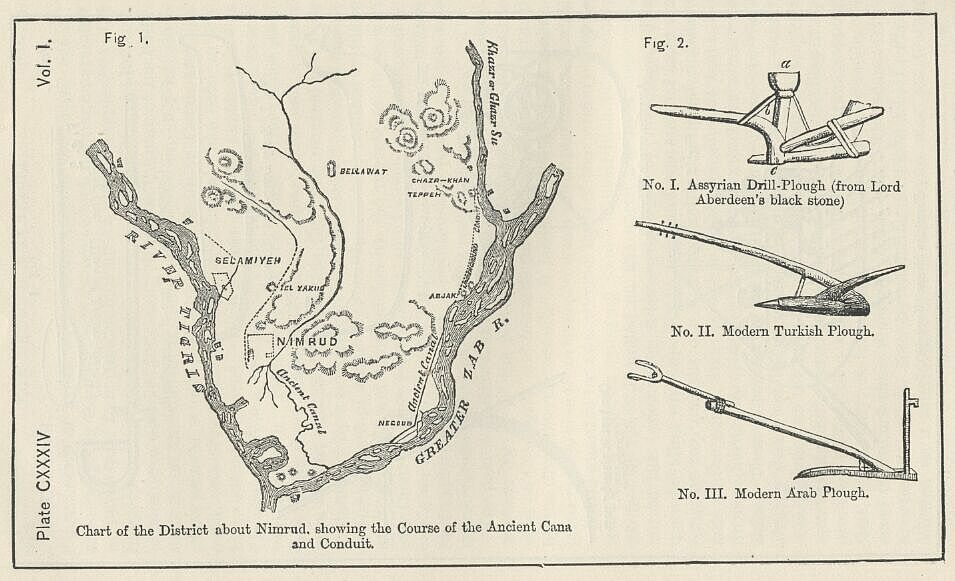
In the tract of land lying between the lower course of the Great Zab River and the Tigris, in which was situated the important town of Calah (now Nimrud), a tract which is partly alluvial, but more generally of secondary formation, hard gravel, sandstone, or conglomerate, are the remains of a canal undoubtedly Assyrian, which was carried for a distance of more than five-and-twenty miles from a point on the Khazr or Ghazr Su, a tributary of the Zab, to the south-eastern corner of the Nimrud ruins. [PLATE CXXXIV., Fig. 1.] Originally the canal seems to have been derived from the Zab itself, the water of which was drawn off, on its northern bank, through a short tunnel—the modern Negoub—and then conducted along a cutting, first by the side of the Zab, and afterwards in a tortuous course across the undulating plain, into the ravine formed by the Shor-Derreh torrent. The Zab, when this part of the work was constructed, ran deep along its northern bank, and, sending a portion of its waters into the tunnel, maintained a constant stream in the canal. But after awhile the river abandoned its north bank for the opposite shore; and, water ceasing to flow through the Negoub tunnel, it became necessary to obtain it in some other way. Accordingly the canal was extended northwards, partly by cutting and partly by tunnelling to the Ghazr Su at about two miles above its mouth, and a permanent supply was thenceforth obtained from that stream. The work may have been intended in part to supply Calah with mountain water; but the remains of dams and sluices along its course sufficiently show that it was a canal for irrigation also. From it water was probably derived to fertilize the whole triangle lying south of Nimrud between the two streams, a tract containing nearly thirty square miles of territory, mostly very fertile, and with careful cultivation well capable of supporting the almost metropolitan city on which it abutted.
In Assyria it must have been seldom that the Babylonian system of irrigation could have been found applicable, and the water simply derived from the rivers by side-cuts, leading it off from the natural channel. There is but little of Assyria which is flat and alluvial; the land generally undulates, and most of it stands at a considerable height above the various streams. The water therefore requires to be raised from the level of the rivers to that of the lands before it can be spread over them, and for this purpose hydraulic machinery of one kind or another is requisite. In cases where the subterranean conduit was employed, the Assyrians probably (like the ancient and the modern Persians) sank wells at intervals, and raised the water from them by means of a bucket and rope, the latter working over a pulley. Where they could obtain a bank of a convenient height overhanging a river, they made use of the hand-swipe, and with its aid lifted the water into a tank or reservoir, whence they could distribute it over their fields. In some instances, it would seem, they brought water to the tops of hills by means of aqueducts, and then, constructing a number of small channels, let the fluid trickle down them among their trees and crops. They may have occasionally, like the modern Arabs, employed the labor of an animal to raise the fluid; but the monuments do not furnish us with any evidence of their use of this method. Neither do we find any trace of water-wheels, such as are employed upon the Orontes and other swift rivers, whereby a stream can itself be made to raise water from the land along its bunks.
According to Herodotus, the kinds of grain cultivated in Assyria in his time were wheat, barley, sesame, and millet. As these still constitute at the present day the principal agricultural products of the county, we may conclude that they were in all probability the chief species cultivated under the Empire. The plough used, if we may judge by the single representation of it which has come down to us, was of a rude and primitive construction—a construction, however, which will bear comparison with that of the implements to this day in use through modern Turkey and Persia. Of other agricultural implements we have no specimens at all, unless the square instrument with a small circle or wheel at each corner, which appears on the same monument as the plough, may be regarded as intended for some farming purpose. [PLATE CXXXIV., Fig. 2.]
Besides grain, it seems certain that the Assyrians cultivated the vine. The vine will grow well in many parts of Assyria; and the monuments represent vines, with a great deal of truth, not merely as growing in the countries to which the Assyrians made their expeditions, but as cultivated along the sides of the rivers near Nineveh, and in the gardens belonging to the palaces of the kings. In the former case they appear to grow without any support, and are seen in orchards intermixed with other fruit-trees, as pomegranates and figs. In the latter they are trained upon tall trees resembling firs, round whose stems they twine themselves, and from which their rich clusters droop. Sometimes the long lithe boughs pass across from tree to tree, forming a canopy under which the monarch and his consort sip their wine.
Before concluding this chapter, a few remarks will be added upon the ordinary private life of the Assyrians, so far as the monuments reveal it to us. Under this head will be included their dress, their food, their houses, furniture, utensils, carriages, etc., their various kinds of labor, and the implements of labor which were known to them.
The ordinary dress of the common people in Assyria was a mere plain tunic, or skirt, reaching from the neck to a little above the knee, with very short sleeves, and confined round the waist by a broad belt or girdle. Nothing was worn either upon the head or upon the feet. The thick hair, carried in large waves from the forehead to the back of the head, and then carefully arranged in three, four, or five rows of stiff curls, was regarded as a sufficient protection both from sun and rain. No head-covering was ever worn, except by soldiers, and by certain officials, as the king, priests, and musicians. Sometimes, if the hair was very luxuriant, it was confined by a band or fillet, which was generally tied behind the back of the head. The beard was worn long, and arranged with great care, the elaboration being pretty nearly the same in the case of the king and of the common laborer. Laborers of a rank a little above the lowest wore sandals, indulged in a fringed tunic, and occasionally in a phillibeg, while a still higher class had a fringed tunic and phillibeg, together with the close-fitting trouser and boot worn by soldiers. These last are frequently eunuchs, who probably belonged to a corps of eunuch laborers in the employ of the king.
Persons of the humbler laboring class wear no ornament, neither armlet, bracelet, nor earrings. Armlets and bracelets mark high rank, and indeed are rarely found unless the wearer is either an officer of the court, or at any rate a personage of some consideration. Earrings seem to have descended lower. They are worn by the attendants on sportsmen, by musicians, by cavalry soldiers, and even occasionally by foot soldiers. In this last case they are seldom more than a simple ring, which may have been of bronze or of bone. In other cases the ring mostly supports a long pendant.
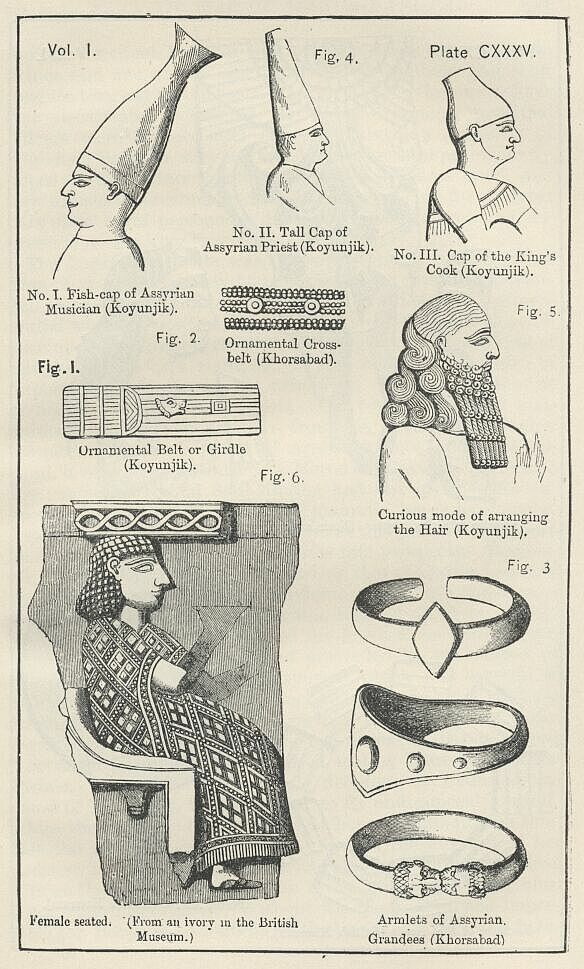
Men of rank appear to have worn commonly a long fringed robe reaching nearly to the feet. The sleeves were short, only just covering the shoulder. Down to the waist, the dress closely fitted the form, resembling, so far, a modern jersey; below this there was a slight expansion, but still the scantiness of the robe is very remarkable. It had no folds, and must have greatly interfered with the free play of the limbs, rendering rapid movements almost impossible. A belt or girdle confined it at the waist, which was always patterned, sometimes elaborately. [PLATE CXXXV., Fig. 1.] If a sword was carried, as was frequently the case, it was suspended, nearly in a horizontal position, by a belt over the left shoulder, to which it was attached by a ring, or rings, in the sheath. There is often great elegance in these cross-belts, which look as if they were embroidered with pearls or beads. [PLATE CXXXV., Fig. 2.] Fillets, earrings, armlets, and (in most instances) bracelets were also worn by Assyrians of the upper classes. The armlets are commonly simple bands, twisted round the arm once or twice, and often overlapping' at the ends, which are plain, not ornamented. [PLATE CXXXV.] The bracelets are of slighter construction; their ends do not meet; they would seem to have been of thin metal, and sufficiently elastic to be slipped over the hand on to the wrist, which they then fitted closely. Generally they were quite plain; but sometimes, like the royal bracelets, they bore in their centre a rosette. Sandals, or in the later times shoes, completed the ordinary costume of the Assyrian "gentleman."
Sometimes both the girdle round the waist, and the cross-belt, which was often worn without a sword, were deeply fringed, the two fringes falling one over the other, and covering the whole body from the chest to the knee. Sometimes, but more rarely, the long robe was discarded, and the Assyrian of some rank wore the short tunic, which was then, however, always fringed, and commonly ornamented with a phillibeg.
Certain peculiar head-dresses and peculiar modes of arranging the hair deserve special attention from their singularity. [PLATE CXXXV., Fig. 4.] They belong in general to musicians, priests, and other official personages, and may perhaps have been badges of office. For instance, musicians sometimes wear on their heads a tall stiff cap shaped like a fish's tail; at other times their head-dress is a sort of tiara of feathers.
Their hair is generally arranged in the ordinary Assyrian fashion; but sometimes it is worn comparatively short, and terminates in a double row of crisp curls. Priests have head-dresses shaped like truncated cones. A cook in one instance, wears a cap not unlike the tiara of the monarch, except that it is plain, and is not surmounted by an apex or peak. A harper has the head covered with a close-fitting cap, encircled with a row of large beads or pearl; from which a lappet depends behind, similarly ornamented. A colossal figure in a doorway, apparently a man, though possibly representing a god, has the hair arranged in six monstrous curls, the lowest three resting upon the shoulder. [PLATE CXXXV., Fig. 6.]
Women of the better sort seem to have been dressed in sleeved gowns, less scanty than those of the men, and either striped or else patterned and fringed. Outside this they sometimes wore a short cloak of the same pattern as the gown, open in front and falling over the arms, which it covered nearly to the elbows. Their hair was either arranged over the whole of the head in short crisp curls, or carried back in waves to the ears, and then in part twisted into long pendent ringlets, in part curled, like that of the men, in three or four rows at the back of the neck. [PLATE CXXXV., Fig. 5.] A girdle was probably worn round the waist, such as we see in the representations of goddesses, while a fringed cross-belt passed diagonally across the breast, being carried under the right arm and over the left shoulder. The feet seem to have been naked, or at best protected by a sandal. The head was sometimes encircled with a fillet.
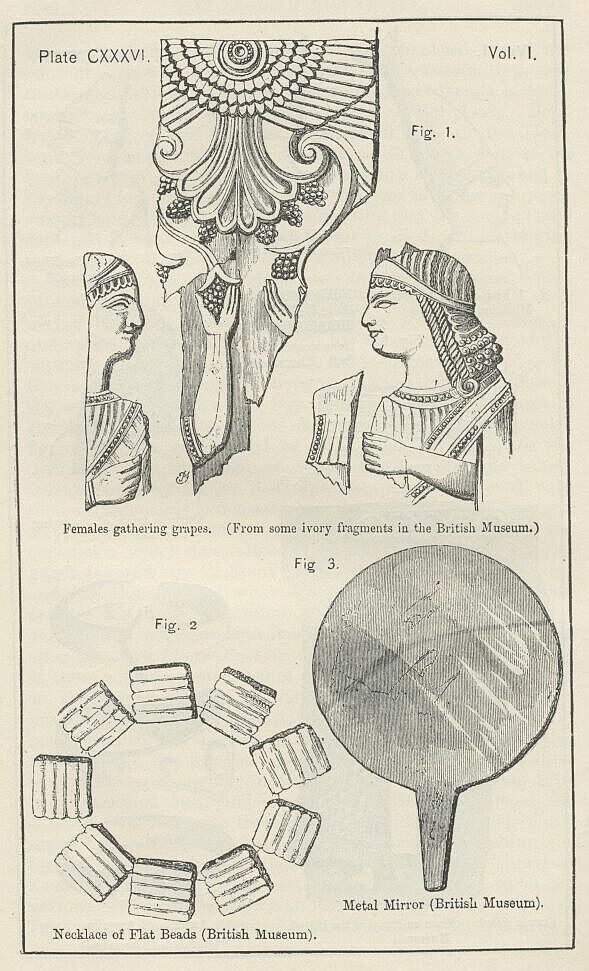
Women thus apparelled are either represented as sitting in chairs and drinking from a shallow cup, or else as gathering grapes, which, instead of growing naturally, hang up on branches that issue from a winged circle. The circle would seem to be emblematic of the divine power which bestows the fruits of the earth upon man. [PLATE CXXXVI., Fig. 1.]
The lower class of Assyrian women are not represented upon the sculptures. We may perhaps presume that they did not dress very differently from the female captives so frequent on the bas-reliefs, whose ordinary costume is a short gown not covering the ankles, and an outer garment somewhat resembling the chasuble of the king. The head of these women is often covered with a hood where the hair appears, it usually descends in a single long curl. The feet are in every case naked.
The ornaments worn by women appear to have been nearly the same as those assumed by men. They consisted principally of earrings, necklaces, and bracelets. Earrings have been found in gold laid in bronze, some with and some without places for jewels. One gold earring still held its adornment of petals. Bracelets were sometimes of glass, and were slipped over the hand. Necklaces seem commonly to have been of beads, strung together. A necklace in the British Museum is composed of glass beads of a light blue color, square in shape and flat, with horizontal flutings. [PLATE CXXXVI., Fig. 2.] Glass finger-rings have also been found, which were probably worn by women.
We have a few remains of Assyrian toilet articles. A bronze disk, about nine inches in diameter, with a long handle attached, is thought to have been a mirror. In its general shape it resembles both the Egyptian and the classical mirrors; but, unlike them, it is perfectly plain, even the handle being a mere flat bar. [PLATE CXXXVI., Fig. 3.] We have also a few combs. One of these is of iron, about three and a half inches long, by two inches broad in the middle. It is double, like a modern small-tooth comb, but does not present the feature, common in Egypt, of a difference in the size of the teeth on the two sides. The very ancient use of this toilet article in Mesopotamia is evidenced by the fact, already noticed, that it was one of the original hieroglyphs whence the later letters were derived. Another comb is of lapis lazuli, and has only a single row of teeth. [PLATE CXXXVII., Fig. 1.] The small vases of alabaster or fine clay, and the small glass bottles which have been discovered in tolerable abundance, were also in all probability intended chiefly for the toilet. They would hold the perfumed unguents which the Assyrians, like other Orientals, were doubtless in the habit of using, and the dyes wherewith they sought to increase the beauty of the countenance.
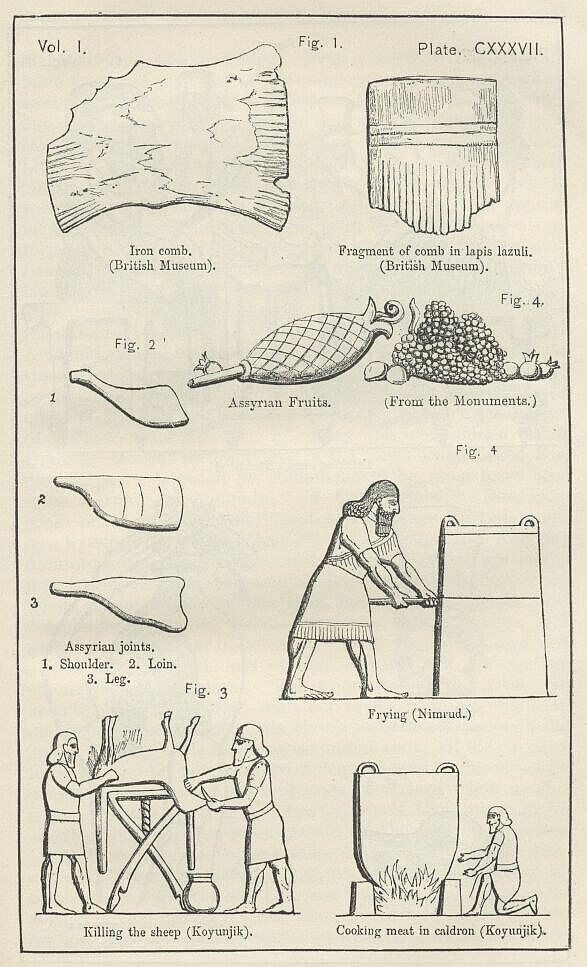
No doubt the luxury of the Assyrian women in these and other respects was great and excessive. They are not likely to have fallen short of their Jewish sisters either in the refinements or in the corruptions of civilization. When then we hear of the "tinkling ornaments" of the Jewish women in Isaiah's time, "their combs, and round tires like the moon," their "chains and bracelets and mufflers," their "bonnets, and ornaments of the legs, and head-bands, and tablets and ear-rings," their "rings and nose-jewels," their "changeable suits of apparel, and mantles, and wimples, and crisping-pins," their "glasses, and fine linen, and hoods, and veils," their "sweet smells, and girdles, and well-set hair, and stomachers," we may be sure that in Assyria too these various refinements, or others similar to them, were in use, and consequently that the art of the toilet was tolerably well advanced under the second great Asiatic Empire. That the monuments contain little evidence on the point need not cause any surprise; since it is the natural consequence of the spirit of jealous reserve common to the Oriental nations, which makes them rarely either represent women in their mimetic art or speak of them in their public documents.
If various kinds of grain were cultivated in Assyria, such as wheat, barley, sesame, and millet, we may assume that the food of the inhabitants, like that of other agricultural nations, consisted in part of bread. Sesame was no doubt used, as it is at the present day, principally for making oil; while wheat, barley, and millet were employed for food, and were made into cakes or loaves. The grain used, whatever it was, would be ground between two stones, according to the universal Oriental practice even at the present day. It would then he moistened with water, kneaded in a dish or bowl, and either rolled into thin cakes, or pressed by the hand into smalls balls or loaves. Bread and cakes made in this way still form the chief food of the Arabs of these parts, who retain the habits of antiquity. Wheaten bread is generally eaten by preference; but the poorer sort are compelled to be content with the coarse millet or durra flour, which is made into cakes, and then eaten with milk, butter, oil, or the fat of animals.
Dates, the principal support of the inhabitants of Chaldaea, or Babylonia, both in ancient and in modern times, were no doubt also an article of food in Assyria, though scarcely to any great extent. The date-palm does not bear well above the alluvium, and such fruit as it produces in the upper country is very little esteemed. Olives were certainly cultivated under the Empire, and the oil extracted from them was in great request. Honey was abundant, and wine plentiful. Sennacherib called his land "a land of corn and wine, a land of bread and vineyards, a land of oil olive and of honey;" and the products here enumerated were probably those which formed the chief sustenance of the bulk of the people.
Meat, which is never eaten to any great extent in the East was probably beyond the means of most persons. Soldiers, however, upon an expedition were able to obtain this dainty at the expense of others; and accordingly we find that on such occasions they freely indulged in it. We see them, after their victories, killing and cutting up sheep and. oxen, and then roasting the joints, which are not unlike our own, on the embers of a wood-fires [PLATE CXXXVII., Fig. 2.] In the representations of entrenched camps we are shown the mode in which animals were prepared for the royal dinner. They were placed upon their backs on a high table, with their heads hanging over its edge; one man held them steady in this position, while another, taking hold of the neck, cut the throat a little below the chin. The blood dripped into a bowl or basin placed beneath the head on the ground. [PLATE CXXXVII., Fig. 3.] The animal was then no doubt, paunched, after which it was placed either whole, or in joints—in a huge pot or caldron, and, a fire being lighted underneath, it was boiled to such a point as suited the taste of the king. [PLATE CXXXVII., Fig. 5.] While the boiling progressed, some portions were perhaps fried on the fire below. [PLATE CXXXVII., Fig. 5.] Mutton appears to have been the favorite meat in the camp. At the court there would be a supply of venison, antelope's flesh, hares, partridges, and other game, varied perhaps occasionally with such delicacies as the flesh of the wild ox and the onager.
Fish must have been an article of food in Assyria, or the monuments would not have presented us; with so many instances of fishermen. Locusts were also eaten, and were accounted a delicacy, as is proved by their occurrence among the choice dainties of a banquet, which the royal attendants are represented in one bas-relief as bringing into the palace of the king. Fruits, as was natural in so hot a climate, were highly prized; among those of most repute were pomegranates, grapes, citrons, and, apparently, pineapples. [PLATE CXXXVII., Fig. 4.]
There is reason to believe that the Assyrians drank wine very freely. The vine was cultivated extensively, in the neighborhood of Nimrud and elsewhere; and though there is no doubt that, grapes were eaten, both raw and dried, still the main purpose of the vineyards was unquestionably the production of wine. Assyria was "a land of corn and wine," emphatically and before all else. Great banquets seem to have been frequent at the court, as at the courts of Babylon and Persia, in which drinking was practised on a large scale. The Ninevites generally are reproached as drunkards by Nahum. In the banquet-scenes of the sculptures, it is drinking and not eating that is represented. Attendants dip the wine-cups into a huge bowl or vase, which stands on the ground and reaches as high as a man's chest and carry them full of liquor to the guests, who straightway fall to a carouse. [PLATE CXXXVIII., Fig. 1.]
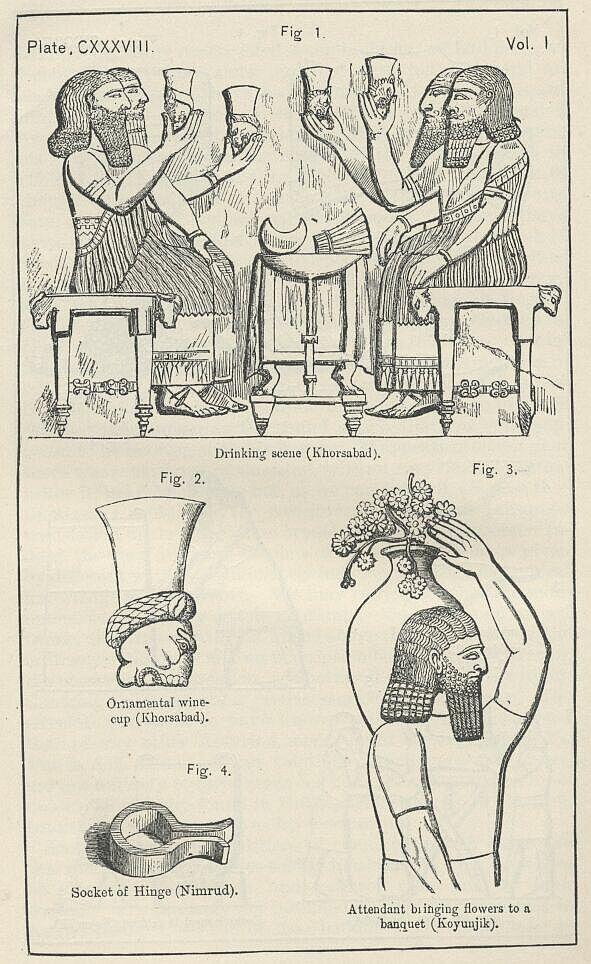
The arrangement of the banquets is curious. The guests, who are in one instance some forty or fifty in number, instead of being received at a common table, are divided into messes of four, who sit together, two and two, facing each other, each mess having its own table and its own attendant. The guests are all clothed in the long tasselled gown, over which they wear the deeply fringed belt and cross-belt. They have sandals on their feet, and on their arias armlets and bracelets. They sit on high stools, from which their legs dangle; but in no case have they footstools, which would apparently have been a great convenience. Most of the guests are bearded men, but intermixed with them we see a few eunuchs. Every guest holds in his right hand a wine-cup of a most elegant shape, the lower part modelled into the form of a lion's head, from which the cup itself rises in a graceful curve. [PLATE CXXXVIII., Fig. 2.] They all raise their cups to a level with their heads, and look as if they were either pledging each other, or else one and all drinking the same toast. Both the stools and the tables are handsome, and tastefully, though not very richly, ornamented. Each table is overspread with a table-cloth, which hangs down on either side opposite the guests, but does not cover the ends of the table, which are thus fully exposed to view. In their general make the tables exactly resemble that used in a banquet scene by a king of a later date, but their ornamentation is much less elaborate. On each of them appears to have been placed the enigmatical article of which mention has been already made as a strange object generally accompanying the king. Alongside of it we see in most instances a sort of rude crescent. These objects have probably, both of them, a sacred import, the crescent being the emblem of Sin, the Moon-God, while the nameless article had some unknown religious use or meaning.
In the great banqueting scene at Khorsabad, from which the above description is chiefly taken, it is shown that the Assyrians, like the Egyptians and the Greeks in the heroic times, had the entertainment of music at their grand feasts and drinking bouts. At one end of the long series of figures representing guests and attendants was a band of performers, at least three in number, two of whom certainly played upon the lyre. The lyres were ten-stringed, of a square shape, and hung round the player's neck by a string or ribbon.
The Assyrians also resembled the Greeks and Romans in introducing flowers into their feasts. We have no evidence that they wore garlands, or crowned themselves with chaplets of flowers, or scattered roses over their rooms; but still they appreciated the delightful adornment which flowers furnish. In the long train of attendance represented at Koyunjik as bringing the materials of a banquet into the palace of the king, a considerable number bear vases of flowers. [PLATE CXXXVIII., Fig. 3.] These were probably placed on stands, like those which are often seen supporting jars, and dispersed about the apartment in which the feast was held, but not put upon the tables.
We have no knowledge of the ordinary houses of the Assyrians other than that which we derive from the single representation which the sculptures furnish of a village certainly Assyrian. It appears from this specimen that the houses were small, isolated from one another, and either flat-roofed, or else covered in with a dome or a high cone. They had no windows, but must have been lighted from the top, where, in some of the roofs, an aperture is discernible. The doorway was generally placed towards one end of the house; it was sometimes arched, but more often square-headed.
The doors in Assyrian houses were either single, as commonly with ourselves, or folding (fores or valvoe), as with the Greeks and Romans, and with the modern French and Italians. Folding-doors were the most common in palaces. They were not hung upon hinges, like modern doors, but, like those of the classical nations, turned upon pivots. At Khorsabad the pavement slabs in the doorways showed everywhere the holes in which these pivots had worked, while in no instance did the wall at the side present any trace of the insertion of a hinge. Hinges, however, in the proper sense of the term, were not unknown to the Assyrians; for two massive bronze sockets found at Nimrud, which weighed more than six pounds each, and had a diameter of about five inches, must have been designed to receive the hinges of a door or gate, hung exactly as gates are now hung among ourselves. [PLATE CXXXVIII., Fig. 4.] The folding-doors were fastened by bolts, which were shot into the pavement at the point where the two doors met; but in the case of single doors a lock seems to have been used, which was placed about four feet from the ground, and projected from the door itself, so that a recess had to be made in the wall behind the door to receive the lock when the door stood open. The bolt of the lock was of an oblong square shape and was shot into the wall against which the door closed.
The ordinary character of Assyrian furniture did not greatly differ from the furniture of modern times. That of the poorer classes was for the most part extremely plain, consisting probably of such tables, couches, and low stools as we see in the representations which are so frequent, of the interiors of soldier's tents. In these the tables are generally of the cross-legged kind; the couches follow the pattern given in a previous page of this volume, except that the legs do not end in pine-shaped ornaments; and the stools are either square blocks, or merely cut en chevron. There are no chairs. The low stools evidently form the ordinary seats of the people, on which they sit to converse or to rest themselves. The couches seem to have been the beds whereon the soldiers slept, and it may be doubted if the Assyrians knew of any other. In the case of the monarch we have seen that the bedding consisted of a mattress, a large round pillow or cushion, and a coverlet; but in these simple couches of the poor we observe only a mattress, the upper part of which is slightly raised and fitted into the curvature of the arm, so as to make a substitute for a pillow. Perhaps, however, the day-laborer may have enjoyed on a couch of this simple character slumbers sounder and more refreshing than Sardanapalus amid his comparative luxury.
The household utensils seen in combination with these simple articles of furniture are few and somewhat rudely shaped. A jug with a long neck, an angular handle, and a pointed bottom, is common: it usually hangs from a nail or hook inserted into the tent-pole. Vases and bowls of a simple form occur, but are less frequent. The men are seen with knives in their hands, and appear sometimes to be preparing food for their meals; but the form of the knife is marked very indistinctly. Some of the household articles represented have a strange and unusual appearance. One is a sort of short ladder, but with semicircular projections at the bottom, the use of which is not apparent; another may be a board at which some game was played; while a third is quite inexplicable. From actual discoveries of the utensils themselves, we know that the Assyrians used dishes of stone, alabaster, and bronze. They had also bronze cups, bowls, and plates, often elaborately patterned. The dishes had commonly a handle at the side, either fixed or movable, by which, when not in use, they could be carried or hung on pegs. Chaldrons of bronze were also common: they varied from five feet to eighteen inches in height, and from two feet and a half to six feet in diameter. Jugs, funnels, ladles, and jars have been found in the same metal; one of the funnels is shaped nearly like a modern wine strainer.
The Assyrians made use of bronze bells with iron tongues, and, to render the sound of these more pleasing, they increased the proportion of the tin to the copper, raising it front ten to fourteen per cent. The bells were always of small size, never (so far as appears) exceeding three inches and a quarter in height and two inches and a quarter in diameter. It is uncertain whether they were used, as modern bells, to summon attendants, or only attached, as we see them on the sculptures, to the collars and headstalls of horses.
Some houses, but probably not very many, had gardens attached to them. The Assyrian taste in gardening was like that of the French. Trees of a similar character, or tall trees alternating with short ones, were planted in straight rows at an equal distance from one another, while straight paths and walks, meeting each other at right angles, traversed the grounds. Water was abundantly supplied by means of canals drawn off from a neighboring river, or was brought by an aqueduct from a distance. A national taste of a peculiar kind, artificial and extravagant to a degree, caused the Assyrians to add to the cultivation of the natural ground the monstrous invention of "Hanging Gardens:" an invention introduced into Babylonia at a comparatively late date, but known in Assyria as early as the time of Sennacherib. A "hanging garden" was sometimes combined with an aqueduct, the banks of the stream which the aqueduct bore being planted with trees of different kinds. At other times it occupied the roof of a building, probably raised for the purpose, and was supported upon a number of pillars.
The employments of the Assyrians, which receive some illustration from the monuments, are, besides war and hunting—subjects already discussed at length—chiefly building, boating, and agriculture. Of agricultural laborers, there occur two or three only, introduced by the artists into a slab of Sennacherib's which represents the transport of a winged bull. They are dressed in the ordinary short tunic and belt, and are employed in drawing water from a river by the help of hand-swipes for the purpose of irrigating their lands. Boatmen are far more common. They are seen employed in the conveyance of masses of stone, and of other materials for building, ferrying men and horses across a river, guiding their boat while a fisherman plies his craft from it, assisting soldiers to pursue the enemy, and the like. They wear the short tunic and belt, and sometimes have their hair encircled with a fillet. Of laborers, employed in work connected with building, the examples are numerous. In the long series of slabs representing the construction of some of Sennacherib's great works, although the bulk of those employed as laborers appear to be foreign captives, there are a certain number of the duties—duties less purely mechanical than the others which are devolved on Assyrians. Assyrians load the hand-carts, and sometimes even draw them, convey the implements—pickaxes, saws, shovels, hatchets, beams, forks, coils of rope—place the rollers, arrange the lever and work it, keep the carved masses of stone steady as they are moved along to their proper places, urge on the gangs of forced laborers with sticks, and finally direct the whole of the proceedings by signals, which they give with their voice or with a long horn. Thus, however ample the command of naked human strength enjoyed by the Assyrian king, who had always at his absolute disposal the labor of many thousand captives, still there was in every great work much which could only be intrusted to Assyrians, who appear to have been employed largely in the grand constructions of their monarchs.
The implements of labor have a considerable resemblance to those in present use among ourselves. The saws were two-handed; but as the handle was in the same line with the blade, instead of being set at right angles to it, they must have been somewhat awkward to use. The shovels were heart-shaped, like those which Sir C. Fellows noticed in Asia Minor. The pickaxes had a single instead of a double head, while the hatchets were double-headed, though here probably the second head was a mere knob intended to increase the force of the blow. The hand-carts were small and of very simple construction: they were made open in front and behind, but had a slight framework at the sides. They had a pole rising a little in front, and were generally drawn by two men. The wheels were commonly four-spoked. When the load had been placed on the cart, it seems to have been in general secured by two bands or ropes, which were passed over it diagonally, so as to cross each other at the top.
Carts drawn by animals were no doubt used in the country; but they are not found except in the scenes representing the triumphant returns of armies, where it is more probable that the vehicles are foreign than Assyrian. They have poles—not shafts—and are drawn by two animals, either oxen, mules, or asses. The wheels have generally a large number of spokes—sometimes as many as eleven. Representations of these carts will be found in early pages.
The Assyrians appear to have made occasional use of covered carriages. Several vehicles of this kind are represented on an obelisk in the British Museum. They have a high and clumsy body, which shows no window, and is placed on four disproportionately low wheels, which raise it only about a foot from the ground. In front of this body is a small driving-place, enclosed in trelliswork, inside which the coachman stands to drive. Each of these vehicles is drawn by two horses. It is probable that they were used to convey the ladies of the court; and they were therefore carefully closed, in order that no curious glance of passers-by might rest upon the charming inmates. The carpentum, in which the Roman matrons rode at the great public festivals, was similarly closed, both in front and behind, as is evident from the representations which we have of it on medals and tombs.
Except in the case of these covered vehicles, and of the chariots used in war and hunting, horses (as already observed) were not employed for draught. The Assyrians appear to have regarded them as too noble for this purpose, unless where the monarch and those near to him were concerned, for whose needs nothing was too precious. On the military expeditions the horses were carefully fed and tended. Portable mangers were taken with the army for their convenience; and their food, which was probably barley, was brought to them by grooms in sieves or shallow boxes, whence no doubt it was transferred to the mangers. They appear to have been allowed to go loose in the camp, without being either hobbled or picketed. Care was taken to keep their coats clean and glossy by the use of the curry-comb, which was probably of iron.
Halters of two kinds were employed. Sometimes they consisted of a mere simple noose, which was placed in the horse's mouth, and then drawn tight round the chin. More often (as in the illustration) the rope was attached to a headstall, not unlike that of an ordinary bridle, but simpler, and probably of a cheaper material. Leading reins, fastened to the bit of an ordinary bridle, were also common.
Such are the principal points connected with the peaceful customs of the Assyrians, on which the monuments recently discovered throw a tolerable amount of light. Much still remains in obscurity. It is not possible as yet, without drawing largely on the imagination, to portray in any completeness the private life even of the Assyrian nobles, much less that of the common people. All that can be done is to gather up the fragments which time has spared; to arrange them in something like order, and present them faithfully to the general reader, who, it is hoped, will feel a certain degree of interest in them severally, as matters of archeology, and who will probably further find that he obtains from them in combination a fair notion of the general character and condition of the race, of its mingled barbarism and civilization, knowledge and ignorance, art and rudeness, luxury and simplicity of habits. The novelist and even the essayist may commendably eke out the scantiness of facts by a free indulgence in the wide field of supposition and conjecture: but the historian is not entitled to stray into this enchanted ground. He must be content to remain within the tame and narrow circle of established fact. Where his materials are abundant. he is entitled to draw graphic sketches of the general condition of the people; but where they are scanty, as in the present instance, he must be content to forego such pleasant pictures, in which the coloring and the filling-up would necessarily be derived, not from authentic data, but from his own fancy.